3 Volumes
BANKS REDEFINED
American banking was invented in Philadelphia. The banking center of America has moved away and changed in extraordinary ways but the foundations remain.
Sociology: Philadelphia and the Quaker Colonies
The early Philadelphia had many faces, its people were varied and interesting; its history turbulent and of lasting importance.
Money
New volume 2012-07-04 13:46:41 description
Philadelphia Economics
economics
Cultural Imperialism

|
| Herb Kelleher |
Southwest Airlines announced it would begin flight service at Philadelphia International Airport in May 2004. Philadelphians sort of know the airport is in Southwest Philadelphia, many of us even remember getting a driver's license at the Division of Motor Vehicles, when it was located in the Southwest. But those Texas cowboys who run Southwest Airlines mean to give a whole new meaning to Southwest Philadelphia, planting the red-hot Texas branding iron there. For more than a century, the cultural flow has been the other way, from Philadelphia toward Texas. Sam Houston came from a family that still owns much of Chestnut Hill, and Dallas is named after a place near Scranton. We have strong historical links with what is apparently now pronounced "Takes-us", but somehow that's been lost in the Hollywood tradition of the cowboy, which, come to think of it, was invented by socialite Owen Wister of 7th and Spruce Street, and spread farther and wider by Zane Grey, the Philadelphia dentist.
Herb Kelleher the founder of Southwest Airlines, presents almost a caricature of the Texas cowboy. He looks like Gary Cooper, he drawls and brags, boasting cheerfully about just about everything his company does. He is planning to bring hordes of out-of-town visitors because of his tremendously cheap fares, and publicly told the Director of the Visitor's Information Center that he had a better plan on doubling his staff, right away, because crowds of tourists are coming. His airline is fairly new, but it ranks first in service, and highest in quality, number one in baggage handling. Stupendous is a word frequently used. And then flashes of the shrewd CEO underneath it all creep out. They've had 31 years of profitability, and are the only American airline with an investment-grade bond rating. At 26%, they have the highest return on investor dollar of any member of the S & P 500. They have customer satisfaction, and the best' employee satisfaction in the world'. Maybe he laughs at his own jokes a little too much, maybe he boasts too much, but there's an answer to that, too. He quotes Dizzy Dean -- "It ain't bragging -- if you really done it."
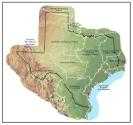
|
| texas |
It's impossible not to like this guy, and the admiration grows when you hear his business plan. His airline initially confined itself to Texas because the state is large enough to be able to fly many flights entirely within the state boundaries. That way he escaped interstate regulations and demonstrated enormous cost savings from not having to comply with all the federal red tape. Eventually, many hampering rules had to be repealed after competitors started to complain and lobby. Another feature of past success was the ability to respond to insider gossip in the oil industry since airlines burn hundreds of millions of gallons of gasoline. Much of the profitability of an airline depends on accurately predicting the direction of oil prices, and hedging against them. By confining himself to short trips, Kelleher could concentrate on flying only one model of airplane, thus reducing training and maintenance costs. There are advantages to being a Texas airline.
But there is a notorious boisterousness to it all. The employees are encouraged to behave like members of a college fraternity party, described as "dropping the mask and behaving naturally", although the parents of teenagers would have other descriptions. Employees are expected to have fun while they work. No frills, but lot's of fun, and cheap. Really cheap. Philadelphia is in for a big dose of success, and lots of fun flying everywhere they never flew before, welcoming the whole country to visit, and y' all come back, hear? The city is told to expect soon to be acting and talking like l'll Texas on Delaware. Maybe we must prepare for a rise in the incidence of lung cancer, too, if young people go too far in imitating his flouting of political correctness. At one point in this in-your-face talk, he came down into the audience and bummed a pack of cigarettes. Haw, haw, haw.
It's, therefore, some surprise to learn this man is a lawyer, honors graduate of New York University Law School. And even more of a surprise to learn he was brought up in Audubon, New Jersey, graduating in the class of 1949 from Haddon Heights High School. He must once have absorbed an inward dose of Philadelphia culture, and even a fair dose of New York City, but it didn't change the outward Texan a whit. What seem to be some dominant genes, conceived on Philadelphia's Spruce Street perhaps but nurtured on the hot prairies, are now coming back home. Uniquenesses in many generations of immigrants have been dissolved by Philadelphia's cultural waters, but this may be the first time we have contended with the earnest bravado of Texas. Come to think of it, maybe it's a wake-up call we need to hear. Corrupt and contented, pay to play, borrow to spend -- all of these jingles have perhaps been whistled a little too often around here.
Convention Center

|
| Convention Center |
A substantial grant from the Pew Foundation initially funded The Greater Philadelphia Tourism Marketing Corporation but expected other more permanent funding sources to materialize by the end of three years. The funding source turned out to be a 1% tax on hotel rooms since hotels were rather easily convinced that an increase of tourism to Philadelphia would benefit them. There is every reason to think the whole idea was a good one, effectively implemented. However, it probably was not completely appreciated that this hotel tax would provide a measurement, a public thermometer, of the ebb and flow of tourists to the city. Thus, the devastating effect of labor troubles at the Convention Center upon the hospitality industry became quite undeniable, hence became potent political medicine in the municipal political campaigns. Tax revenues from this specified source were down, and the causes became hard to deny. Philadelphia has long been a strong union town, but it will be decades before the public forgets the behavior of the carpenter's union or the economic havoc it inflicted on the second largest industry in the region. Even the most committed liberal ideologue would have to admit that the members of the carpenters union would achieve greater personal income by moderating their wage demands and restraining their work rules, working more hours at somewhat lower hourly wages. The argument has long smoldered whether Philadelphia is the most American of American cities, or whether it is the most European of American cities. A case can be made, either way. This labor dispute may not settle the basic question, but it will certainly shift the city's image toward one direction or the other because this matter is not one of architecture, cuisine or speech patterns. It's a matter of the city's belief system.
The Birthplace of Radio

|
| WCOJ Radio |
We should all be grateful to Lloyd B. Roach, the President of WCOJ radio station inWest Chester PA, for researching and popularizing the history of American radio broadcasting. From him, we learn that public radio had its origin in Philadelphia, during the early 1920s. While it is true that KDKA in Pittsburgh can claim to be the oldest radio station around, there are those who say that radio as we now know it had its origins on the rooftops of four department stores clustered at Eighth and Market Streets, busily announcing what was on sale today, and helping draw teeming crowds to that center of dry goods merchandising that many of us are still alive to remember. Strawbridge and Clothier, Lits, and Gimbels were on three corners of the intersection, Snellenbergs was a block up Market, and John Wanamaker's big store was a couple of block still further West. In those early days, names like David Sarnoff and Arthur Atwater Kent were the equivalents of Bill Gates and Andy Grove today. Eighty years before the dot-com revolution, the public radio revolution made zillionaires of kids who had been working in cigar stores a year or two earlier, and not merely communication but world culture was forever changed. And in both cases, a sudden drop in the stock market wiped out a lot of them, although a few survived.
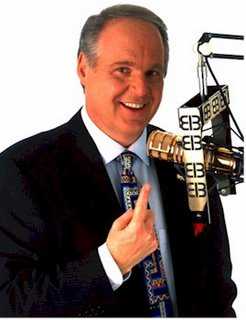
|
| Rush Limbaugh |
It seems you ought to know about "Absorption" which is some kind of electrical phenomenon whereby a lot of microwave and computer traffic wipes out the AM (as opposed to FM) signals in big cities. Because everyone knows that the political right wing likes the red expanses of the map, while the left or liberal way of thinking is concentrated in cities, hence blue parts of the map, the overall effect is that AM radio is more a phenomenon of the exurbs, rural districts, and highways. And a further consequence is that call-in radio is heavily right wing in its audience, hence programs, Rush Limbaugh and all that. Because of the innate remorselessness of paid political consultants, it doesn't take long for politicians to recognize that getting rid of absorption would make radio call-in shows more likely to reach urban liberals. We can't have that, or we must have that, depending on the bias of the observer, and hence a sort of radio signal called XM is something we predict will be made forbidden or made mandatory, because it makes urban liberal talk radio possible again. The beauty of this cutthroat battle is that it is so obscure that the public won't notice its significance until it happens, and when it does there will be few fingerprints on it. Commentators will rattle on about shifting tides of opinion when in fact some manipulation of the Federal Communications Act or the local broadcast licensing regulations by people who know very well what they are doing is what has gone on. Heh, heh.
To get back to Philadelphia, the dreary hulks which now stand where the department stores once stood are a reminder that shopping centers, or collections of strip malls, have killed the department store. Two phenomena are at work here. The brand name which gave credibility and comfort to the department stores' reputation is being replaced by national brand names with local franchises., and national advertising rather than regional. That might have been bearable if the department stores had not placed so much unwise reliance on the concept of the "full-service operation". If you try to sell everything in one-stop shopping, as for example selling pianos as well as perfume, some of the things you include are going to be losers. Consequently, the perfumes on which you made your profits will have to become more expensive to pay for the losses on pianos, and eventually, the perfume specialty stores will destroy your profit center, ruining the whole full-service business. This phenomenon, by the way, is beginning to eat away at the economics of hospitals as well.
Priceless Art as Mass Entertainment
The Philadelphia Museum of Art recently had a special exhibition of paintings by Edouard Manet, with a heavy dose of Claude Monet plus a few others. A moment's reflection demonstrates the enormous undertaking it must be to assemble a hundred valuable paintings from 60 different museums and owners, arrange for permissions, negotiate insurance and shipping costs, debate the best display, lighting and arrangement, instruct the guides, print the brochures, hype the announcement hype, and probably a thousand other details of making this all come out right. Although a lot cheaper to assemble this show and move it around to various cities, than it would be to have thousands of Americans travel to Europe to see the paintings there, nevertheless it looks expensive. Half a dozen major foundations donated money for this effort, and the ticket price is not insignificant. When you are all done, however, you have seen a display that no one could possibly see privately, all in one afternoon, with an elegant lunch on the premises in air-conditioned splendor, accompanied by a small orchestral group in the background. The show is resident for three months, less two weeks for setup and travel, so four cities can collaborate on four traveling exhibits each year. Somewhere, there must be a very large staff devoting full time to keeping these exhibits in constant movement; probably several cycles are going at once. This is big business, and filling that big museum every day for three months implies that many of the visitors are from outside Philadelphia. After you go, at least you can tell Manet from Monet, you've had a taste of the huge Museum that makes you want to come back some day, and you have seen Philadelphia's best view, right where Rocky ran up the steps.
Our guide was well trained and entertaining, and knew all about horizons, prompting some deep, deep thought about horizons. The Dutch school of painters usually put the horizon down near the bottom of the painting, showing off the billowing grey clouds so characteristic of the European coast near the North Sea. By contrast, the French impressionists went down to the sunny Mediterranean coast, where the bright sunlight forces you to look down at the ground. So the horizon of painting, the line where the sky meets the ground, is low in northern paintings, but high in scenes of the Riviera, representing in both cases the typical viewer?s image of the scene. No doubt, some painters deliberately reversed the normal location of the horizon, in order to create the unconscious effect on the viewer that something was somehow wrong.
This little lesson has practical utility for those of us who take amateur snapshots. The rule for photographers is to throw the horizon into either the top third or the bottom third of the viewfinder. Avoid putting the dumb horizon right in the center of the photo. Since most cameras nowadays have an automatic exposure meter, if you get it wrong the meter will concentrate on the sky, underexpose the subject below the sky, and give you a puzzling black silhouette instead of a picture of your girlfriend.
Returning to the reality of the Art Museum, it sits on top of a little mountain --Fairer Mount-- that William Penn once considered as a place to put his home. It was later the site of a reservoir, with the famous pumping station and water works down the hill on the edge of the Schuylkill. Now, this Parthenon is an easy place to reach and to park, while the world's art is placed before you. The Russian Tsar in his Hermitage, and the Archduke in his Viennese palace never had it as easy as this.
Whigs, Slaves, and Tariffs
At the time of the Revolution, Philadelphia had 25-30,000 residents. Although then it was the largest city in North America, today it would compare with a small suburb. By the time of the 1800 census, Philadelphia had 67,000 residents. The Capitol was moving to Washington; Philadelphia's fifteen minutes of fame were over. Still, the city had only achieved the size of what we would now call a one-industry town. The fifty state capitals today are about that size; look there if you want to observe the mentality and social structure of one-industry towns.
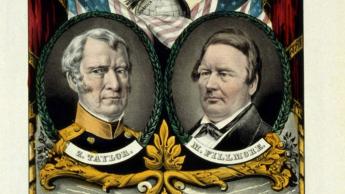
|
| Zachary Taylor, His vice president, Millard Fillmore |
But by the 1850 census, Philadelphia's population was 408,000, 30% foreign-born. That's an entirely different environment. By the time of the Civil War, Philadelphia was a real city, with real growing pains. The rest of the country had similar problems, with different details. The voting franchise was extended beyond land-owning taxpayers in 1838, mostly affecting backwoodsmen who had immigrated a century earlier. In Philadelphia and other seaboard cities, however, the franchise was extended to factory workers from foreign cultures, and the result was natives. Street riots calmed down into politics but transformed into politics. "Know Nothings." a Nativity political party was named for its pledge to say "I know nothing" when the police arrived. (Philadelphia's 1854 city-county consolidation can be traced in part to a need to get local police forces to follow orders.) The extension of the franchise could be traced back to the 1828 election of Andrew Jackson, and it could be traced forward to the creation of modern political parties. The founding fathers supposed that leaders would be elected on the basis of deference, with a town like Philadelphia run by the Biddle's, Ingersoll's and Wharton's. And in fact, that was mostly how it was until 1828. After that, it was just a matter of time before the only thing that counted was the only thing that was being counted - votes. Since that time, business and social elites have from time to time rebelled with what they called "reform movements." But as Adlai Stevenson wryly remarked, it takes a majority to win. Election of elites is always and everywhere a rarity.
The critical moment for Philadelphia and the Republican Party came in a smoke-filled room in the 1850s when the anti-slavery movement was united with the Nativity Know-Nothing Party. Both of these parties held their national presidential convention in Philadelphia in 1856.In the background was dissolution of the Whig Party, and on the table was the protectionist tariff. The Whigs were an idealistic group, and Lincoln had been a fervent Whig. Their theme was building canals, roads, railroads and other features designed to promote prosperity by enhancing the economic infrastructure. The weakness of the Whigs lay in the way their approach usually raised taxes. The Know Nothings were far from idealistic; their weakness lay in the general fear they were promoting class warfare.
Someone proposed that the common ground between the two splinter parties lay in advocating the protective tariff. Of course, that's another bad idea, but as a vote-getter it was wonderful. It united the workers with the business owners, potentially enriching both of them. More importantly, it reassured the idealistic Whigs and abolitionists that class warfare could be avoided. Freeing the slaves, conversely, would appeal to businesses and workers who compete with slaves.
A hundred years earlier, Adam Smith had demonstrated that artificially raising prices impoverishes consumers, and the Wealth of Nations is thus always injured by tariffs. But anyway, on to the Wigwam, and on to Fort Sumpter.
Alexander Hamilton, Celebrity
 He had the kind of taudry private life and flashy public behavior that Philadelphia will only tolerate in aristocrats, sometimes. 
|
It comes as a surprise that most of the serious, important things Alexander Hamilton did for his country were done in Philadelphia, while he lived at 79 South 3rd Street. That surprises because much of his more colorful behavior took place elsewhere. He was born on a fly-speck Caribbean island, the "bastard brat of a Scots peddler" in John Adams' exaggerated view, was orphaned and had to support himself after age 13. The orphan then fought his way to Kings College (now Columbia University) in New York in spite of hoping to go to Princeton, and has been celebrated ever since by Columbia University as a son of New York. He did found the Bank of New York, and he did marry the daughter of a New York patroon, and he was the head of the New York political delegation. As you can see in the statuary collection at the Constitution Center, he was a funny-looking little elf with a long pointed nose, frequently calling attention to himself with hyperkinetic behavior. Even as the legitimate father of eight children, Hamilton had some overly close associations with other men's wives, probably including his wife's sister. Nevertheless, he earned the affection of the stiff and solemn General Washington, probably through a gift of gab and skill getting things done, while outwardly acting as court jester in a difficult and dangerous guerilla war. There is a famous story of his shaking loose from the headquarters staff and fighting in the line at Yorktown, where he insolently stood on the parapet before the British enemy troops, performing the manual of arms. Instead of using him for target practice, the British troops applauded his audacity. Harboring no such illusions, Aaron Burr later killed him in a duel as everyone knows; it was not his first such challenge.

|
| Alexander Hamilton |
Columbia University President Nicholas Murray Butler told other stories of celeb behavior to reinforce Hamilton's New York flavor. But in the clutch, General Washington learned he could always trust Hamilton, who wrote many of his letters for him and acted as his reliable spymaster. When the first President faced signing or not signing the fateful bill to create the National Bank, a perplexed Washington had to choose between: the violent opposition of Thomas Jefferson and James Madison, or the bewildering complexity of Alexander Hamilton's reasoning in arcane economics. On the one hand, there was the simple principle that owing money was seemingly always evil; on the other was the undeniable truth that for every debit created, you create a balancing credit somewhere. Washington ultimately chose to go with Hamilton, whose reasonings he likely didn't understand very well. If you doubt the difficulty, try reading Hamilton's Report on the Bank, written to persuade the nation and its first President of the soundness of his ideas. And then consider the violence of even present-day arguments about such "supply side" economics.
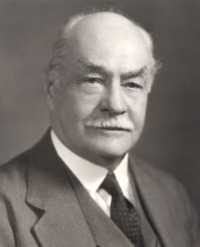
|
| Nicholas Murray Butler |
All of these momentous events happened in Philadelphia at places now easily visited in a morning's stroll. But Hamilton's image as a Philadelphian, doing great things in and for Philadelphia, was forever tarnished at one single dinner he hosted. Jefferson and Madison, his political opponents but his guests, were persuaded to provide Virginia's votes for the federal takeover of state Revolutionary War debts, in return for offering New York's votes for moving the nation's capital to the banks of the Potomac. True, Pennsylvania allowed itself to be pacified with having the capital remain here for ten years while the southern swamps were being drained. But it was Hamilton who cooked up this deal and sold it to the other vote swappers. Philadelphia felt it was entitled to the capital without needing to ask, felt that Hamilton was deliberately under-counting Pennsylvania's war debts, and this city has never appreciated the insolent idea that its entitlements were forever in the hands of wine-swilling hustlers. As the economic consequences of this backroom deal became evident during the 19th Century, it was increasingly unlikely that Philadelphia would lionize the memory of the man responsible for it. Let New York claim him, if it likes that sort of thing. When Albert Gallatin, who was more or less a Pennsylvania home town boy, attacked Hamilton as a person, as a banker, and as a Federalist -- he had a fairly easy time persuading Philadelphians that this needle-nosed philanderer was an embarrassment best forgotten.
REFERENCES
| Alexander Hamilton Ron Chernow ISBN:978-0-14-303475-9 | Amazon |
After the Convention:Hamilton and Madison
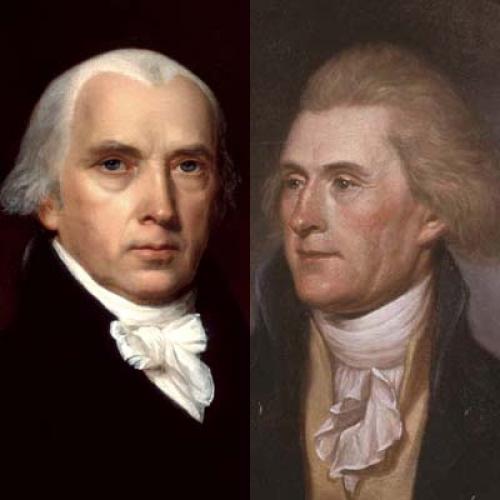
|
| Signers |
The Federalist Papers were written by three founding fathers after the Constitution had been completed and adopted by the Convention. Detecting hesitation in New York, the aim was for publication in New York newspapers to persuade that wavering State to ratify the proposal. It is natural that The Federalist was composed of arguments most persuasive to New York, putting less stress on matters of concern to other national regions. This narrow focus may explain the close cooperation of Hamilton and Madison, who must surely have suppressed some latent concerns in order to present a unified position. In view of how much emphasis the courts have placed on the original intent of almost every word in the Constitution, it seems a pity that no one has attempted to reconcile the words of the principal explanatory documents with the hostile disagreements of their two main authors, almost as soon as the Constitution came into action. Perhaps the psychological hangups would be more convincingly dissected by playwrights and poets, than historians.
John Jay wrote five of the essays, mostly concerned with foreign relations; his presence here highlights the historical likelihood that Jay might have been the one who first voiced the idea of replacing the Articles of Confederation. At least, he seems to have been first to carry the idea of a general convention for that purpose to George Washington (in a March 1786 letter). The remaining essays of The Federalist were written under the pen name of Publius by Alexander Hamilton and James Madison, both of whom had a strong enough hand in crafting the Constitution, but who quickly became absolutely dominant figures in the two central political factions after the Constitution was actually in operation. And their eagerness to be central is itself telling. They were passing from a stage of pleasing George Washington with his favorite project, into furthering a platform for launching their own emerging agendas. It is true that Madison's Federalist essays were mainly concerned with relations between the several states, while Hamilton concentrated on the powers of the various branches of government. As matters evolved, Hamilton soon displayed a sharper focus on building a powerful nation; Madison scarcely looked beyond the strategies of internal political power except to see clearly that Hamilton was going to get in the way. These two areas are not necessarily incompatible. But it is nevertheless striking that two such relentlessly driven men could work together to achieve the same set of rules for the game they were about to play so unflinchingly. Thomas Jefferson had been in France during the Constitutional Convention. It was he who was most dissatisfied with the resulting concentration of power in the Executive Branch, but Madison eagerly became the most active agent for forming the anti-Federalist party, with all its hints that Washington was too senile to know the difference between a President and a King. Washington abruptly cut him off and never spoke to Madison after the drift of his opinions became undeniable. Today, it is common to slur politicians for pandering to lobbyists and special interests, but that presents only weak competition with the personal forces shaping leadership opinion, chief among them being loyalty to, and perceived disloyalty from, close political associates.
As a curious thing, both Hamilton and Madison were short and elfin, and both relied for influence heavily on their ability to influence the mind of
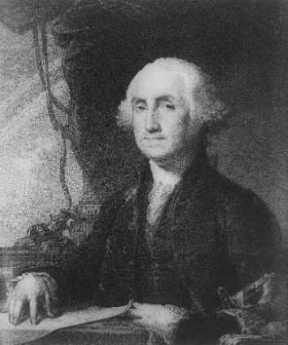
|
| George Washington |
George Washington, who projected the power and manner of a large formidable athlete. Washington had no strong inclination to run things and, once elected, no particular agenda except to preside in a way that would meet general approval. He had mainly wanted a new form of government so the country could defend itself, and pay its soldiers. Madison was a scholar of political history and a master manipulator of legislative bodies, while Hamilton's role was to supply practically unlimited administrative energy. Washington was good at positioning himself as the decider of everything important; somehow, everybody needed his approval. On the other hand, both Madison and Hamilton were immensely ambitious and needed Washington's approval. This system of puppy dogs bringing the Master a bone worked for a long while, and then it stopped working. Washington was very displeased.
The difference between these two short men immediately appeared in the way they chose a role to play. Madison the Virginian chose to dominate the legislative process as the leader of the largest state delegation within the

|
| Alexander Hamilton |
House of Representatives, in those days the dominant legislative chamber. Hamilton sought to be Secretary of the Treasury, in those days the largest and most powerful department of the executive branch. It's now a familiar pattern: one wanted to form policy through dominating the board of directors, while the manager wanted to run things his way, even if that led in a different direction. Both of them knew they were setting the pattern for the future, and each of them pushed his ideas as far as they would go. Essentially, this could go on until Washington roused himself.
After a short time in office, Hamilton wrote four historic papers about two general goals: a modern financial system, and a modern economy. For the first goal, he wanted a dominant national currency with mint to produce it and a bank to control it. Second, he also wanted the country to switch from an agricultural base to a manufacturing one. You could even say he really wanted only one thing, a national switch to manufacturing, with the necessary financial apparatus to support it. Essentially, Hamilton was the first influential American to recognize the power of the Industrial Revolution which began in England at much the same time as the American Revolution. Hamilton was swept up in dreams of its potential for America, and while puzzled -- as we continue to be today -- about some of its sources, became convinced that the secrets lay in the economic theories of
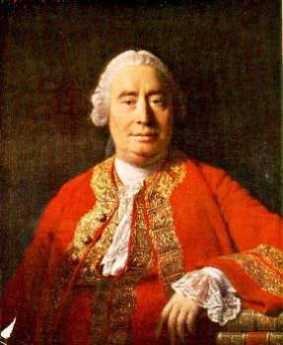
|
| David Hume |
David Hume and Adam Smith in Scotland, and of Necker in France. Impetuous Hamilton saw that Time was the essence of opportunity; we quickly needed to gather the war debts of the various states into the national treasury, we quickly needed a bank to hold them, and a mint to make more money quickly as liquidity was needed. It seemed childishly obvious to an impatient Hamilton that manufacturing had a larger profit margin than agricultural products did; it was obvious, absolutely obvious, that this approach would inspire huge wealth for the new nation.
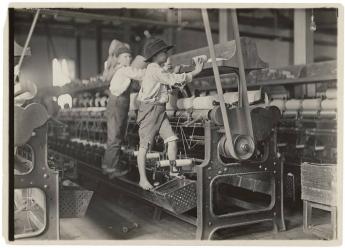
|
| Industrial Revolution |
Well, to someone like Madison who was incredulous that any gentleman would think manufacturing was a respectable way of life, what was truly obvious was that Hamilton must be grabbing control of the nation's money to put it all under his own control. He must want to be king; we had just got rid of kings. Furthermore, Hamilton was all over the place with schemes and deals; you can't trust such a person. In fact, it takes a schemer to know another schemer at sight, even when the nature of the scheme was unclear. Madison and Jefferson couldn't understand how anyone could look at the vast expanses of the open continent stretching to the Pacific without recognizing in this must lie the nation's true destiny. Why would you fiddle with pots and pans when with the same effort and daring you could rule a plantation and watch it bloom? If anyone had used modern business jargon like "Win, win strategy", the Virginian might well have snorted back, "When you say that to me, friend, smile."
Parliament Provokes a Revolution
In some medical circles, it is postulated that George III was psychotic, possibly suffering from an inherited rare condition called porphyria.

|
| Magna Carta |
That's pretty conjectural, but it is certainly true that his mother egged him on to be a real king, a real force reversing that steady decline in the Monarchy's personal power which began with the Magna Carta. By the time in question, however, so much power had already gravitated into the hands of Parliament that the King could not act in any major way without their consent. Even today, Cabinet Ministers are spoken of as King's ministers but are in fact appointed by leaders of the majority party in Parliament. Some in Parliament, like Edmund Burke, were almost persuasive in resisting the Ministry, urging colleagues to seek reconciliation with the colonies. George III did still retain the power to appoint his favorites to important positions and used this patronage extensively to control the country. Political party chieftains, on the other hand, retained and retain today the power to nominate the party candidate for Parliament in any particular district. The leadership thus selects the members of Parliament, who can, in turn, overturn the leadership only if they dare. Real decisions were largely in the hands of party chieftains, but perhaps to some extent, the Crown, depending on the Monarch's shrewdness in distributing patronage among the party chieftains.
Across thousands of miles of dangerous ocean, the English colonies had changed from the weedy wilderness in the Sixteenth century, into thriving and prosperous small civilizations in the early Eighteenth. Transatlantic communication did not substantially improve in that interval, but colonial population grew to over a million, many of them native-born in the colonies, with increasingly large numbers of immigrants from other nations. Loyalty to the Monarch inevitably declined. True, they spoke English, revered England, but many urgent local issues were difficult to administer at such a distance, encouraging a mentality of self-governance. France, by now at war with England on the Continent, operated on a grand plan of interior encirclement, from Quebec and and Great Lakes, down the Mississippi to New Orleans. The English coastal settlers needed peace with the Indians of the interior;
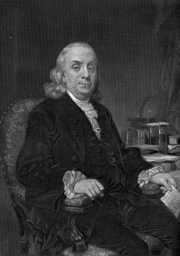
|
| Benjamin Franklin |
the French did not scruple to stir up massacres and Indian warfare. All wars are expensive, the French and Indian war particularly so. After defeating the French, the British were put to the protracted expense of building frontier defenses. Although the British were anxious to attract English-speaking colonists who would defend America for England, it was obvious some of the settlers were becoming very rich. Surely these people could not object to paying taxes for their own defense. In retrospect, it seems remarkably naive of the British to think it was that easy. Americans did not want to pay taxes because they did not want to pay taxes. They settled on the stance of "No taxation without representation" and like Franklin and the Penn family, many really believed in it. That slogan was particularly effective after it became apparent that Parliament wasn't about to give remote colonists reciprocal power in Parliament to interfere with affairs in the British Isles. With Parliament adamantly refusing to dilute its own power, "No taxation without representation" was a neat rhetorical box which meant, "No taxation." Contemporary English historians now throw up their hands in despair that so few members of George III's government had Burke's vision or even the normal wiles of diplomacy. But that understates the hidden political agenda. Parliament just pushed ahead with fairly nominal taxes, but they did so to curtail the independence of colonial legislatures.
The Stamp Act of 1764. It could be argued that Navigation Acts nothing new; earlier versions were first passed in 1651, intended to thwart Dutch trading. They prohibited foreign trade with the British home islands. After fifty years in 1703 similar restraints were extended to trade with the colonies, particularly molasses in the Caribbean area. No outcry was made as these restraints, aimed at retaining the Britishness of British colonies, were occasionally modified and extended over the next sixty years.
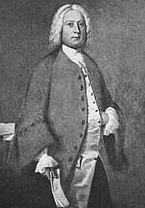
|
| Thomas Penn |
After a century in 1764, however, the Stamp Act was passed, producing modest revenue but imposing a crippling set of headaches by requiring special papers to transact private business. The uproar was enormous and legitimate, focused mostly on the tangle of red tape needlessly imposed. By shifting taxation from trade to paperwork transactions, suspicions were plausible that the Ministry was scheming something obscure. The Stamp Act was hastily repealed, even before Benjamin Franklin and Thomas Penn recognized its unpopularity and were still to some extent defending it in 1766. Franklin apparently saw the Stamp Act as an opportunity to appoint his friends as stamp agents. Local uproar in Pennsylvania was apparently orchestrated by William Bradford, who in addition to having been Franklin's former competitor in the printing business, was the owner of the London Coffee House at Front and Market. No other prominent colonial leader seems to have been involved in the agitation, and it is remotely conceivable that uproar originated with Bradford alone. More likely, Bradford was merely an opportunist in a genuinely popular uprising. With the familiar maneuvering characteristic of politicians, Franklin took popular credit for defeating the Stamp Act with some skillful criticism of it, while John Penn gained credit with the King for representing Pennsylvania's relative calm about it, compared with other colonies. In Pennsylvania at least, the uproar quickly subsided after the repeal of the Act.
The Townshend Navigation Acts of 1768.In 1766 the Grenville Ministry was replaced by that of Rockingham, then soon by Pitt, who were anxious to disavow the unpopular Stamp Act, but nevertheless needed colonial revenue, and needed a few unpleasant laws to prove that Parliament could not be intimidated by colonial squawking.

|
| Charles Townshend |
Charles Townshend, the brilliant, vindictive, Chancellor of the Exchequer then proposed taxes on glass, painter's lead, paper, painter's colors, and tea. The underlying political purpose of these taxes was to provide revenue for paying British colonial administrators directly, rather than depend on the Colonial legislatures to pay them. The Legislatures had long played a game of withholding payments, sometimes even the salaries of Judges and Royal Governors, when they disapproved of projects devised in London. The very predictable uproar provoked by the Townshend Acts propelled John Dickinson into prominence with a pamphlet called Letters From a Pennsylvania Farmer, which popularized the idea of "nonimportation", essentially a boycott of British products. Unintentional nonimportation was in fact the effect of the laws, clogging the ports with paralyzed trade goods. Rather than Dickinson's lofty principles, a little-noticed act of 1764, prohibiting the printing of paper money, paralyzed trade. There simply was not enough available coinage to pay these taxes, which finally pushed the primitive transaction system beyond its capabilities. From the viewpoint of modern economics, a heavy unbalance between imports and exports could not be rebalanced by flows of capital. The disastrous Townshend Acts were mostly repealed in 1770, but the British government was getting in deeper and deeper, discrediting itself at every turn. To retreat but still save face, they repealed all the taxes except the one on tea.
The Tea Act of 1772. To a certain degree, the uproar over the face-saving tax modifications on tea was a pretext for confused but radical colonists who were spoiling for a fight about difficulties they tended to personalize. The act actually lowered the effective taxes on tea, and at first Whig radicals were hard put to find a reason for outrage about lowering the price of tea. However, Bradford and his London Coffee House cronies (Mifflin, Thomson) were imaginative, and soon stampeded a mob scene in Philadelphia, where for a time the populace had seen nothing to get worked up over. Rush and Dickinson joined the chorus; the public feeling was stirred to a frenzy not easily reversed.
The really substantive issues involved were created by several years of Townshend Duties and other forms of import restriction. Laws to ensure the Britishness of British colonies created pleasant opportunities for colonial artisans and craftsmen, difficult hardships for importers. But these dislocations, whether welcome or unwelcome, firmly exposed the underlying truth that they caused all colonists to pay higher prices for goods. Adam Smith was not to publish his Wealth of Nations until 1776, so in this case the proof preceded the theory. The colonists were effectively asked to pay higher prices for everything, in order to increase Britishness and to billet soldiers they could not command. Once that cat was out of the bag, attitudes could never be the same. On the English side of the ocean, the question was framed as colonist unwillingness to contribute to the cost of their own defenses. The two slanted perceptions hardened to the point where arrogance confronted defiance, suggesting combat to both of them.
In the case of tea, taxes and import restrictions were intended to promote English tea over Dutch tea; in fact, they stimulated smuggling. Smuggling grew to a point that vast quantities of tea were stranded in the warehouses of the British East India Company, and trade balances of the British Empire were undermined. By reducing taxes, Parliament made East India tea cheaper than smuggled tea. Going perhaps one step too far, middle-men in the tea import business were cut out of the loop by appointing favored direct agents. In Philadelphia, those were Henry Drinker and Thomas Wharton. Bradford and his group immediately set about intimidating these merchants with threats to burn them out, and the sea captains who worked for them, with threats of tar and feathers. The age of Reason was leaving Reason behind.
Reflections on Swensen
A. Techniques of rebalancing. Three directions to take this, occur to me.
1. Purchase 60/40 mutual funds and let them do the rebalancing. This would offhand seem the easiest way to do it, but what are the results? Do you think it would be practical to construct a 60/40 mutual fund by combining and rebalancing a world-wide index fund with a bond fund? Since bond funds are dubious, how about a mutual fund that contained the equity index fund and did its own bond juggling? How about a family of funds, mixing 50/50, 55/45, 60/40, 65/35, 70/30, 75/25. 80/20, as the investor chooses? Since this would probably amount to a pool that sold virtual shares, almost any combination seems feasible. But is it legal? At one time the fund of funds was illegal for whatever reason; possibly Vanguard has a right to object to such secondary use of its funds. By getting a fund together, there should be enough volume to consider real-time rebalancing. When you consider doing it for yourself, the fund approach seems increasingly attractive.
2. Establish two brokerage accounts at Vanguard, one for equities and one for bonds, each of which is linked to its own separate money market sweep fund. Monthly rebalancing should be possible from the monthly statement, with the money market of one account purchasing shares of the other asset class as needed for rebalancing. A refinement of this might be to purchase shares of the "wrong" account and hold them until the capital-gains period has expired, then transfer to the "correct" account. I presume that transfers between two money-market accounts would be fairly simple, avoiding the perplexities of buying shares with one account but depositing them in another. Adjusting the order to reinvest dividends or not reinvest seems like a nice refinement, lessening the need to sell things.
3. Doing the whole business in Quicken. If you are thinking of doing this for clients, you might want to avoid the hazards of actually doing the transactions, simply sending the client a set of suggested monthly instructions to give to his broker or transact electronically. This might seem attractive to people running trust funds, who already carry the fiduciary hazard.
B. Selecting or deselecting, those companies who regularly rebalance their own debt/equity ratios. One of the important insights I get from Swensen is that company treasurers are often rebalancing in the opposite direction from the investors. That is, issuing more stock as their price/earnings ratio gets ridiculously high, buying back their stock when the price gets cheap. Not all companies do this, and those who do probably reduce their volatility considerably. If this is a really major reason for investors to rebalance in the other direction, then there may be a considerably reduced value in rebalancing companies that are doing it for you, and enhanced value in rebalancing the rest.
1. Since you don't know the intentions of a company, and anyway they may change treasurers without your knowledge, there is a need to find some surrogate for this activity. That's particularly true of companies that may only do it in one direction, and thereby alter the balance between raising equity capital and borrowing. Does the p/e ratio seem adequate to you as a surrogate? If not, is there a practical alternative?
2. I've been told that small companies borrow from banks, large companies issue bonds. Is this of any practical value to an investor? Are they a distinct asset class? After all, you can change your debt/equity ratio by adjusting either component, or you can reduce your total external capital requirement by using internally generated funds. Does this issue get you anywhere in selecting asset classes?
3. Companies or asset classes with a lot of volatility apparently give Swensen an opportunity to rebalance profitably. Aside from that, it is better for a company to have low volatility or high? If all companies got religion and did their own rebalancing, would there be any value in investors continuing to do it? To put it another way, just where is the value added by rebalancing? What signs would you look for, to decide that rebalancing is no longer cost effective?
C. Life insurance to reduce taxation. The October 18, 2006, Wall Street Journal observes that the IRS has issued clarifying instructions about using life insurance to reduce taxation; it also goes on to say that lawyers will charge you $10-20,000 to read them to you. But, apparently, it's ok to do this if you follow the rules. Essentially, life insurance investments compound internally without taxation and also escape estate taxes if you donate ownership of the policy to your heirs.
1. In the case of a spousal trust, the estate taxes are already waived, so one complexity is reduced or eliminated. There is no need to transfer ownership of the policy.
2. So the issue reduces itself to avoiding dividend and capital gains taxation, short and long. I gather they have not thought of the requirement to distribute all income from a spousal trust, so there is a chance some agent would balk at the technicality.
3. So, except for this risk, it's a simple trade-off between the fees for insurance versus the taxes saved, and I strongly suspect the fees are worse, so the issue isn't worth considering at all. But of course I don't know what the fees are, so I don't know the threshold level where tax avoidance becomes an important asset. Even the health issue is semi-answered since you could escape a physical exam by selecting an annuity life insurance; more fees to overcome, of course.
D The same Wall Street Journal includes a quotation from unknown research that calculating the dollar value weighting of mutual funds versus fund results demonstrates that all reasons for not buying-and-holding combined show a 1.5% penalty for all strategies other than buy/hold.
1. Therefore, the 0.5% advantage of rebalancing over buy/hold is actually a 2.0% advantage over the penalty for deviating. That's a more substantial argument that has so far been made for rebalancing, but needs to be re-examined to be sure the penalty is not actually hidden in the 0.5% claim, since if so that would convert it into a 1% loser strategy.
2. For no visible reason, broker-handled funds average 0.5% lower return than direct-buy funds. May I suggest some hidden kick-back has surfaced?
3. Low-volatility stocks seem to produce an 0.8% advantage over high-volatility stocks and a shocking 2.8% difference on a dollar-weighted basis, suggesting volatility makes investors lose their nerve in addition to the innately inferior performance. Is it reasonable to give them a neutral weighting in a portfolio?
The Jews in Colonial Philadelphia

|
| Haym Salomon |
The word Sephardi is derived from the Hebrew word for Spain, where Jews were a prominent part of the Arab community for several hundred years. The Christian monarchs Ferdinand and Isabella, regarding the Sephardim as pro-Arab, drove them out of Spain and Portugal in 1492. They scattered widely, and only a small portion eventually got to the Western hemisphere. It is also helpful to know that Askenazic is the Hebrew word for German since this other main branch of the religion did not emigrate to America until later in the Nineteenth century in response to the suppression following the 1848 Revolutions. There are some important differences in liturgy, and occasional episodes of bad feeling between the two Jewish groups, some of it kept alive by issues arising in Israel. Historically, the Sephardim have had a greater tendency to assimilate in local cultures, both generally and particularly in Philadelphia. However, the most prominent Jew in the American Revolutionary War was Haym Salomon, who was born in Poland.
On leaving Spain, many Sephardim had gone to Amsterdam, and from there to the Dutch colonies hat accounts for their presence in the Delaware Bay as part of the Dutch settlements which preceded William Penn's arrival. The British conquest of the Dutch accounts for their subsequent local disappearance. However, it paradoxically also accounts for an influx from Curacao and other Caribbean Dutch colonies conquered by the British, usually favoring New York as a place to settle. Presumably, Sephardic feelings about the English were cautious at best. When the British occupied New York in the early days of the American Revolution, many Sephardim fled to Philadelphia, but largely returned to New York after the end of the Revolution. There was thus a double process of filtering out those who were unsympathetic with the British, and those who were attracted by seeing what Philadelphia represented.
Records were poorly kept in those days, and in civil wars, there are often reasons to be vague about your sympathies and activities. We know that Haym Salomon came to Philadelphia in 1774, grew very rich in association with Robert Morris, but died in poverty after a few years, now lying in an unmarked grave. It is a little unclear how he became rich, although all merchants involved in shipping did a little privateering, often described as piracy by the victims. It is also unclear how he became suddenly poor, although speculators in currency and land often make serious misjudgments. Robert Morris is himself a prime example.
The matter becomes of greater interest when Haym Salomon is sometimes referred to as one of the main financiers of the Revolution. Partly because of the ease of counterfeiting with the primitive printing technology of the time, the British had forbidden the use of paper money in the colonies as part of the Townshend Acts. While understandable, it caused great pain to unbalanced trade partners, and metal coins quickly migrated back to England, almost paralyzing colonial economies for lack of cash to transact local business. It probably caused a different sort of a pain to Benjamin Franklin, who derived much of his income from printing the currency of New Jersey. In particular, it kept cargoes trapped in port for lack of payment, which the annoyed British merchants mistook as an implementation of John Dickinson's proposal for deliberate "non-importation". In any event, Jewish merchants and bankers were well situated to find ways around currency blockages, sometimes using precious gems as substitutes for specie, and utilizing informal family networks scattered around the world. In civil wars, guns have to be bought and paid for, legalities get swept aside. There is said to be evidence that our ambassador to France, Benjamin Franklin, utilized Salomon to translate the French loans he had negotiated into the munitions which colonials needed. There is incidentally reason to believe that the Rothschild family established its great wealth by similar commodity dealings at the time of the Battle of Waterloo.
Just what it was that went so drastically wrong for Haym Salomon at the conclusion of our war for independence has not yet been made clear, perhaps never will be. He may have been caught in the uproar over the worthless Continental currency, his ships may have been captured, or he may have been trapped by the land speculation which ruined Robert Morris. But those were rough, tough times. We have the word of those who should know, that Salomon's service was essential to our achievement of Independence.
BEA Monitors the Economy

|
| Global Interdependence Center |
The Global Interdependence Center meets at the Philadelphia Federal Reserve, organizing frequent seminars of outstanding quality about finance. This week, the speaker was Andrew Hodge, head of Profits Research, U.S. Department of Commerce, Bureau of Economic Analysis. Someone there once had the brilliant idea that aggregate national income was almost identical to Gross Domestic Product, so national income could be easily derived from tax information at the I.R.S. Originally probably seen as a way of verifying GDP statistics derived in other ways, aggregated income and profits look in some ways to be superior to the data coming from Wall Street earnings reports. As a leading indicator, it appears to be outstandingly effective in predicting an impending upswing in the business cycle, just about at the time everyone is getting discouraged about downswings. It's not so good at predicting market peaks.
Seems to be superior to Wall Street earnings reports in four ways. 1) Wall Street is not particularly useful in distinguishing domestic from foreign activity within multinational firms. 2) Wall Street reports generally attempt to avoid seasonality noise by comparing this month with this-month-last- year. If the market direction has changed during the past year, downswings may cancel upswings and such comparisons can be misleading. 3) at market inflection points, volatility gets exaggerated by firms going out of business at the bottom or businesses formed or expanded at the top. 4) Wall Street is only 40% of the economy. The other 60% has private ownership, particularly in S-corporations.
Out of studying the differences between the two types of statistics about the economy, it emerges that the tax-derived BEA statistics are quite good leading indicators, particularly when the economy is in a trough. They are sort of leading indicators of coming market peaks as well, but they lead by longer intervals. A lead of as long as a year isn't very useful as an indicator.
As the jargon goes, that's the take-home message. BEA data is pretty good at predicting market bottoms. But some interesting sidelights appear, as well.
Our economy is becoming less volatile, with milder cycles and less frequent ones. But national income is just as volatile as ever, particularly in stock prices. This would appear to be due to the steadily increasing proportion which is in the financial sector (or decreasing proportion in the manufacturing sector). The financial sector is characterized, worldwide and for a long time in the past, as having "sticky" wages and costs. With the cost side comparatively inert, profits become much more volatile. In the final analysis, the stock market becomes more volatile than the underlying economy.
A final conclusion is my own. If the best personal investment vehicle is a broad index fund representing the whole economy, then you had better be watching national statistics like the BEA, rather than sector statistics. At the moment, the problem is deciphering what's available on BEA.gov in tabular rather than graphics format.
Corrupt and Contented
In 1904, first in McClure's Magazine and then in the book Shame of the Cities, Lincoln Steffens described the root cause of Philadelphia's bad local politics as failure of the people to turn out to vote.
The Philadelphia machine isn't the best. It isn't sound, and I doubt if it would stand in New York or Chicago. The enduring strength of the typical American political machines is that it is a natural growth -- a sucker, but deep-rooted in the people. The New Yorkers vote for Tammany Hall. The Philadelphians do not vote; they are disfranchised, and their disfranchisement is one anchor of the foundation of the Philadelphia organization."
Just exactly a century later, a Republican member of the Legislature coined a phrase:
"You show me a hundred thousand dollars, and I'll show you a Pennsylvania judge."
Asked to comment, two Democratic politicians on the inside (although one is dead and the other is in Federal prison for embezzlement) replied:
"That isn't precisely so. The precise way of stating it is that, to be elected a judge has two basic requirements. The first is the approval of a local ward leader. The second is the expenditure of between seventy and hundred-thirty-thousand dollars. With these two requirements fulfilled, just about anyone can be elected judge, regardless of legal qualification."
Is it a mystery why we have a malpractice crisis? Other explanations are offered, but this one, the system of "elected" judges, should be examined first. It's a slightly worse system than appointing them. Someday, someone will discover why state courts are much more corrupt than federal ones. Is the court system getting worse from the bottom up? Or getting better from the top down?
Economics of La Cosa Nostra
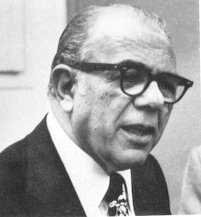
|
| Angelo Bruno |
During all of the reign of Angelo Bruno, it was a common street opinion that The Organization tried to stay away from drugs, prostitution and shooting anybody except other mobsters. Some of that attitude is found in the scene of the movie The Godfather where a neophyte going to his first killing is instructed to "Watch out for those goddam innocent bystanders". It was okay to bribe the police, not okay to annoy them. Counterfeiting and kidnapping were big no-no's, even though counterfeiting was a core activity for the ancestral Mafia in Western Sicily during the Nineteenth century.
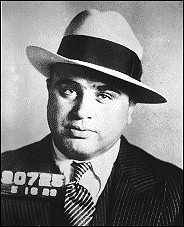
|
| Al Capone |
According to Robert Simone's book, the Philadelphia mob was mainly enriched by loan sharking. There are a lot of people who suddenly need cash desperately and can't get it quickly from banks. Simone himself was a compulsive gambler and frequently was in urgent need of money, either to throw it away or pay it back. Other people get caught in some illegal activity and suddenly need bail money to stay out of prison or up-front money for a lawyer. Or whatever. The Philadelphia mob had a reputation for being able to loan amounts of fifty or a hundred thousand dollars in response to a phone call, with home delivery of the money in fifteen minutes. For this, they would charge interest in the range of three percent a week, well above the usury limit, but probably not greatly out of proportion to the risk of loss. The police have little interest in transactions between willing parties, at least until the borrower fails to pay it back. Even at that point, it becomes a question of whether kneecaps will actually get broken, or baseball bats actually come in contact with skulls. Probably not very often, because the threat seems a credible one.
To run such a business requires large amounts of cash, hidden in safes or bricked up in walls. From this comes theft or attempted theft, with violent defense measures that often don't concern the police, much, unless those aforementioned bystanders get injured. Sometimes couriers get tempted to make unscheduled detours, but the police are fairly tolerant of informal restitution efforts. All in all, it's a nice clean illegal business.
An interesting sidelight is income tax evasion. It's entirely possible that The Organization would be willing to pay taxes if it could be done without filling out all those forms. Restaurants, bars, and market stalls can be run as a way to launder money and yet pay tax on it. But boys will be boys, and no doubt the IRS has, or had, some legitimate concerns. For years I felt the government was over-reaching when it jailed Al Capone for income tax evasion, after being unable, however, convinced it may have been, to convict him of overtly illegal activities. That's one side of it. But if you envision these organizations with millions of dollars in cash hidden away, it's easy to imagine them extending invisible credit to their associates for services rendered but not yet paid out and, of course, untaxed. Calling for such money on demand is not much different from having it in a bank. If appreciable amounts of that circumvention go on, the Internal Revenue Service really might have a grievance. Its image would be improved by demonstrating it is pursuing a named crime rather than a pretext to jail someone it doesn't like. Legislation could surely be devised which more carefully specified such illegalities. It might then be possible to bring an end to the appearance of putting people in jail for merely enjoying an ornate lifestyle. People who, almost by definition, cannot be proven to have committed a crime.
Insuring the Uninsured is Not Entirely a Health Issue
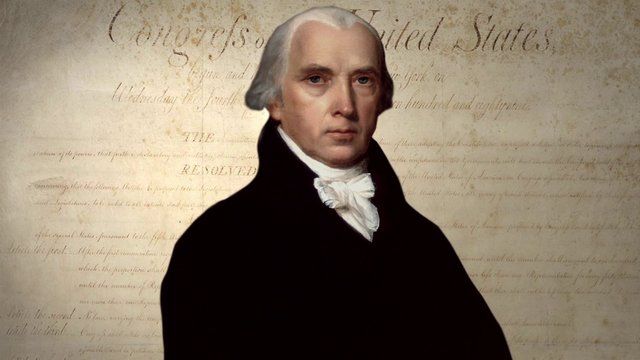
|
| James Madison |
shrewdly observed that people could and would restrain state taxation by moving to a neighboring state. The founding fathers never contemplated health insurance or Medicaid, of course, but the same principle applies there in reverse. If one state gets too generous with health and welfare benefits, people in neighboring states will nowadays hear of it and get on a bus to relocate advantageously. A flood of new low-income citizens may or may not be what a particular state wants, depending on local economic conditions.
For example during the great depression of the 1930s,
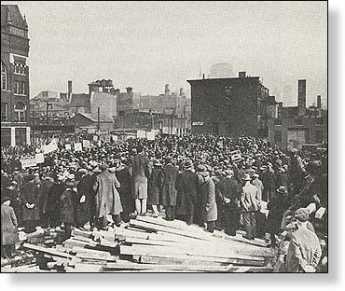
|
| The Great Depression |
Unemployment was so widespread that no state dared attract still more of it with generous welfare benefits. On the other hand, during the recovery period that followed World War II, the industrial northern states definitely did attract cheap labor from the southern states, using better health care, freely available, along with better unemployment benefits. In each case, employers alternate between wanting cheap labor or low taxes, while labor representatives relax or toughen their resistance to the cheap competition. Politicians are always looking for the argument that carries the most votes. If you want to understand the persistence of employer-based health insurance alongside unobtainable health insurance for others, look into this trio of motivations.
While it's true state legislatures must tend to the infrastructure, crime conditions and education, they can in the main be regarded as debating societies between employers and labor. There is some, but not much, the difference between Republicans and Democrats on the Medicaid issue. A Democratic Governor will welcome an influx of low-income voters who will normally vote for his party, but labor unions will soon remind him that enough is enough. A Republican Governor will gladly supply cheap labor for the state's employers until rising taxes bring an end to his support. Since the financial stability of the local hospital can be badly jarred by the instability of Medicaid payments, doctors soon get annoyed with the misalignment between state motives and the welfare of their patients. It is not much of an exaggeration, that state coffers might be overflowing with the surplus, but the budget of Medicaid will not rise a penny if it would attract poverty migrants from neighboring states during a period of high unemployment.
The obvious solution is a federal one, imposing uniform standards. But think that over a little before you jump at it. If the federal government pays all of Medicaid costs, it is going to want to administer the program. All states resist that idea, more so if local and federal political domination is in conflict. Small states will universally be fearful of being overwhelmed by large neighbors, particularly when they have achieved advantageous niches. The disastrous condition of the auto industry might persuade Michigan to agree, but Tennessee and other states with Japanese car plants might disagree. As you get close to the border of large states, hospitals near the border can often attract many patients from the other state; strange political bedfellows can link arms in Congress when you might not expect it.
None of this, absolutely none of it, has to do directly with medical care. But the quality of health care is strongly affected, and doctors are sick of hearing about poor sick folks when the real issue is labor availability. The voice is Jacob's voice, but the hand -- is the hand of Esau.
Friends of Boyd
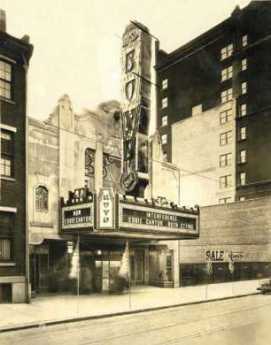
|
| Boyd Theatre |
Howard B. Haas a lawyer, and Shawn Evans an architect, are captains of a team trying to "save" the old Boyd Theatre at 1908 Chestnut Street. Since Clear Channel, the present owner has invested $13million in the property, and the preservationists agree that renovation of the movie palace to all its former glory would cost between $20million and $30million more, it's easy to understand why every other movie palace in central Philadelphia has been demolished. Furthermore, that area of town is having a resurgence of high-rise construction, so one use of the property must be balanced against others.

|
| Sam Eric |
The Boyd was built in 1928, just before the stock market crash, and closed in 2002. In fact, it changed its name to SamEric in its dying days, but the public remembers it as the Boyd, one of ten movie palaces in center city. The definition of a "palace" is arbitrary but is generally taken to be a theater with more than a thousand seats, normally with hyperbolic architecture to fit its hyperbolic advertising. Scholars of the matter say the earliest movie houses were constructed in Egyptian style, soon evolving into French Art Deco. Ornate, whatever it's called.
The palace concept developed in the era of silent films, with subtitles. Anyone who has experimented with home movies knows that the silent film sort of lacks something, particularly between reels and at times of breakdown in the projection. That's why brass bands played on the sidewalk outside, pipe organs played during intermissions, and all manner of vaudeville appeared on stage. Sound movies, or talkies, were immediately much more popular when they appeared in 1927, and had less need of the window dressing from other distractions which had grown into a moviehouse tradition which was slow to die.
The movie studios owned the films and soon built theaters to display them. The movie business was quite profitable from the start, so studios had the necessary finance to spread a network of very large theaters across the country quickly. The ability to concentrate hyped-up advertising with immediate display of the product in large captive theaters tended to drive the model of the "palace", which was able to sustain higher ticket prices than trickling a larger number of film copies to myriads of small "mom and pop" local theaters. In very short order, going downtown to see movies became at one time the largest reason for suburbanites to go to the center of town on public transportation, fitting in nicely with the concentration of huge department stores, also located there. Restaurants, bars, bowling alleys, and shops grew up to address the crowds. Furthermore, the economic depression of the 1930s slowed down what was to become a relentless automobile-flight to the suburbs. After the spread of free television at home in 1950, the downtown movie palaces were doomed. The legal profession helped, too. Small suburban theater operators eventually won an antitrust suit against what they described as monopoly power of studio-owned center city palaces, so a host of small sharks in the suburbs started to eat the whales downtown. Furthermore, the sound quality was easier to achieve in a smaller auditorium. To tell the truth, fire hazard was also lessened without the arc-lamps needed to project images across a long distance.
So, a new technology interacting with an old theatrical tradition quickly created the movie industry in its downtown movie palace form; more advancing technology quickly destroyed it, with a little help from economics and politics. Good luck to the friends of this historical epoch, who have a monumental task ahead to work up the public nostalgia and political strength required to overcome a huge economic obstacle of the "highest, best use of the land". In many ways, the most valuable contribution of this movie palace restoration movement is to dramatize in the public mind just how urban centers function. Department stores are gone, going in town to the movies is over. How else are you now going to get the couch potatoes to go downtown voluntarily, and often? Just imagine ten palaces simultaneously filling up with several thousand suburbanites apiece, seven nights a week. Without those additional drawbacks on ample display in Atlantic City and Las Vegas, please.
WWW.Philadelphia-Reflections.com/blog/1190.htm
Central Bankers Refine the Art of Diplomacy
Nancy Wentzler, Deputy Controller of the U.S. Currency, recently dramatized the arcane world of international currency exchange for the Global Interdependence Center's 25th annual Monetary and Trade Conference, held this year at Drexel University. For the most part, controlling currency operates flawlessly as far as the rest of us can tell. But every few years a sudden banking crisis pops up somewhere, pressuring a lot of bureaucrats in many countries to act quickly without a fire drill. Displaying panic could spread into world financial collapse, but so could acting too slowly. There's often a need for that most conflicting of all predicaments, the clear need to act outside of established channels. Hedge funds and private equity funds greatly increase the pace of banking panics, and if panic-stricken, can now send multi-billions from one place to another in fractions of a moment. In that same moment, everybody involved is in a meeting, or else frantically calling somebody. Even if the right person is identified, located, and takes the call, there is natural hesitation to take risky advice from a stranger without an identifiable track record. Protocol-driven supervisory bureaucracies may be suddenly forced to contend with professional traders whose whole life consists of calls roughly like this: "Hi, Joe, this is Bill. Buy me a gazillion shares of XYC at the market." To which Joe's answer commonly would be, "You got it. Thanks for the order, Bill. 'Bye. "
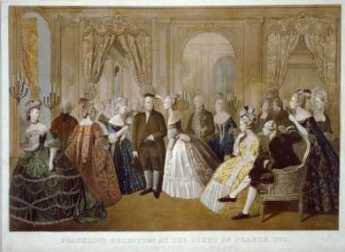
|
|
Benjamin Franklin at the French Court |
The potential for sudden fires calls out for fire drills. It also calls for the prior establishment of social networking among those who may have to depend on each other in a crunch. Whether by repeatedly dealing with each other or by social gatherings, or even just by immersing in trade gossip, it must somehow become possible for them to make a quick assessment of the person on the other end of the phone. Is the sound or flighty, can he be depended on to keep his word, or will he take for the hills.
Well, it sounds like a diplomatic corps, doesn't it? For the briefest of moments, one person represents the views of his country. The rest of his life is spent preparing for that moment. The most familiar American example is Benjamin Franklin, for eight years our ambassador to France. Franklin received heavy criticism for spending American money on social functions in Paris. John Adams, in particular, was outraged to see Franklin engaged in a constant series of dinners, balls, Royal parties, and salons; he was obviously having the time of his life, year after year. After all, he really only accomplished two tangible things -- he signed the Alliance with France which effectively won the war, and he signed the Treaty of Paris where Britain agreed to stop fighting.
U.S. and E.U. Exchange Experiences (1)
THE Global Interdependence Center (GIC), founded by Nobelist Lawrence Klein in 1976, brings noted foreign financiers to address Philadelphians interested in finance, and takes those Philadelphians abroad to return the visits. It's a gracious, entertaining, and highly stimulating travel club of very nice folks. Its 25th Annual Monetary and Trade Conference (in 2001) was especially exhilarating. Christian Noyer, President of the Banque de France, gave a description of the rationale and direction of the European common currency. Since he was the Euro's driving force right from the beginning, the experience of hearing him was pretty much like hearing Alexander Hamilton tell the story of the founding of the American banking system. Such a notable event needs to be reported.
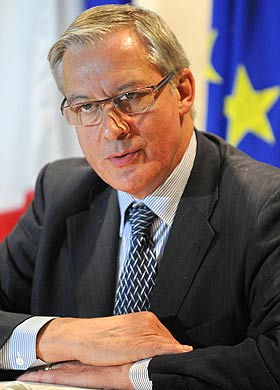
|
| Christian Noyer |
Christian Noyer urged that the central concept of the European Union is deliberate, voluntary surrender of national sovereignty -- for a mutually beneficial purpose. The declared purpose of the limited surrender of national control of the currency is economic; price stability, lower interest rates, the stimulation of international trade by lowering transaction costs. But the unstated, grander, purpose is the elimination of war. Because the limited technical purpose has been achieved in almost all areas, the grander purpose of eliminating war has not been an accident. With this simple, even humble, declaration it immediately becomes possible for a mildly irritated American audience to understand that European reluctance to become our active military ally grows out of a highly commendable set of motives, and widely differing historical experiences.
<As things worked out, the new nations who have recently joined the Union ("The U") are anxious to modernize, because the people of those nations demand modernization and their leaders must agree to achieve it. Inflation, that hitherto inevitable fund-raiser for national governments, must be eliminated in order to join and stays eliminated because the other members of The U will not tolerate it in a partner. In his curious way, "price stability" has placed the Union on the side of the people against the locally powerful, although it would be untactful to emphasize it. From the elimination of inflation comes lower interest rates, and from that, a stable currency. From that comes economic growth, for which the political lingo seems to be "modernity". As a consequence of this undeniable success, all nations in the area want to join the Union, and none wants to leave it. If that prevailing attitude doesn't lead to the elimination of what might then be a civil war, it's hard to know what will eliminate it. The marvel of all this skillful analysis is how natural, soft and modest it sounded, feeling like an old soft shoe. Eventual political unification is clearly an old dream in Noyer's head, but for now, he seems content with the vindication that it is possible to have a currency without having a country control it. It seems to be a steamroller of economic logic, flattening out the pretenses of merely political power.
No less an economist than Martin Feldstein has written that stable unified currency is doomed in the European context of widely diverse labor markets; Noyer seems pleasantly serene in the face of this argument. He wouldn't say so, of course, but some in the audience got the idea that Noyer probably believes the power of this cooperative idea will eventually discipline the unions the way it disciplined the politicians. One certainly hopes so, for the sake of this smooth, likable French aristocrat.
Compromise Outside the Borders of a Debate

|
| Cardinal Mazarin |
For example, the north European states, Germans, in particular, must resign themselves to subsidizing the Mediterranean nations for years to come, working a hard work ethic while they watch their wards live an easier one. But it can be accomplished; New England has been subsidizing Mississippi for more than a century, and Appalachia has been fighting the rest of the country's wars for them since 1860. The South was always more feudal, had a more distinct class system, had a culture of upper-class military schools, whereas the North had a background of largely religious reasons for emigrating to the New World. Lincoln, for example, was an ardent Whig, which in those days meant an advocate of helping commerce by the intervention of government. That is essentially a 17th Century French idea, said to originate with Cardinal Mazarin and Jean-Baptiste Colbert. Whether it is useful to continue the same idea for four later centuries is an emotional issue in a class with our own reluctance to change a word of the Constitution. There is even a shadow of present concern that Americans will have so forgotten the lessons of free interstate commerce that they might somehow surrender it for some other blandishment. Certainly, free international trade has its enemies. The abolition of slavery was, of course, an overdue achievement, too, but perhaps our long slog toward equal rights has allowed this second crusade to overshadow the history of what really was the main one. In case anyone feels impelled to start a quarrel about this viewpoint, let me remind him that Quakers started the abolition movement, right here in Philadelphia, and have nothing to apologize about, for maintaining the Union was a more important justification for Civil War that was the abolition of slavery.

|
| Jean-Baptiste Colbert |
With the American Civil War repeatedly reminding us how dangerous it can be for even unified nations to disagree about vital regional issues, it is useful to review such American inter-state friction even closer to the time of unification, namely the repayment of Revolutionary War debts. Here, the American post-unification memories were still about the same as pre-unification. Essentially, only the legal documents had changed very much. Secretary of the Treasury Alexander Hamilton was trying to arrange equitable federal assumption of all thirteen state war debts after Virginia had already paid off its bonds and obviously had thus given up the leverage of refusing to pay them. Virginia at that time was the largest of the component states, and because George Washington was President, Virginia was politically very powerful. But submerged within the now more powerful national government and subject to its rules, Virginians were now in quite a new position. Because Hamilton was trying to establish a good international credit reputation for the new national government, and because he wanted to acquire a creditor's power over all the states, he was anxious for the federal government to assume all state debts. Naturally, Virginians believed they would not have paid off the bonds if they had known this was coming. That's different in this case from knowing the rules before they acted. Imaginative alternatives were limited because the recent war had left no money in any treasury, or even likelihood that foreigners would extend credit. Because the Europeans chose to create monetary union as a step toward political union, the problem confronted European negotiators who were still positioned on behalf of independent sovereign states. The Greek government was skirting close to default on its bonds, whereas in the other case the
The solution reached was to mollify Virginia with a political plum, the location of the Nation's capital named Washington across the Potomac from George Washington's home, potentially directing the flow of Atlantic trade to the Potomac and to Virginia. Philadelphia was intensely displeased, and there are remarkably few statues and mementos to Virginia patriots to be found in that city, even today. However, the political maneuver remains as a classic; when negotiations reach an impasse on some central issue, try to balance the political debt with arrangements which have little to do with the issues at hand. In the case of the European Union, the Greeks have no money and probably can never repay the present bailouts, let alone any extra future indebtedness. Because of the recent international recession, other sources of funds from unrelated nations may well be unavailable. Argentina has recently nationalized a huge Spanish oil developer operating on the Argentine property, so there is a question whether the Spanish banking system is affected in some way that will further strain the Greek default, and thus further drying up sources of European credit. China is beginning to show signs of the Liquidity Trap, where ample funds are available in its banks but no one wishes to borrow money to build facilities, to produce goods, which the Chinese may not be able to sell. So, there are signs available to even the casual observer that it may simply not be possible to find the money to finance another Greek bailout, except to go back to the Germans. Since Adolph Hitler within recent memory had come close to conquering all of Europe militarily, there is understandable reluctance to appeal to Germany to become the rescuer of Europe, financially. The situation thus comes close to crying out for a solution that benefits some rescuer other than Germany, or which benefits Germany in some way that is not monetary. Like it or not, Germany has already rescued East Germany once, Greece at least twice, and can expect several more decades of subsidizing its less provident fellow Europeans. It is getting to be time for the rest of Europe to express its gratitude in some tangible, visible way.
Big Pharma Loses Momentum
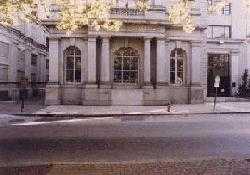
|
| Chemical Heritage Building |
listened to the analysis by G. Steven Burrill, a noted venture capitalist who specializes in this area. The big firms, like Merck, Wyeth, Johnson and Johnson have recently reported disappointing earnings, and it seems they have been reducing their American research divisions, with more use of small niche research firms as subcontractors, both American and foreign. As they tend to reduce their emphasis on research and manufacturing, Steve Burrill feels they will concentrate mainly on marketing. That sounds like good news for Wyeth, with its traditional focus on marketing, and bad news for Merck, which has always been strong in new product development.
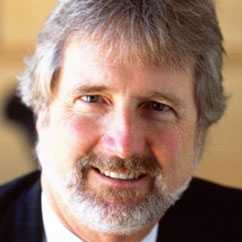
|
| G. Steven Burrill |
Burrill also has his eye on the statistic that only 8% of health care spending is devoted to pharmaceuticals, while 40% is spent on nostrums to promote wellness. The sly observation slipped out that if 40% of health spending goes for products of questionable value, just think how big the market would be for new products that really do promote some wellness. So that, in his opinion, is where investors will prosper.
Some of us in the back of the room were troubled by these thoughts. In the first place, the major drug houses have long operated with a financial business plan that takes profits from old established drugs and uses them to pay for research on the new drugs of the future. Small niche companies, that only work on one phase of this cycle, have had difficulty financing expansion and mostly accepted a subsidiary role. You might develop a wonder drug in your garage, but you had to license it to a big pharma concern in order to thrive. The thought pops up that the protracted wait for

|
| PA Drug Industry |
Food and Drug approval might be stretching the old-drug/new-drug interval to the point where patent expiration on the current revenue generators interrupts the internal recycling of profits into new drug research. That's been a threat ever since the passage of the Kefauver Amendment, but a new twist has appeared in the form of a tidal wave of cheap liquidity from the Far East, working its way into venture capital pools and assisting the niche firms with their historical shortages of capital. If that's a significant feature of the present environment, it could fizzle out when the Far East stops pumping liquidity into world markets. A new Premier of Japan might be all it would take, or else a drop in the price of oil. Japan's interest rates are now held below 1%, while a realistic price for oil is $45 a barrel, not $65.
And as far as the promotion of wellness is concerned, that concept might just turn out to be a fad. Congress doesn't try to evaluate scientific trends, but it is very fond of insisting that "if it ain't broke, don't fix it". A major advance in the treatment of cancer and or Alzheimer's Disease might very well dampen Congressional enthusiasm for spending 15% of Gross Domestic Product on what's then left to treat, which would mostly be wellness.
Globalizing Real Estate

|
| U.S. Treasury bonds |
As the whole world evolves from an agricultural economy to something else we call modern, one country after another finds wealth accumulating faster than its rudimentary banking system can handle. Until the banking system matures, the result is usually severe inflation in the price of real estate. For an easy illustration, pick up one of those Nineteenth-Century Russian novels, replete with the familiar figure of a rich Russian nobleman who owns vast estates, losing it all for lack of ready cash. In our century, the illustration would be the whole Chinese populace, forced by lack of alternatives to buy U.S. Treasury bonds which almost every American shoeshine boy will tell you are a weak investment.
A modernizing economy doesn't have to rely on real estate alone; gold and precious gems partially serve the role of a banking system and help define the limitations of its absence. Like real estate, gems and gold coins must be protected from physical theft and attrition, while at the same time lack any means of generating income. Herein lies the explanation for jumps in real estate prices in places where oil is discovered, like Kazakhstan.
The recent rise in real estate prices in America, from which Philadelphia does not escape, is related but different. Here, our unique tax exemption for interest on home mortgages plays a role, augmenting the main issue which is artificially low interest rates. Interest rates in America are suppressed by a flood of wealth from the Far East, especially Japan and China. Since this phenomenon results from backing-up behind impaired banking systems, the Orientals are exporting their problem to us because they lack other alternatives. Since they simultaneously export deflation from their low prevailing wages, the world economy is in a precarious balance between two pressures which are someday almost certain to get out of balance. The textbook solution for this issue is for banking systems to spread and mature in the Far East, a process requiring at least another decade and to some degree another century.
But banking itself is changing and changing too fast to manage. Banks as Americans know them are fast disappearing, replaced by credit cards, money market funds, electronic bill-pay, and deliberately impenetrable mysteries like hedge funds and derivatives. This is a great time to have an advanced degree in mathematics, but the main problem is that vast wealth is to be made from keeping others from knowing what you are doing. If your faith is in a regulatory solution, just watch Congressional hearings on C-Span. Politicians always look puzzled when confronted with economics. When the topic is monetary aggregates, their woeful expressions only evoke pity.No Laborer Left Behind
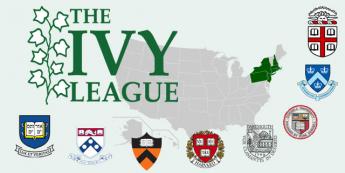 |
| Ivy League |
The top thirty American colleges have ten times the applicants they have room for. Demand vastly exceeds supply, prices are essentially fixed; shortages result. Can-do is the American way, so our first reaction is to build a lot more colleges and beat them over the head if they aren't first-rate. To bring this down to a local scale, implications are that Philadelphia has a moral duty to build eighteen more Ivy-League universities.
 |
| Cosa Ricians Roofers |
Let's think about that, in a back-of-the envelope way. Since the rest of the country is going to be similarly driven, we can't attract Americans to run those universities. Philadelphians who are doing other things must staff those universities; people inclined to become professionals of a different sort are going to have to be trained to be university professors. Students now being rejected will be admitted, since that's the purpose of the thing. Unless we somehow increase academic productivity, every man, woman and child from Trenton to Wilmington is going to be in a college classroom in some capacity or other. We here confront the extrapolation fallacy; a new problem must be addressed in more productive ways than just more of the same.
Curiously, the readjustments to this overall shift from an industrial to a service economy are first making their appearance in things like roof repairs and ironing shirts. When my house needed a new roof, I found I had a choice of workgangs composed of Costa Rican, Puerto Rican, or Polish roofers. The Costa Ricans made the best bid and went to work immediately. They started pounding on my roof at 6 AM, and we're still pounding after I went to bed at night; I have grave doubts that American roofers would approach that work standard. I am told that the entire building industry, on which our current prosperity rests, would collapse if we banned illegal immigration. In a different industry, Philadelphia's convention hall cannot attract visitors unless we build more hotels. But the hotel industry cannot find nearly enough people who speak English to make the beds. For one purpose or another, we have imported 12 million illegal immigrants who mostly remain invisible because they are so hard at work.
We are going too recklessly fast with what is fundamentally a useful transformation of our society. Americans want to go to college because statistics show that will make them prosper. But that's only half of their transformation. The other half is a resulting shortage of labor in the jobs which do not require college. Normally, you would expect wages to rise, but they are suppressed -- deflated -- by substituting immigrant labor, legal and illegal. Impose an effective barrier to immigrants, and you would quickly see inflation like you wouldn't believe. Combat inflation by raising interest rates and the housing market would quickly collapse. That would prove to be a painful way to make the immigrants decide to go back home, although it would be effective. And so on, and so on, and so on.
Slow down, America. You're going in the right direction, but exceeding the speed limit.
Immigration
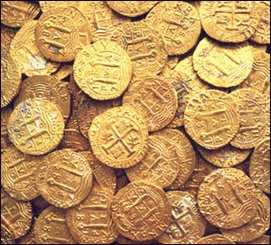
|
| Gold |
We're alluding indirectly to immigration as a general topic in this article because sooner or later every discussion of every aspect of immigration adds a claim of "fairness" to the balance. In this case, plain talk about fleecing peasants first requires the definition of an unfamiliar term. Seigniorage, also spelled seignorage, or seigneurage, originally only denoted a fee which governments charged for milling coins out of precious metal. Developing nations often didn't have the necessary technology, so they paid some other country to do it for them. That was fair enough, but soon "trimmers" would shave the side or surface of coins and gather up the dust for sale. That practice led to clever serration of the formerly flat edges, much simpler than weighing coins to detect cheats.
In time, improved printing techniques allowed governments to keep precious metal in vaults and issue paper currency, some of which inevitably got burned, shredded or lost. Since the issuing government could then keep the whole value of lost currency minus printing costs for itself, the term seigniorage evolved to include this more lucrative method for governments to cheat citizens, abusing their monopoly on the currency issue. There might seem to be some temptation for governments to print money on fragile paper, except it is overbalanced by the need to make it hard to counterfeit. Happily, this sort of seigniorage always seemed less offensive because everybody agrees that if you have money in your pocket, shame on you if you lose it. As transactions become more sophisticated, however, some innovative modern arrangements which loosely fit the definition of seigniorage become a new source of moral dismay. One facet of currency razzle dazzle concerns immigration, which is itself always a contentious matter.

|
| Spanish |
Right now, it is authoritatively estimated that the Social Security program has collected half a trillion dollars in Social Security and Medicare taxes, whose rightful owner is impossible to determine. Some of the beneficiaries may have died without claiming the money, so some of this topic might be classified as escheat, or abandoned by the owner. But very likely the bulk of this money, under modern circumstances, was withheld from illegal immigrants by their employers, either without their knowledge or using counterfeit social security numbers; and the fugitive status of the owners made them reluctant to claim it. Half a trillion is five hundred billion dollars.
This sort of discovery leads to some troublesome thoughts. If the immigrants are legal, or if now illegal may receive amnesty, they will be fully eligible for social security benefits. You might say they earned such benefits, but our tormented public pension system is in fact almost entirely funded by one generation funding its parents' generation. That borrowing between generations means paying for it later, so of course, it enjoys the politician spin-term of "pay as you go". An American of multi-generational descent has paid for his parents while he works and expects to have his own pension paid for by his children. An immigrant, never mind his citizenship, is paying the same taxes, but has no parents as beneficiaries. When the newcomer retires he may be a burden to his children like the rest of us, but his current payments go into the black hole of government deficits without paying for any parents. Here we have seigniorage on a much grander scale. The money presently diverted from the usual channels by this ingenious arrangement is calculated to be two trillion dollars, or four times as much as the paper money seigniorage, and many many times as much as the shaved-coins scam. Just for comparison, consider that America is estimated to have 900 billionaires. Their aggregate net worth is probably only slightly greater than the amount our government garners from illegal immigrants.
The matter really does seem to be important enough for us to learn how to spell seigniorage, and even reconsider whether to apply the term to its most popular current manifestation.
Quakerism and the Industrial Revolution
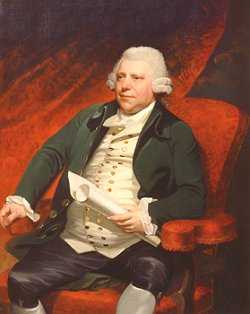
|
| Richard Arkwright |
The Industrial Revolution had a lot to do with manufacturing cotton cloth by religious dissenters in the neighborhood of Manchester, England in the Eighteenth Century. What needs more emphasis is the remarkable fact that Quakerism and the Industrial Revolution both originated about the same time, in about the same place. True, the industrializing transformation can be seen in England as early as 1650 and as late as 1880. The Industrial Revolution thus extended before Quakerism was even founded, as well as long after most Quakers had migrated to America. No Quaker names are much mentioned except perhaps for Barclay and Lloyd in banking and insurance, and Cadbury in candy. As far as local history in England's industrial midlands is concerned, the name mentioned most is Richard Arkwright, whose behavior, demeanor and beliefs were anything but Quaker.
He seems to have invented nothing, stealing the patents and ideas of others freely, while disgustingly boasting about his rise from rags to riches. Some would say his skill was in the organization, others would say he imposed an industrial dictatorship on a reluctant agricultural community. He grew rich by coercing orphans, convicts and others he obviously disdained into long, unpleasant, boring and unwelcome labor that largely benefited him, not them. In the course of his strivings, he probably forced Communism to be invented. It is no accident that Karl Marx wrote the Communist Manifesto while in Manchester visiting his friend Friedrich Engels, representing reasonably well the probable attitudes of Arkwright's employees. What Arkwright recognized and focused on was that enormous profits could flow from bringing piecework weaving into factories where machines could do most of the work. Until his time, clothing was mostly made by piecework at home, with middlemen bringing it all together. The trick was to make clothing cheaper by making a lot of it, and making a bigger profit from a lot of small profits. Since the main problem was that peasants intensely disliked indoor confinement around dangerous machines, the industrial revolution in the eyes of Arkwright and his ilk translated into devising ways to tame such semi-wild animals into submission. For their own good.
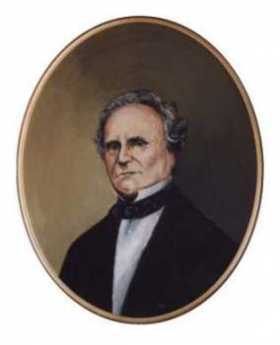
|
| Charles Babbage |
Distinctive among the numerous religious dissenters in the region, the Quakers taught that it was an enjoyable experience to sit indoors in quiet contemplation. Their children were taught to submit to it at an early age, and their elders frequently exclaimed that it was a blessing when everyone remained quiet, enjoying the silence. Out of the multitude of religious dissenters in the first half of the Seventeenth century, three main groups eventually emerged, the Quakers, the Presbyterians, and the Baptists. Only the Quakers taught that silence was productive and enjoyable; the Calvinist sects leaned toward the idea that sitting on hard English oak was good for the soul, training, and discipline was what kept 'em in line.
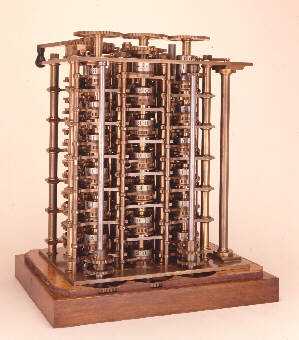
|
| babbagemaq.jpg |
The Quaker idea of fun through daydreaming was peculiarly suitable for the other important feature of the Industrial Revolution that Arkwright and his type were too money-centered to perceive. If workers in a factory were accustomed to sit for hours, thinking about their situation, someone among them was bound to imagine some small improvement to make life more bearable. If such a person was encouraged by example to stand up and announce his insight, eventually the better insights would be adopted for the benefit of all. Two centuries later, the Japanese would call this process one of continuous quality improvement from within the Virtuous Circle. In other cultures, academics now win professional esteem by discovering "win-win behavior", which displaces the zero-sum or win/lose route to success. The novel insight here was that it has become demonstrably possible to prosper without diminishing the prosperity of others. In addition, it was particularly fortunate that many Quaker inhabitants of the Manchester region happened to be watchmakers, or artisans of similar trades that easily evolved into the central facilitators of the new revolution -- becoming inventors, machine makers and engineers.
The power of this whole process was relentless, far from limited to cotton weaving. When Charles Babbage sufficiently contemplated the punched-cards carrying the simple instructions of the knitting machines, he made an intellectual leap to the underlying concept of the tabulating machine. Using what was later called IBM cards, he had the forerunner of the stored-program computer. There were plenty of Arkwrights getting rich in the meantime, and plenty of Marxists stirring up rebellion with the slogan that behind every great fortune is a great crime. But the quiet folk were steadily pushing ahead, relentlessly refining the industrial process through a belief in welcoming the suggestions of everyone.
Herbert Hoover, Mining Engineer
The tragedy of Herbert Hoover

|
| Herbert Hoover |
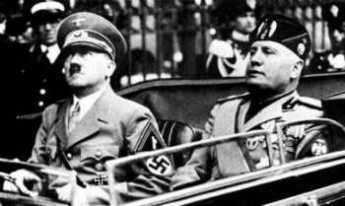
|
| Hilter & Mussolini |
After leaving his meteoric twenty-year business career in boredom at its lack of challenge, he took on a monumentally successful job of administering famine relief to a European continent devastated by World War I. On occasions in the course of it, he personally confronted both Hitler and Mussolini with disdain. Franklin Roosevelt was so impressed that he suggested him as a Democratic candidate for the Presidency; Hoover declined. He was nominated at the Republican convention on the first ballot, elected in a landslide. As President, he hit the ground running, simply peppering the Congress with innovative programs and proposals. A substantial part of what would be known as Roosevelt's New Deal grew out of initiatives that Hoover had begun during his short presidency.
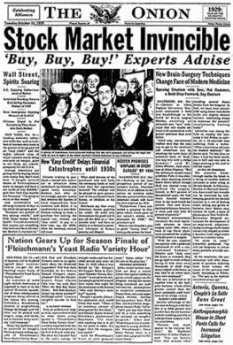
|
| Stock Market Invincible |
Under the circumstances, it is not surprising that Hoover was disturbed by the irrational exuberance of the stock market in 1927-28, undisposed to resist proposals by George Harrison of the Federal Reserve to deflate the stock bubble by tightening the money supply. Some observers feel the fatal illness of Benjamin Strong (President of the New York Branch) weakened the resistance of the Federal Reserve to this adventurism. The stance of Hoover is not now known, but it must have been a toss-up between lifetime allegiances to hard-money and resistance to government intrusion into commerce, particularly by a comparatively new agency. In any event, tightening money worked too well. The stock market tanked in October 1929 FB is shutting down in March,
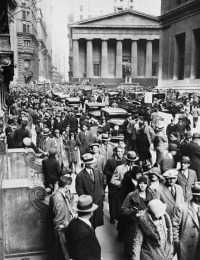
|
| Stock Market Crash |
followed quite promptly by the whole economy. The irony is that Roosevelt proceeded to run for twenty years with the claim that the Depression was caused by Hoover's failure to restrain the 1928 stock bubbles. In fact, the befuddled Federal Reserve bounced around during Roosevelt's time in office as well, turning a recession into the deepest depression in history. When England went off the gold standard, the Federal Reserve tightened again to prevent a flight of American gold to speculators. The result was a run on the banks, so the Fed loosened again, and half of the American banking system disappeared. Following the 1929 crash, the stock market continued to go down -- for fourteen years.
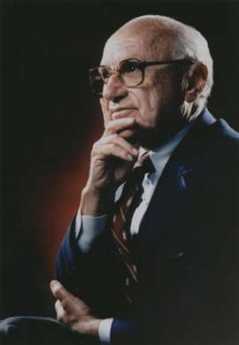
|
| Milton Friedman |
After a while, it became clear to everyone that three things -- the money supply, the economy, and the stock market -- go up and down together. The basic question was the same as the political one -- which one goes first, and which ones follow? Although the political parties continue to spin the facts, the world of economists seems nearly unanimous that Milton Friedman and Anna Schwartz and Milton Friedman settled the matter some time ago. Their classic work of scholarship,A Monetary History of the United States 1867-1963 , traces out four American and eleven foreign examples of shifts in monetary tightness which were unrelated to the economy, and demonstrate that the economy promptly follows the direction of the money supply. Almost all of these anomalies took place during the interval after World War I, when the gold standard was temporarily suspended. Different countries returned to gold at different times, and after the 1929 crash abandoned it in different ways at different times. Since the publication of Friedman's work, independent scholars have provided over forty confirmations of the sequence, money leads, the economy follows. And politicians posture. There is a disconcerting note, however. Almost all of the examples studied by monetary scholars could be used as proof of quite a different slogan. In almost every case, a country rescued itself by abandoning the gold standard, and the sooner it got rid of gold, the better it did. That would, of course, be true, during a period of concealed deflation where exuberant economic growth exceeds the expansion of gold supplies. A serious weakness of the gold standard has certainly been identified, leading to expressions like barbarous relic and crucifixion on a cross of gold. But there is the other, time-honored, side of it; since the beginning of history, governments have been tempted to inflate the currency in order to dishonor their debts. Governments will do so again at the first opportunity. Without the discipline of a gold standard, the only dependable defense against the catastrophe of hyperinflation is now the courage of the Federal Reserve, and the rather faint hope that we have learned everything about monetary policy that is important to learn.
REFERENCES
| Herbert Hoover: The American Presidents Series: The 31st President, 1929-1933: William E. Leuchtenburg, ISBN-13: 978-0805069587 | Amazon |
Africa Comes to the Schuylkill
A journalist, John Ghazvinian, recently toured the many countries of Africa, wrote a book about it and carried his message to the Right Angle Club of Philadelphia. Philadelphia does not think of itself as particularly involved in oil matters, or African ones. But the fact is the refineries on the Schuylkill down by the airport generate two-thirds of the gasoline now used on the East Coast, and right now it mostly comes from Nigeria. There was a time when the crude oil coming to Philadelphia came from Venezuela, but politics are a little unpleasant there at present, and anyway Venezuelan oil is heavy and full of acids. The refineries which specialize in that kind of heavy oil are on the Gulf Coast. Long before the Venezuelan era, the Philadelphia refineries were constructed to refine crude oil from upstate Pennsylvania. They were once the main source of the dominance of the Pennsylvania Railroad, because oil refining from Bradford County gave the Pennsy a return freight, whereas the competitive railroads running out of New York and Baltimore had to return from the West without cargo.

|
| African Map |
There are 54 countries on the continent of Africa, quite different from each other in character. One dominant characteristic of Africa is its lack of natural ports, and even the Mediterranean ports are cut off from the rest of the continent by the huge transcontinental stripe of Sahara desert. Major wars and famines, monstrous genocides, unspeakable cruelty, and poverty go on there without much notice by the rest of the world.
The largest country in Africa is Nigeria. Anyone with even minor dealings with Nigeria soon sees that corruption and dishonesty pass all Western imagination, and they have serious tribal warfare as well. The discovery of large deposits of oil in the region faced the international oil companies with a rather serious difficulty. For instance, Shell Oil has had over 200 employees kidnapped for ransom and is seriously contemplating abandoning its whole venture. At the moment, corruption is coped with by constructing oil wells a hundred miles out in the ocean.It's almost true that the huge tanker ships make from Philadelphia and return, without the crew talking to any natives of Africa.
We hear that genocide is in full bloom in the Sudan, and that poverty in that country similarly passes belief.

|
| Chad Poverty |
They have oil in the South of Sudan so we may hear more of it. Chad has poverty and oil, and civil war. They have a big Exxon facility, but there isn't a single gasoline station in Chad. At the moment, Angola has paused in its enormous civil war, which killed millions, and Chevron will surely encounter unrest before it is done. Gabon appears to be extremely prosperous, from oil money of course, but they are being ravaged by the Dutch Disease, of which more later.
Apparently, Equatorial New Guinea sets some sort of record for wild behavior. It has lots of oil, and a strong Chinese influence. The current
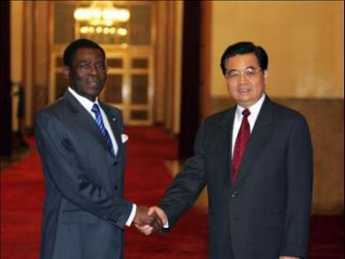
|
| Mbasogo and Jintao |
President of Equatorial New Guinea got his job by shooting his uncle. But don't feel too sorry for the uncle, who used to have an annual Christmas morning celebration, consisting of herding his enemies into a football stadium, and shooting them for the edification and entertainment of the populace. After listening to Mr. Ghazvinian, it seems small wonder that so few American tourists, or journalists, or even missionaries, manage to complete extensive African excursions. As everyone notices, if you don't have journalists, there is never any news.
Let's turn to the Dutch disease,

|
| David Ricardo |
of which Africa currently displays many examples likely to torment economics students for decades after Africa eventually rivals Houston. Let's start with David Ricardo, who electified the Nineteenth Century world of economics with his principle of comparative advantage. Ricardo pointed to the obvious truth that always and everywhere a nation does best for itself by identifying its best economic feature and then sticking to it. If every country wakes up and does that, every country must then trade with its neighbors for other things it isn't so suited to make. Consequently, tariffs and trade barriers are a hindrance for everyone, in time impoverishing all nations in the cycle, whatever short-run advantages of tariffs may seem enticing.
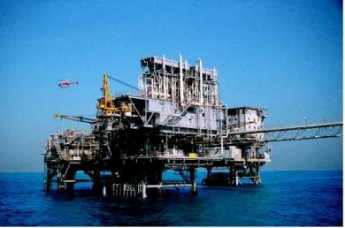
|
| North Sea Gas |
So far as I know, Ricardo was quite right, but someone had better hurry up and reconcile his underlying premise of comparative advantage with the Dutch Disease. The Dutch disease was identified and named by an anonymous writer for the London Economist about thirty years ago. Noticing that the Netherlands experienced a marked worsening of its general economy after the discovery of North Sea gas deposits, the observer for the magazine concluded that sudden accumulation of wealth in the gas industry led to a rise in the value of the Dutch currency, soon making it impossible for non-gas industries to export, unable to compete at home with now-cheaper foreign imports. Naturally, investors rushed to invest in gas, sold their holdings in other industries, and Holland was propelled in the direction of a one-industry economy, quite at the mercy of fluctuating prices of gas. This was the Dutch Disease born, and Ricardo's principle of comparative advantage exposed to quite a severe challenge from which it has not completely recovered. This is important, so how about a simpler description: When gold is discovered, people drop tools to have a gold rush. Wealth lost from dropping tools is greater than wealth gained from the gold.
Fear of the Dutch disorder seems to be the reason why the Chinese are buying our Treasury Bonds, the Japanese engaging in the astonishing "carry trade," and the Arabs buying American private equity funds. The common strand through all these schemes is this: By sending their bonanza savings abroad, they "sterilize" them from their tendency to force their currency upwards. They are exporting inflation, but also endangering their own struggling non-bonanza industries, which are the main hope for diversifying their economies and getting rid of the Dutch effect. Somewhere during this balancing act, politicians get involved and make things worse. So they call in their generals and admirals, to explore solutions we prefer they were not in a position to explore. Simpler description: When you discover oil, inflation soon follows. And all too often, revolution follows that.
The 1787 the American Constitution unknowingly cured thirteen cases of the Dutch Disease, by imposing absolute freedom of interstate commerce. After eighty years, the benefits of this national union would persuade the North to bleed and die for it. Although the Confederacy thought they were fighting for their way of life, meaning slavery, even the Southerners today recognize they are better off in a Union. Unfortunately today, the European nations are still having a hard time believing the benefits of union could possibly outweigh their allegiances to language, religion, and the wartime sacrifices of their ancestors. They are very wrong, but we are wrong to sneer at them. Except for maybe Switzerland, it is difficult to name another instance in all of history where several independent states gave up local sovereignty for the benefits of a diversified economy with local pockets of comparative advantage. Let's restate it again: the Dutch disease is a result of sudden single-industry prosperity in a country too small to control it.
By the way, what eventually happened to the Dutch? It seems likely that absorption of little Holland into the European Common Market helped dilute the corrupting effect of gas prosperity. It suggests the possibility that Dutch can be reconciled with Ricardo through the common denominator of reduced national barriers to trade and currency-- reduced sovereignty in a milder form. But it's a hard slog. Maybe we could envision annexing Alberta to soften the commotion of oil tar, but it takes a lot of imagination to see the amalgamation of China and India, any time soon. There may thus be nations too big to merge, but nevertheless, it would probably be less destabilizing to merge with all of Canada than just with Alberta if you overlook the obvious fact that it is easier to persuade a small country than a big one. Just kidding for the sake of example, of course, since Canada shows no interest in the idea.
Meanwhile, take a look backward from the highway overpass the next time you travel to the Philadelphia Airport. There's a lot more going on in those refineries than just black liquid flowing into steel pipes.
Hayek Confronts Keynes

|
| The Four Horseman |
Catastrophes seem to have fashions. There was a time when the four horsemen of the apocholypse -- pestilence, war, famine, and death -- rounded up the main things to keep you awake with worry. Perhaps it is too soon to gloat, but pestilence and famine seem tamed, even ready to be "put down". War remains a serious cause for concern, but a case can be made that two economic disasters, inflation, and recession, have moved up to dominate our nightmares. Indeed, it is the Summer of Love in 1967 which seems to mark the watershed moment, when basic survival stopped being the main risk in life, supplanted by threats to existence that are largely self-inflicted. The first warning of this sea-change appeared in the fall of 1929 when it seemed to be deflation, unemployment and all the other havoc of economic recession that caused wars, famines, and pestilences. The 1929 crash did not send a fully readable message, however, because it was so one-sided. It took another 37 years for the world generally to appreciate there was an opposite side to it; inflation was just as bad as recession, and both problems were largely man-made. One person gets most of the blame for the distorted emphasis. John Maynard Keynes, later Lord Keynes, was the prophet who seemed to save the world with the doctrine that the deflation emergency was so dire that civilization could not afford to worry about the long-term drawbacks of deliberate inflation. He persuaded world leaders to inflate the currency before civilization disappeared. After all, in the long run, we are all dead.
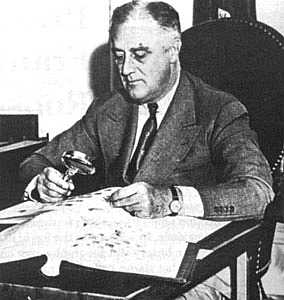
|
| Roosevelt Stamps |
There's an irony that Franklin Roosevelt was a hobbyist who collected postage stamps because stamp collectors were about the only Americans who were dimly aware that Germany and Austria had hyper-inflation as the main curse. Austrian postage for billions of marks gradually filtered into our collections of odd foreign stamps, arousing mild international curiosity. But Friedrich August von Hayek was living in the midst of it, painfully aware of its pain and chaos. It became the central focus of the life of an aristocratic decorated war veteran who became a distinguished economist, eventually winning a Nobel Prize. What caused inflation? Why didn't it stop? Why was it so destructive? How can inflation be prevented? How could Maynard Keynes possibly urge the leaders of nations to inflate their currency deliberately?
As a scholar in the dismal days of world depression, Hayek had a hard time, living for long periods on the charity of a few philanthropists who recognized his talents. He is best known for his scorching analysis of collectivism, a craze which swept through academic and political leadership, particularly in Europe, and his persuasive views probably constitute the main intellectual force which ultimately ended the Cold War. It is seriously stated that personal animosity by Socialist-leaning academics materially injured his academic career, although it probably gave him more time, and motive, for serious writing. Inflation and political collectivism do not seem tightly connected, but it is easy to observe that command economies do inevitably clash with private property and market decisions. For the present, it seems useful to set aside Hayek's monumental political achievement of discrediting Communism and focus on his penetrating view of inflation.
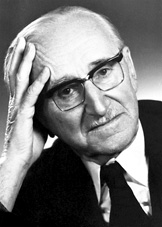
|
| August von Hayek |
You can almost watch his mind at work. If you give long hard consideration to the topic of inflation, you have to conclude that there seems no reason for it to be a bad thing. It may take a little time, but the price of everything will eventually readjust to a new higher level, and relationships will go on undisturbed. At first glance,
You can almost watch his mind at work. If you give long hard consideration to the topic of inflation, you have to conclude that there seems no reason for it to be a bad thing. It may take a little time, but the price of everything will eventually readjust to a new higher level, and relationships will go on undisturbed. At first glance,
inflation is just a harmless numbers game. You can understand the power of inflation; everybody likes a little of it for his own personal benefit. If everybody enjoys a little of it in his own sphere, then the whole world is pushed to a higher numerical level.
After long consideration, Hayek came to see that the disruptions of inflation are caused by the uneven speed of penetration throughout an economy or nation. If the price of oil goes up, the price of transportation goes up, then the price of home heating. But those who take the train or who heat their homes with coal are not affected so soon. Mortgages carry a fixed interest rate for thirty years until the unwisdom of such agreements becomes clear, but it takes time. The process of inflation creates winners and losers, and disruption in the culture of payments. The speed of payment is itself a factor in the virtual size of the monetary pool. In the long run, we're all dead and it all settles out unless we set in motion a universal scramble to get out the door before others get there. Inflation is just as much evil as collectivism, and somehow the two are usually seen together. The Road to Serfdom sits on the shelf, right next to The Austrian Theory of the Trade Cycle, and Other Essays .
Picking Up the Usual Suspects
The federal government directly controls about half of health care spending and makes rules affecting most of the rest.

|
| Claude Rain |
Every group or business which receives some of this money is alert not to lose it. Many other groups are alert for openings to get more of it. All employ sentries in Washington. False alarms are frequent, stealth attacks are a constant threat, constituents paying the bills demand immediate reassurances. Members of Congress seldom initiate a disturbance unless someone from inside an industry brings it to them. Consequently, when proposals do surface and seem to be serious, the question to be immediately answered is -- who's behind this? If you know who starts something, you can readily imagine the motive, assess the political strength, decide how to respond. With what little was generally known about the Clinton Health Care Plan of 1993, it was easy to imagine a host of people with some motive, but very hard to say who was actually pushing one. Must be a Democrat, obviously, but not immediately obvious which of several possibilities was the real agitator.
Health insurance companies would always seem likely to have proposals about national health insurance. Blue Cross dominates the market in large geographical markets, mainly East Coast, and would seem fearful to lose that dominance in a major upheaval. But other market areas of the country are dominated by commercial insurance companies who might seek to upend the Blue Cross monopoly, but whose form of business would be even more seriously threatened by health insurance innovations. Most commercial health insurance was written by large life insurance companies who regard health insurance as a small sideline for the convenience of their industrial customers. Blue Cross was somewhat more comfortable with government work, particularly since the 1965 Medicare and Medicaid programs were patterned after them. However, Blue Cross was non-profit, thus lacking in incentives, and historically controlled by health care providers. That is, Blue Cross was formed by and dominated by the hospital associations, and Blue Shield was formed by and dominated by medical societies. Since doctors and hospitals were very prompt in announcing their deep concerns and uncertainties about the Clinton Plan, Blue Organizations seemed unlikely to make daring proposals so likely to provoke trouble at home.
Not that some doctors and some hospitals didn't try to see what might be made of this opportunity. At the American Medical Association, certain leaders known to have Blue Shield involvement offered conciliatory remarks about waiting for further details before taking a stance but were abruptly halted by a general opinion that things had apparently already gone too far for substantive negotiation. Much the same thing occurred at the Hospital Association; the winners had too much to lose, the losers had too little influence to matter, and nobody stepped up to claim an inside track. Hospital trustees didn't know what was going on, strongly suspected something was going on and didn't like either situation. If the doctors got mad enough at a hospital, they could ruin it, and if hospitals got mad enough at Blue Cross, it too was ruined. The main strength behind the Blue Cross monopoly position was the secret discount provided to them by hospitals, which was refused to competitor insurance companies but could easily be extended in the interest of fairness. If need be. The commercial competitors wanted that discount much more than they wanted new insurance models.
There is one subset of doctors and hospitals that might be suspected of generating a sweeping revision of the medical system -- academia. Medical schools think of themselves as the appropriate source of vision about the profession they are training, and they run large prestigious hospitals. Their heavy dependence on government research grants, teaching subsidies, and tuition support programs puts them in constant contact with Washington bureaucracy and politics; propinquity is a great match-maker. Their style of salaried faculty creates estrangement from making a living by being paid fees for specified services, and they are reasonably comfortable with the flaws and techniques of professional promotion within a large organization. So, a slogan which has been attributed to Wilbur Cohen himself does not greatly jar on their ears. The author of the Medicare Act is said to have announced that the entire medical system of America could be accommodated by thirty or forty Mayo Clinics. Twist that just a little, and you are imagining he said forty or fifty medical school teaching hospitals. The briefest contemplation and rebuttal will knock down that proposal, such as pointing out that we have several times that many teaching hospitals at present without achieving anything like the nation-wide coverage envisioned. After absorbing the administrative chaos of readjusting to that model, you would confront the old repeated history of grossly overestimating, and then grossly underestimating, the future manpower needs of a medical system in the process of constant scientific turmoil. Suppose you built the fifty Mayo Clinics and found you needed two hundred? Suppose you built two hundred and found you needed seventy? And then, finally, remember that each big city could expect to contain one of these organizations, but the fewer of them there are, the longer the distance everyone else would have to travel to get to them. No one has even ventured to speculate how you could go about doing such a thing, let alone doing it three or four times to get it right. But, but. The infeasibility of academia at the center of medical care delivery does not eliminate the possibility that the idea underlying the Clinton Health Plan may have originated in academia, or that academia might support some similar proposal with something else at its center.
Since it was soon clear that the traditional "players" in the health policy arena were unlikely to be sponsoring some self-serving policy that might masquerade as the Clinton Health Plan, the search went on. There were a number of professional groups within the medical community who had traditionally chafed at the domination of the hierarchy by physician leadership. Nurses, hospital administrators, pharmaceutical companies, druggists, corporate human resources officers, public health officials, social workers, biology teachers all represented groups who derived status with the public by displaying inside knowledge of medicine. But all of them fell silent when a physician entered the room, and tended to shift their emphasis to faults of the "system" or the "industry". Their Washington representatives placed their emphasis on changes in the existing system which might elevate the prestige and income of the members and were particularly vigilant for system modifications intended for other purposes which might nevertheless create advantageous loopholes for the members. All of this is normal striving in the good ole' American way, a polite variant of the mixture of bellicosity and restraint usually seen in the Union movement. These people wanted to improve their income and working conditions but were ultimately quite hesitant about radical proposals that might sink the ship. A quick survey showed they were not supporting any particular reform project, even though they could be counted on to support any reform project. Furthermore, they consistently injured their political strength by extending beyond economic goals to issues like radical feminism in the case of nurses, or direct advertising to the public as in the case of the drug companies, or practicing medicine without a license in the case of limited-license practitioners. These people had votes, influence, and lobbyists, but they did not have a national project for health care reform of their own devising, and they surely were not the people behind the Clinton Plan.
During the six months before The Plan was presented to Congress and the Public, a White House task force said to consist of five hundred secret members was meeting under the direction of President Clinton's wife Hillary. No doubt part of their purpose was to give Hillary a public platform on which to show her stuff, with the idea of someday succeeding her husband as President sort of in the back of her mind. But most of it was also quite practical; somebody had to figure out what this proposal was going to be, and newly elected Bill had to spend most of his time learning how to run the rest of the country. Buried in here was an efficiency principle too; the staff members of every important congressman and senator were involved in the process, making the deals and surfacing the political angles before things had to come down to votes and filibusters. Meanwhile, the rest of the country had to wait outside closed doors, fed by rumors and spin.
How well I remember one public seminar on the subject during this period of suspense. The audience was filled with people thought to be influential with the public, the usual suspects in that sense, too. Representatives of various interest groups were seated up front at a table, and for some reason, I had been picked to represent doctors. Next to me was a druggist who had made a billion dollars starting an HMO; it was intriguing to watch how many well-dressed women with no interest in health care paraded up to the table to show their stuff to the billionaire, while we waited for the meeting to begin. All of the usual suspects of Philadelphia medical care were at the table, each of us wondering what the other was going to say. When some last Very Important Person had wandered in and taken a seat, it was time to begin. The moderator told a funny story or two, and then asked each one of us what we thought of the Clinton Health Plan. One by one, to the utter amazement of us all, we each explained how we were opposed to it.
So obviously this proposal was not coming from the usual agitators. But, remember, somebody was surely behind it. Before we take a stab at that mystery, let's humanize the usual suspects by describing a few of them.
Equal Pay for Equal Work

|
| American Medical Association |
The House of Delegates of the American Medical Association holds a five day convention twice a year. The meetings last from 7 in the morning until midnight, although the main sessions in the auditorium only last eight hours a day for three days. The rest of the time is consumed with meals, committee meetings, geographical caucuses, and even cocktail parties. Newcomers often object to the numerous parties until they come to see that these are merely committee meetings in a different form, with different subsets of the organization picking up the necessary costs. This group of workaholics has to vote on several hundred issues each session, and most Delegates have little advance opinion when they enter the headquarters hotel on the first day. But after meeting with their specialty in one committee, and members of their geographical region in another, and members of their medical school alumni association in yet another, and with issue-oriented groups, political allies, and other layers of an overlapping matrix day after day -- by the time the vote is actually called for, most Delegates could safely predict the correct outcome with very few exceptions. The AMA works at its similar job with far greater intensity than Congress does because Congress has all year to do it, while the doctors have to go home to make a living. Don't worry about the parties, they are really working sessions for everyone except rank newcomers, outsiders, visitors, and wives. What is perhaps more worrisome is the rare occasion when just about every delegate arrives with one opinion and is persuaded by the leadership to adopt the reverse. That can only happen if new information is suddenly revealed, with little time to check its accuracy.
There are usually fifteen or so parties every night, hosted by large state delegations, large specialty assemblies, and coalitions of smaller groups. Fifteen drinks a night would be quite a bit for most folks, and some newcomers are duped into trying to be polite about it. The rest of us take the proffered drink, walk over to a nearby plant stand and dump it. I hate to think of how many potted palms I have fried that way. Each delegation has its own system of organizing these minutes, and I'll try to describe the Pennsylvania system.
Nobody will come to your party if you don't go to theirs, so we make a list and divide the group into those who "travel" to the parties of other states, and those who remain to host our own party, "at the door". Everyone is expected to wear a name tag, containing your name in large type underneath which is your caucus designation, in my case "Pennsylvania". The older members instruct the newer ones to put the name tag just under their right shoulder. That way, you can seem to be looking at the hand you are shaking while freshening your recollection of who in the world you are meeting. You can, of course, do anything you please, but time is short for the transaction of a lot of business, and it's just easier to do routine things the regulation way, and get on with it.
On the evening in question, I was "at the door". The formula, repeated many times, was to extend a hand of greeting and recite, "Welcome to Pennsylvania. Are you looking for some friend in particular? Let me see that you have a drink. Come on in and meet my fellow delegate, Scotty Donaldson." You can shepherd a lot of people more or less gracefully if you reduce the formalities to a routine. After several people had been brought in under the tent, a man with highly polished shoes came up, wearing a name tag that said, "Blue Cross of America". He was greeted, his hand pumped, a drink procured, and was introduced to Scotty, our most famous extrovert. I quickly turned to the next person at the door.
Well, this lady was six inches taller than I am, and fifty pounds lighter. She wore a name tag, identifying her as President of some Nurses Association, "Welcome to Pennsylvania! Is there someone from Pennsylvania you know or would like to meet? Can I......" The apparition didn't even look at me as she brushed past through the door. Heading straight for the gentleman from Blue Cross, she poked her index finger into his chest, stopped him in mid-sentence as he talked to Scotty.
"What I want to know, " she announced to this startled man, "Is when are you people in Blue Cross going to pay nurses as much as you pay doctors?" And here I must admit I have to give this guy credit for unperturbability.
"Well, madam," he said cheerfully, "I think that's going to be quite some time."
Drexel and Morgan, Investment Bankers
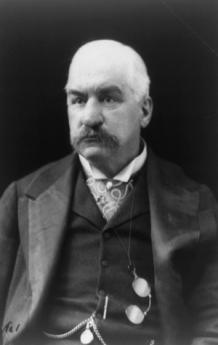
|
| J.P. Morgan |
In the 1840's it was America that was the developing nation, and Europe was the rich old developing country with risk capital looking for opportunities. The situation is reversed now, and we have developing country funds devised for the purpose of investing in risky foreign adventures without knowing much about them. Anthony Drexel, born in Austria but doing business at 3rd and Chestnut Streets, could see all the problems which now would face an American investor wishing to take a flier in, say, the African Central Republic. How are you supposed to tell a good one from a bad one; how do you keep from being fleeced? Today's investor in Private Equity becomes a limited partner of a general partner who may do his best but can look forward to your fees and commissions no matter what his performance turns out to be. If he sits in an office in America, he likely knows little of what is going on in Africa; if he works in Africa, he is beyond your reach in the event of shenanigans. Drexel's solution was to offer a job to young J.P. Morgan.
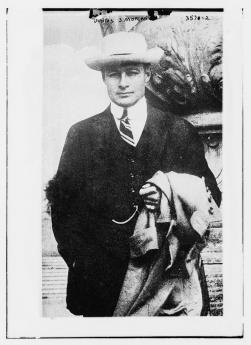
|
| Junius Morgan |
J.P. was to run the New York office of Drexel and Company. His father, Junius Morgan, was to work in London. Junius would gather up investment funds from Dukes, Earls and similar, and send them to America. Meanwhile, J.P. Morgan would have the job of discovering the best investments and overseeing the ventures, which at that time were mostly railroads. At this point, Drexel's approach began to differ from the current investment fund, which mainly tries to give good advice. J.P. was a leader in Wall Street and an informal enforcer of rectitude. As everyone sort of knows, Pierpont Morgan was one mean mama. He may seldom have actually done it, and he certainly never said it in so many words, but his manner radiated the news: if you mess around with one of my clients, I will promptly ruin you. That he was clearly able to do so was sufficient threat. The Wall Street air was filled with his maxims, such as "I shall never do business with a man I don't trust." and "Brains don't make you rich, a character does." He was a tough man, in a tough business. Underneath his pompous maxims, the threat they implied was real.
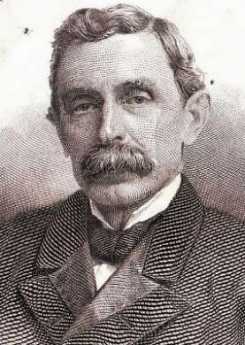
|
| George B. Roberts |
Morgan had a general approach to industries, developed well before the Sherman Antitrust Act of 1895, and best exemplified by his approach to transcontinental telephone systems. Instead of starting a telephone company on the East Coast and expanding it to the rest of the country, he took the approach of encouraging the creation of dozens of small local telephone companies. Watching their performance, he merged with the ones with the best track record and set about quashing those who refused to merge. From his point of view, it sorted out the good ones from the bad ones and created a nation-wide network in an undeveloped country much more rapidly than trying to establish a national champion by building it up. Variations of this simple approach were successful in the steel, coke, banking, and railroad industries. All of these were highly cyclic industries; when there was a general financial crash, it was time to buy up the survivors, and squeeze the hold-outs. Most people regarded a financial panic as something to be avoided at all costs. For the Morgan firm, they were buying opportunities which came along every few years if you saved your cash and waited for them. During the 1929 panic, another financier famously rubbed his hands and remarked that "It would squeeze all the rottenness out of the system."

|
| Corsair |
In the case of the railroad industry, J.P. Morgan set about consolidating small railroads into the New York Central about 1880. In 1885, he reached a famous accommodation with the Pennsylvania Railroad, called the "Corsair Accord" after his yacht on which it was signed. The two actual signatories were George B. Roberts, President of Pennsylvania RR, and Chauncey Depew, acting on behalf of William H. Vanderbilt, President of the New York Central RR, who was sick and eventually died in a few months. The agreement was relatively simple: the two railroad giants would stay out of each other's way. Ten years later, the Sherman Antitrust Act would be enacted, flying the flag of enshrined competition as the national goal in every industry. The Act was mainly directed against Morgan's ideas if not his person since Morgan would unashamedly point to duplication of rail systems as a perfect example of asinine behavior. Political correctness was not his style.
Be Careful What You Wish For

|
| Pulse |
Events at the time of the introduction of the Clinton Health Plan to Congress were a confused jumble, but one vignette stands out in my memory. The five hundred or so members of the secret work group were all invited to the White House for a big party, with saxophones and all. On a television interview at home in Minnesota, Paul Ellwood said he wasn't going to the party. Indeed, he looked rather morose and had little to say. It is clear he had advance notice, before the plan even reached Congress, that things were not going the way he wanted. Since the public, even Congressional leaders, were still unclear just what was to be proposed, Ellwood's dejection, or rejection did not come from them. No one has said so, but it must be presumed the rejection came from his sponsors, the business leaders. Business, in short, had pulled out; responsibility probably lies with no more than half a dozen CEOs who continue to be anonymous fifteen years later.
At that confusing time, the reasoning of the masterminds was obscure. Perhaps they decided HMOs were no good; perhaps an outrageous political demand had been linked to the proposal; or there was to be too much political control, too little business control; or perhaps government costs had been shifted onto the backs of employers; perhaps the whole idea sounded too leftist to be comfortable. And perhaps a lot of other things, who knows. Even today, no one has written a book or even listed a few plain sentences of reminiscence.
What is known is that major business employers immediately launched a nationwide initiative to go ahead with a strong push to convert employer-based plans from fee-for-service to managed care HMOs. This was to be the way employers handled health care they were paying for; the government could do as it liked. It must be admitted it was a bold stroke, quite effectively handled. When you consider the rather uncertain legal right they had to impose a system of health care on their employees, it took more audacity to go ahead than you would suppose they could summon. It was a gamble that the Clinton White House would lack the courage to challenge a private initiative to go ahead with what they had so publicly endorsed, and that providers would be so surprised by the concerted coup that they would hold back legal challenge until evidence of antitrust or conspiracy emerged. It was a sort of Battle of the Bulge in reverse, and it might well have been hugely successful except for one thing they did not anticipate. Their employees almost universally hated HMOs when they tried them out. No one likes to be hustled into something he doesn't understand, no one likes to change doctors, no one like to be told he can't have what he expects to have. Employers expected resistance of this sort, but it simply had to be done to save the fiscal health of the business. Unfortunately, what emerged was that it didn't save much more money than its own extra cost to administer. The hard reality of business life is you regularly have to bully people in order to make any money. But bullying people without making any money is a quick route to dismissal. No wonder there have been no memoirs written.
A quick re-appraisal of the Clinton Health Plan was that the two systems, Medicare for people over sixty-five and employer-based for people under sixty-five, were to be merged into a single system for efficiency and better control. There were to be local, regional, and national governing bodies; evidently, the purpose of the National Business Coalitions for Health was to supply a unified business hierarchy to match it up and down the line. Hated politicians, hated bureaucrats and hated unions could be counted on to apply strong pressures; business would have to remain well informed, sternly disciplined, and speak with a single voice for any hope of surviving in such an environment. It is my surmise that such a prospect seemed to guarantee failure for a business. No, we're sorry, Business would draw a bright line at age sixty-five, and run its own show where it ruled the roost.
Computerizing Medical Care
Note: This article was written in 1999, long before Computerized Medical Insurance Exchanges were such a disaster:
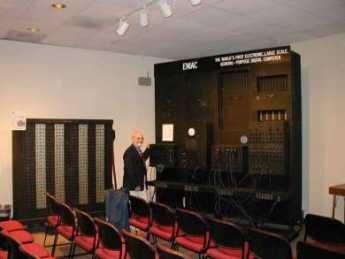
|
| First Computer |
My first encounter with a computer was in 1958, and I have loved them ever since. As president of what called itself the Delaware Valley Hospital Computing Society, I remember giving a dinner speech concluding as follows: "If you want to be happy for a day, get drunk. If you want to be happy for a week, get married. But if you want to be happy for a lifetime, get a computer!" After fifty years, my affection continues. But to be candid, billions of dollars about to be spent on computers in medical care will mostly be wasted. Even worse, like malpractice suits computers will induce behavioral changes in the system costing far more than the directly visible costs.
That's unpopular news at present since the National Business Coalition for Health has launched a major lobbying campaign to persuade Congress to spend an initial billion dollars inducing physicians to maintain an electronic medical record. Various health insurance companies already provide financial incentives to doctors to file electronic claims forms, eventually threatening to reject any claim submitted on paper. The American College of Physicians has established a rather large department to develop programs for physicians to use in their practices; twenty years ago the University of Indiana started much the same thing. The College of Physicians of Philadelphia has spent close to a million dollars on such a project. It is reported that Microsoft Corp. has a massive project underway to supply electronic medical records. It sounds fairly easy to obtain large research grants from the government to devise something, anything, useful in this area. In my own case, training funds really weren't necessary, since I eagerly got into the field when everybody was a beginner. I was just as good a beginner as any other beginner. But let me repeat: the electronic medical record has been in the past and will be for decades, an expensive digression. In health care, creating more administrative work isn't the solution, it is the problem.
For fifty years the problem with an electronic medical record was that it took too much of the doctor's time to complete his part of the input, and then cost him too much to pay employees to do the rest. Presumably, automatic voice recognition and dictation will soon make it possible to record doctor's notes without handwriting or typing. Since, however, the elimination of current paper forms and check-off boxes will create a major problem in organizing the dictation verbiage, it could add five or ten additional years before programmers manage to rearrange dictation material and effectively integrate it into organized form, complete with laboratory results, dictated x-ray and EKG reports, even small images of the original material. Temperature, blood pressure, weight, photographs and the like can all be readily integrated into the stored electronic record, but to do so usefully is an expensive programming project. Doctors are quite right to be anxious they will lose control of the usefulness of their records in order to ease the task of programmers, speed up the sluggish pace of development, and reduce what will surely be an unexpected cost overrun. Storage and retrieval of such records is known to be an achievable but expensive task, which however also risks sacrificing the speed and ease requirements of the medical task it is supposed to serve -- in the name of cost-effectiveness.
Computers are no longer an unfamiliar tool; physicians have altogether too much experience with "vaporware", unrealized promises of convenience, and the damaging effect on the medical quality of the philosophy of Quick and Dirty. To respond to their resistance to design blunders with an accusation of undue conservatism is to provoke an icy stare and gritted teeth. Inevitably, the effective use of automation will require a redesign of workflow with major disintermediation of "gopher" staff; after all, that is how cost savings are to be achieved. That will provoke outcry that physician time is the most expensive component in the process, but unfortunately, physicians will discover Information Specialists with a business background will brush that argument aside. The most overpaid people on the face of the earth are investment bankers, but information consultants have persuaded business executives that inefficiency of the investment process is more expensive than even an investment banker's time. Having been through this themselves, insurance executives are unlikely to pay the slightest attention to physicians dancing to a familiar old tune.
For all that, data input is not the real problem; it's just the first problem. It's in a class with data storage and retrieval, which is expensive and cumbersome when you add a need for instant access and total privacy. But costs will come down steadily, and eventually, we can expect automated fingerprints or other biological identification, and cheap instant retrieval. Doctors will be able to make rounds in the hospital with a computer in their pocket, record telephone calls in their entirety, dial automatically and whatnot. There are problems with wireless transmission inside buildings with steel girders, and legal requirements for signatures on narcotic orders, but if we are determined, these problems can be overcome as easily as they were with electronic check writing and stock brokerage. Cost may top twenty billion dollars in twenty years, but it all can be done if we insist.
But then you encounter the real problem. Information will accumulate in these records in staggering amounts. Even if you resolutely resist demands to have the nurses record every groan, and the orderlies file every laundry slip, the legitimately important medical information will be exposed as the massive heap of transients that they really are. Plaintiff lawyers will insist no scrap of data may be deleted, hospital administrators will insist on compliance, when in fact most of a doctor's concentrated effort is devoted to brushing aside momentarily distracting data in order to see what's going on and react to it instantly. When a quick look doesn't solve the problem, the doctor goes back for additional data. If you disrupt these skills and traditions of coping with information overload, evolved over centuries, you will at best impose frustrating delays on a complex system under pressure, and ultimately inspire elaborate systems of short-cuts. The Armed Forces are famous for paperwork, but even they know better than to ask a pilot for his Social Security number as he starts a bombing run. The hospital nursing profession has already just about collapsed under paperwork pressure. If you see five nurses in a hospital, three of them will be sitting down writing something. The terrible truth is that no one reads it, no one checks it, and ultimately it sits in the record room waiting for a plaintiff lawyer with unlimited time to sieve out some misrecorded misconception or uninformed conclusion. My faith in the computer is such that I feel sure that methods can be devised to produce periodic summaries, automatic alarm signals, and mostly effective prioritization of data elements. Unfortunately, medical care is changing at such a rapid rate that ad hoc automation of physician thought processes cannot keep up with the current pace of change in medical progress. You would think some things would be unthinkable, but since I can remember the organized campaign to suppress the CAT scan as an unnecessary expense, I confidently predict that programmer inability to keep up with some advance in medical care will at times lead to organized outcry that we should slow down the pace of improving medical care, so that computer clerks can keep up with it. But that is only a small part of the issue, which at its center is that physician time will be dissipated and his attention distracted by presenting him with unwieldy amounts of neatly printed, spell-checked, encrypted and de-encrypted, biometrically secure, hierarchically prioritized -- avalanches of data which are irrelevant to the issues of the moment. The goal is not, after all, an electronic record. The local goal is to decrease the cost of medical care by increasing the productivity of the physician, and the overarching goal is high-quality patient care at a reasonable price. Behind all that, since the impetus comes from NBCOH -- the ones paying the insurance premiums -- suggests that the local goal is not so much the improvement of care as oversight reassurance that cares provided has been as good and as cheap as possible. The goal is legitimate, but this cybernation approach looks to be self-defeating by being overly specific.
If the reader has the patience for it, let me now cite a historical example of the third-party tail wagging the medical dog. In this case, third-party health insurance similarly overextended its reach by imposing internal health system changes, trying to facilitate the role of monitoring it externally. Specifically, the system of diagnostic code numbers was changed from one devised by the medical profession for its purposes, into a different coding system devised outside medial profession sponsorship, which seemed to suit the needs of payment agencies better even though it suited medical purposes less. After twenty-five years, it is now clear that third-party payers have shot themselves in the foot on this matter, and everyone is worse off. The topic, please pardon the obscurity, is the diagnostic coding system.
To go back to beginnings, the American Medical Association perceived a need for a diagnostic coding system in the 1920s. Organizing or even merely indexing vast amounts of information about a disease required more specificity than freestyle verbal nomenclature could provide. Quite a distinguished panel of specialists and consultants then produced the Standard Nomenclature of Diseases (SNODO) which in time became the Standard Nomenclature of Diseases and Operations. In order to reduce ambiguity, this system developed a branching-tree code design for anatomy, linked to a branching-tree for causes of disease, ultimately linkable to a branching tree of procedures. These three sets of three-digit codes linked the components together with hyphens (000-000-000). The first digit of each was the most general, as in Digestive, Musculo-skeletal, etc. and subsequent digits were progressively more specific and detailed, as in "Digestive, large intestine, sigmoid colon". The causes of disease would resemble "Infections, bacterial, streptococcal". An example of Procedures would be "Incision, incision, and drainage, drainage and insertion of the drain". In nine digits, it was thus possible to represent " incision, drainage, and insertion of a drain into a streptococcal infection of the sigmoid colon". After a while, the codes grew from three to five and six digits, again repeated three times, so an immensely detailed, unambiguous description might be coded in fifteen digits by a physician who knew the rules but didn't own a codebook. This code was ultimately taken over by the Academy of Pathology, expanded and is called SNAP. The pathologists absolutely refused to give it up.
The rest of the profession gradually yielded to the pressure of hospital administration, who was pressured by the Association of Medical Record Librarians, responding to the views of outside statistical interests, particularly insurance. A simpler, shorter coding system was needed, they felt, concentrating on the thousand most common diseases. The International Classification of Diseases was produced, reducing the millions of SNODO diagnoses to 999 by heavy use of several varieties of "Miscellaneous" or "Not Otherwise Classifiable (NOC)". Since the goal was to count the incidence of common diseases, the coding system was stripped of any logical tree-branching and became a short list of what was most common, starting with 1 and going to 999. In time, of course, the common-ness of conditions changed, and various complaints from various directions forced the ICD to go to 4 digits, then five. Unanticipated conditions or complications eventually required the patchwork of some alpha "modifiers", and the original short hodge-podge became a long and bewildering hodge-podge. Coding accuracy declined markedly, but ho-hum. The health insurance companies paid the bill, no matter what the code said. At another place, we will discuss the entertaining way that Ross Perot became a billionaire out of the computer chaos of Blue Cross and Medicare at this time, but right now the central theme to follow is DRG, Diagnosis Related Groups. Try to follow, please.
By 1980, Medicare was fifteen years old. It was clear that certain things just had to be changed because the excuse that the system was new and untried was beginning to wear thin. The early designers of the system based their payments on auditing a hospital's yearly costs, auditing the proportion of patients who were Medicare beneficiaries, and paying a proportionate share. That was easy and reasonably accurate, but it had a rather significant flaw that it took no account of whether the patients needed to be in the hospital in the first place. Or whether they needed to stay so long. The response they adopted (in the Budget Reconciliation Act of 1983) is a measure of just how desperate they must have felt. Knowing full well how inaccurate the ICD coding system was in practice, it was all there was. Consultants, particularly at Yale, ran computer simulations of various subsets of ICD codes to find a formula that would produce approximately the same hospital payments as the system of cost reimbursement. If memory serves, the original formula was to divide the thousand ICD codes into 27 diagnosis-related groups (DRG). Eventually, the process was tweaked to seventy or eighty groups. Walter McNerny, then Past President of the American Hospital Association told Congress hospitals could live with this system, and promptly we had a system for paying out hundreds of millions of dollars. It was touted as a highly sophisticated advance in the arcane science of hospital reimbursement, so it must have included a lot of deliberate overpayment. I can remember trying to remonstrate with McNerny, who felt he didn't have time for the discussion. Physicians had very little to do with the DRG portion of the 1983 Medicare Amendments because the AMA had long insisted that physicians and hospitals go their separate ways on reimbursement. Russell Roth, who was president of the AMA at the time, recounted many times the episode in the Oval Office, when it was announced to Lyndon Johnson that Dwight D. Eisenhower"was in the next room waiting for him. LBJ excused himself to leave, and on the way out said to Wilbur Cohen, "Give him anything he wants." Things were destined to change, but at least for a very long time, physician and hospital reimbursements were strictly independent.
Healthcare Reform: Looking Ahead (3)
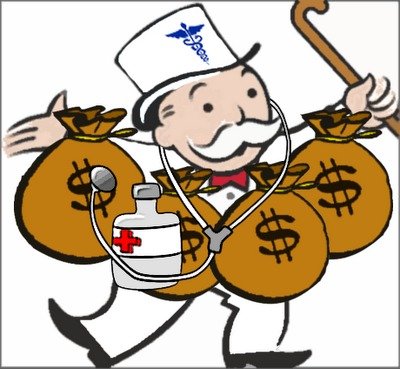
|
For fifty years, turmoil in the health insurance industry has originated in the steel and auto industries. It seems strange that no heroes have come to general public attention, although there may be heroes who are known to insiders; somebody may yet write a book about it. This may be of only passing importance, but the present distress in the American Big Three automakers suggests that unexpected legislative proposals concerning health financing could emerge from that direction. The turmoil in Detroit once centered on the auto industry enjoying windfall profits which labor wanted to share. More recent discord comes from the opposite direction: the automakers now cannot afford to honor those contracts they signed with labor having to do with health benefits.
The contract for the United Auto Workers was certainly generous. Printed up in a little red book for wide distribution, the contract states emphatically that an employee for six months or more will be completely covered for medical expenses for the rest of his life. If Medicare pays some of the cost, that is fine, but if Medicare reduces its benefits, the employer is liable. Some features of this contract may have been changed since it was printed, but it is difficult to imagine what incentives the UAW would have to agree to modifications. Except, of course, the self-interest which emerges when it looks as though the employer might go out of business unless there is some form of relief from wage costs.
To judge what is going to come of this is to judge the likelihood of the various arguments, predictions, and recriminations that are so common in heated disputes. Two things are pretty clear to auto industry outsiders: the UAW contract provides more generous health benefits than almost any other employee group enjoys, while the auto industry has worse earnings than many or most other industries. Consequently, both the employees and the stockholders have an incentive to make adjustments in the auto industry, a situation shared by the steel industry and other major auto suppliers. The form this has seemed to take is to favor some form of national health insurance, in which the taxpayers would take over the obligations of the auto manufacturers. So, look out for proposals from Senators and Congressmen from Michigan, and watch which nominees for U.S. President are favored by the rust-belt political delegations.
Workers in other industries are not certain to go along with such proposals. After all, most people resent it when someone else makes out better than everyone else for decades, and then comes asking for a hand-out.
Money Bags
This little morality tale was told to me by two unrelated sources, one of whom was a staff aide to Wilbur Cohen, the author of the Medicare law. And the other was a high official of Pennsylvania Blue Shield, the appointed administrative agent for Medicare in Pennsylvania. Its relevance to the more recent SNAFU with Insurance Exchanges introducing the world to Obamacare should be fairly obvious.
After Lyndon Johnson rammed the Medicare amendment to the Social Security Act through Congress in 1965, he wasn't shy about drawing attention to it. The press was present in great numbers, with staff officials who had a role in crafting the document, members of Congress, and anyone else who was standing around. The legislation was laid before him and signed with twenty different pens to be presented as mementos to the in-group. Each pen was only used to inscribe about half of one letter of his name, so it was a slow but joyful process. As intended, it got lots and lots of publicity.
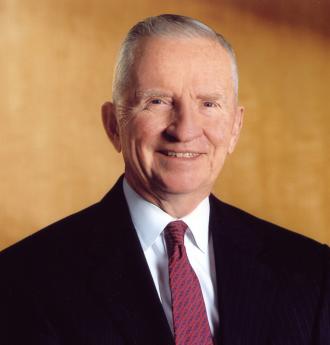 > >
|
| H. Ross Perot |
So, thousands of thankful old folks saw the ceremony on television, though they heard that the law was in effect immediately, and proceeded to dump their medical bills into a shoe box, sending them to Medicare to be paid. Unfortunately, Medicare didn't have an office, a staff, or even a telephone number. These things take time. As fast as they could, the Medicare staff constructed a system of carriers and intermediaries, carriers for part A, and intermediaries for part B. And almost without exception, appointed the local Blue Cross and Blue Shield organizations to be the carriers and intermediaries. Consequently, the organization of Medicare was patterned closely after the organization of the two administrative corporations. Meanwhile, the bills from old folks just kept pouring in through the postal service. It was about all the staff in Washington could do, just to direct the mail out to the local intermediaries and at least get it out of their hair.
Less than a year later, that's how the claims manage to Camp Hill, PA, a little suburban town near Harrisburg. In desperation, Blue Shield had rented a local vacant supermarket and piled the mailbags ten feet high. There were quite a few telephone calls of inquiry, and the old folks were politely told the matter was being looked into. It was beginning to look as though one supermarket wasn't big enough.
Computers were, of course, rented from IBM, who had a policy of renting, not selling, its valuable equipment. Keypunch operators, computer operators were hired, air conditioning was installed, and one team after another of computer programmers was hired -- and fired. Consultants were called, scratched their heads, sent big consultation bills, and turned sadly away. Sorry, but somehow it just doesn't work.
So that's how it happened that one Friday afternoon, a vice-president of Texas Blue Cross named H. Ross Perot came in, accompanied by a fellow with glasses so thick they looked like the bottom of Coca Cola bottles. So far as anyone can remember, the guy with coke-bottle glasses never said one word. The desperate, hopeless mess was explained to Perot, whose salary at that time was rumored to be twenty-five thousand dollars a year, about right for a Blue Cross executive. His background as a kindred Blue Cross person inspired confidence, and the conversation rambled on for an hour or so. Meanwhile, the guy with coke bottles went over to the Penn-Harris Hotel across the street and got to work. By the end of the weekend, he had come back a couple of times, but eventually, would you believe, it really, well it really worked. Contracts were quickly signed, the wheels began to turn, the mailbags in the supermarket began to march through the processing cycle. Blue Shield, the Medicare program, the finances of the nation's elderly, and Lyndon Johnson's reputation -- were all rescued.
As everyone now knows, the Medicare processing contracts made Ross Perot into a billionaire, living on Bermuda in the lap of luxury, eventually upsetting the re-election hopes of George Bush, senior by running for President himself on a third party ticket that had something or other to do with giant sucking sounds. A Congressional investigating committee looked into the outrageous profits Perot had extracted from his homeland's elderly, volleyed and thundered. Whether Perot actually thumbed his nose at them is doubtful, but he certainly was in a position to do so.
Meanwhile, whatever happened to that guy with the coke bottle glasses, no one seems to know.
Immigration and Universal Health Insurance
Among the many articles about the economic wonder of Dubai,
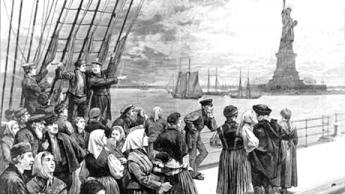
|
| Immigrants |
along the Persian Gulf, is the comment that only 20% of Dubai's residents are citizens of that country. The other 80% seem to be immigrant workers, flocking there to make $2 an hour because at home they can only make $1. America only has 12 million illegal immigrants at the moment, but comparing our problems with such extreme cases sharpens the discussion.
No matter what position you take on the question of universal American health care or universal anything else for that matter, you eventually have to re-examine your beliefs about our national borders. It is plainly absurd to propose that America should provide health care for the whole world, but if we allow essentially unlimited immigration it comes close to the same thing if you provide health care for everyone who is here.
The reason Dubai is a useful example is that we, too, are working our way into the fix of basing our prosperity on immigration we cannot handle. In recently seeking bids for a new roof, the choices I received were from Costa Ricans, Poles, and Puerto Ricans. True, one American citizen did inquire, but he was merely a contractor for some others, who were almost surely illegal migrant workers. Following the advice of a friend, I chose the Costa Ricans because they were rather small in size; my friend said they were less likely to get hurt falling off the roof. Although the situation in Dubai is more advanced, we seem to share the same difficulty that our economy would become pretty unworkable without immigrant labor. That problem for us does introduce an element of fairness into providing health care for people we really do depend on, or you could adopt the line that issues of practicality urge us to find a solution. Either way, you confront a dilemma, a problem offering two solutions or possibilities, of which neither is acceptable. Perhaps at least we could invent a new term, a multi lemma, defined as a problem with lots of solutions, none of which would work.
Quaker Efficiency Expert: Frederick Winslow Taylor 1856-1915

|
| F.W. Taylor |
For at least seventy-five years after Fred Taylor turned it down, any rich smart Philadelphia Quaker attending Phillips Exeter would have been automatically admitted to Harvard. We don't know why he did it, but instead F.W. Taylor just walked a few blocks down the hill from his Germantown house and got a job at the Midvale Steel Company as an apprentice patternmaker. During the twelve years, while he rose to become chief engineer of the company, he took a correspondence course for a degree in mechanical engineering at Stevens Institute and invented a process for making tungsten steel, called high-speed steel. That made Midvale Steel rich, but Taylor was going to make Philadelphia rich, and after that, he was going to make America rich. When he died, he was widely hated.
Evidently his lawyer father greatly admired German efficiency, having sent little Freddy to a famous Prussian boarding school where he was in attendance at the time of the
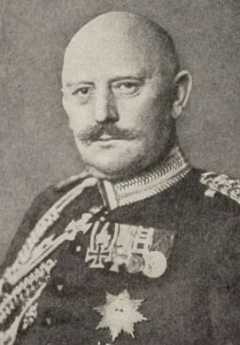
|
| General von Moltke |
Battle of Sedan. General von Moltke had used Prussian efficiency and discipline to defeat those indolent lazy French, and Fred Taylor evidently absorbed and retained these stereotypes for the rest of his life. Whatever he was looking for at Midvale Steel, what shocked him most was to find workers "soldiering on the job". That's a Navy term, by the way, invented by sailors to describe the useless shipboard indolence of any Army they were transporting. Taylor later went to Bethlehem steel, reduced the number of yard workers from 500 to 180, and was promptly fired. It seems that most of the foremen at the plant were owners of local rental houses, which were emptied of tenants when Taylor reduced the workforce. Even management came to mistrust Taylor. When the railroads wanted a rate increase, Louis Brandeis defeated them with the argument that they wouldn't need higher rates if they adopted Taylor's system of efficiency. In his later years after he became enormously rich, he toured the country giving speeches without fees, promoting the doctrine of finding the one best way and then doing everything that way.
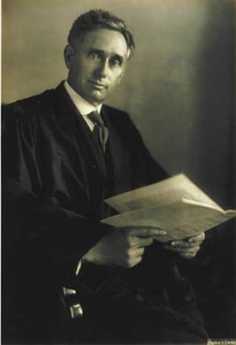
|
| Louis Brandeis |
Over time, Frederick Taylor had come to see that the industrial revolution had proceeded to the factory stage by merely bringing craftsmen indoors, each one treasuring his little trade secrets. Bringing the point of view of the company's owners onto the shop floor, Taylor could see how vastly more profitable the steel company would be if all those malingering tradesmen would stop soldiering on the job. No doubt the young Quaker soon learned that little was to be accomplished by remonstrating with workers, just as bellowing foremen had learned that bullying was also useless. Out of all this familiar scene emerged Taylorism, the idea of paying financial incentives to those who produced more, splitting the rewards of efficiency with the management. It sort of worked, but it didn't work enough to satisfy F.W. Taylor. When he walked around with a stopwatch, he collected the data showing how much more might be produced if the workers were perfectly efficient. Not only did that create the stereotype of the stop-watch efficiency expert, but it also provoked Congressional hearings and federal law against stopwatches which stayed on the books from 1912 to 1949. Although management responded by forming dozens of Taylor Societies to honor the approach, the unions invented the term "Taylorism" and bandied it about as the worst sort of epithet. Curiously, the Taylor approach proved to be enormously appealing both to Lenin and Stalin, who applied it as a central part of their five-year plans and general approach to industrialization. As we now all recognize, the Communist approach was a two-tier system instead of the three-tier system that was needed. It isn't enough to have a class of comrades called planners and another called workers; you need a layer of foremen, sergeants and chief petty officers in the middle. In addition to the elaborate time and motion studies leading to detailed written procedures, there needs to be an institutional memory for the required skills of the trade. In a funny sort of way, Fred Taylor the Quaker may have organized the downfall of the communist state before it was invented.

|
| Herbert Hoover |
Another peculiar outgrowth of Taylorism may be the partisan lines of our own political parties. If you trace the American ideological divide to the 1932 election of Franklin Roosevelt, you can see we are still fighting the battles of the depression. It happens that Herbert Hoover, another Quaker, was totally captivated by Taylorism. Not only that, he was adamant that to get rid of the depression all the country needed was to return to self-reliance, individual responsibility, and hard work. Those were qualities Hoover himself had in superabundance. One telling remark that he probably regretted saying but nonetheless firmly believed was, "If a man hasn't made a million dollars by the time he is forty, he can't amount to much." Franklin Roosevelt had the million all right, but his family had given it to him. The Cadburys and Clarks could have given it to Fred Taylor, too, but he chose to make it himself.
www.Philadelphia-Reflections.com/blog/1296.htm
The Inky
 The Philadelphia Inquirer had a new, local, management. We wished it well. 
|
Brian Tierney, the then-new CEO of the Philadelphia Inquirer -- and Daily News -- recently addressed the Business Roundtable of The Union League. He's quite a peppy fellow, but unlike most fast-talking salesmen, appears to avoid slanting the truth in his reporting about his new job. He fired a lot of facts at the breakfast group in fifteen minutes, and in retrospect touched on several important issues.
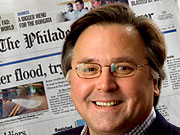
|
| Brian Tierney |
First of all, corporate control. Because the New York Stock Exchange for years prohibited dual classes of ownership, most major newspapers listed their stock elsewhere rather than give up the tight corporate control by minority management. That seems like an unreasonable position at first; the sort of undemocratic tyranny that most editorialists would reflexly criticize. However, Knight Ritter, the former owner of the Inquirer, surrendered to high principle and listed on the NYSE by having a single class of stock. Mr. Tierney didn't explain just how this caused the newspaper chain to lose money, but was cited as an example of the reasons why the newspaper was changed to a privately held arrangement in which the shareholders agree not to sell for five years, and then give the right of first refusal to other members of the group. We'll have to wait for the passage of time to judge what the arguments are and their merits. It's apparently linked to another agreement with more intuitive reasonableness; the stockholders agree not to interfere with the journalism. We'll see in time whether this arrangement leads to journalistic integrity, or whether it leads to one of those famous uproars where an eminent editor lets it go to his head and gets fired amidst a loud chorus of criticism from the editorial pages of other newspapers.

|
| New York Stock Exchange |
And then there is the issue of unionism. Some 2000 of the 2600 employees of the Inquirer are members of some union, and this is the main source of the famous liberalism of the media. The corporations which own newsmedia get trapped into the position of proclaiming their concern for the rights of the working man so frequently that they cannot escape it in their own labor negotiations. In the case of the Inquirer, this tendency led to the conferring of full sick pay to the employees, for 42 weeks a year. While this provision is really intended to be a generous provision for extended rehabilitation from medical catastrophes, it leads to some flagrant abuses from time to time, grimly defended by a rather embarrassed union lawyer. The Inquirer was losing money and needed to lose some more to revive its position by investing in the future. No doubt there was some significant posturing by both sides when these contracts were re-negotiated by the new management. Ultimately, the fairness of the labor agreements, union or otherwise, will be judged by whether the newspaper is able to attract and retain outstanding employees. If not, it will not matter how fair the contracts appear to be.
Both television news and newspapers are slipping. Perhaps that is temporary, perhaps it does not greatly matter what medium delivers our information to us. People under the age of 30 seem to be most distracted by other amusements, and it is anybody's guess whether they will return to the news as they grow up. But one central fact about newspapers emerges. The Inquirer employs 460 journalists and pays $3 million a year to the Associated Press and other sources. The nearest competitor is KYW, which has 38. Whatever you may think about their viewpoints or the nature of the media, this is the main news collection agency in the region by a very large margin. News is created by reporters. If you don't believe that, just watch how the papers shrink during the summer and long holidays. We wish the new owners well, hope they make a ton of money, and hope they don't let success go to their heads.
Stephen Girard, Compulsive Gambler
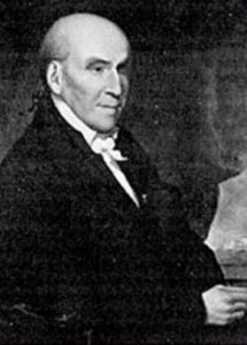
|
| Stephen Girard |
Keep flipping a coin, it's unlikely to come up Heads eighteen times in a row, but it could happen. Once they get to be the richest in the country, most people would quit flipping rather than risk everything on the fifty-fifty chance the next flip will come up Tails. But Robert Morris, William Bingham, Alexander Hamilton, and many others would not only reach the pinnacles of wealth but still gamble everything they owned on a bold chance to get lots more. Stephen Girard was the same way, although in his case he never seemed to lose.
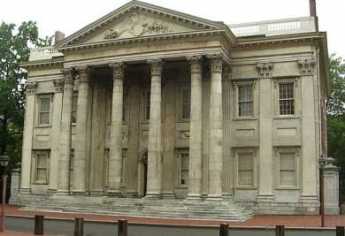
|
| First Bank |
By 1811, Girard was the wealthiest man in America. Among other things, he was the largest stockholder of the First Bank, and ran the largest shipping and merchantile empire in Philadelphia, trading extensively with France and England. From these contacts, he was able to see relationships between France and England, and between England and America, we're going to deteriorate into war. So, Girard cashed out, totally selling his overseas trading interests rather than risk blockades and confiscations. It was a shrewd move, boldly getting out before others could see what he saw. Girard was 61, his wife was permanently hospitalized, and he certainly never had to work again.
As a major stockholder in the bank, Steven Girard was well aware of the strong populist sentiment that the Government had no business running a bank. Although he did his best to preserve the bank, he could see its closure was politically inevitable with Thomas Jefferson as President of the United States, soon to be followed by his Virginia crony, James Madison. When the charter was revoked, Girard took his immense cash horde -- and bought the doomed bank with it. From the Virginians' perspective, they were going to need that money if they went to war with England; while in Girard's view they could not possibly fight a war without a bank to finance it. As matters turned out, the War of 1812 was largely financed by Girard's personal wealth, which ultimately meant that Girard bought the Government's bank with the Government's own money.

|
| Girard Estate Map |
Even making allowances for the fact that the troubles over the national banks were a symptom of the immature financial markets of the nation, which made passive investment difficult for those with rentier ambitions, Girard was clearly a compulsive gambler. Most compulsive gamblers are losers, Girard just happened to be a compulsive winner. His new bank was enormously successful, and as late as 1829 he purchased all of Schuylkill County for its coal discoveries, expressly directing in his will that his heirs were never to sell it. His estate still owns a large part of South Philadelphia, based on the same long foresight of a pretty old man. If you think that's easy to do, just ponder what finally happened to Robert Morris, Haym Salomon, and Alexander Hamilton.
OUR NICE HOUSING BOOM COLLAPSES
Three Basic concepts at work:
- Steep yield curves (the normal situation) are good for banks; inverted curves (a rarity) are not. The 2006 inversion was caused by the bond market accepting abnormally low long-term interest rates, so the "spread" between risky loans and safe ones displayed a diminished "risk premium".
- The Federal Reserve then lowered short-term rates by printing more currency.
This caused an inverted yield curve to return to its normal shape, but the 2006 problem was caused by too much(Chinese) money and this action added to it. The banks were rescued, but the currency was inflated. - This innovative response will probably become a standard readjustment.
But it only keeps the ship from tipping over after a sudden wave; it doesn't address the approaching storm.
 Risk premiums soared in August 2007. What seemed safe, abruptly was risky, and only available at higher prices. 
|
What happened in August?....The "risk premium" --and, consequently, mortgage interest rates-- suddenly went back to normal. About $90 billion of foreclosures seemed probable. We had built far too many houses for people who couldn't afford them. Surplus houses remain for ten years, depressing all real estate prices, making everybody feel poor. Recession, anyone?
What did the Federal Reserve do? To protect the banks, Bernanke dropped short term interest rates. (This steepens the yield curve.) As the panic spread, he dropped rates some more (This floods the country with money). Inflating the currency cheapens the dollar, which robs foreign investors. Foreigners sold stock to escape, prices fell. Seeing prices fall, everybody else sold a stock. 1929, anyone?
So what? They're only foreigners. If Bernanke raises interest rates, we get a recession. If he keeps them low for too long a time, we may get hyperinflation. So, he probably hopes to drop them for a few months, then raise them again. Jimmy Carter got "stagflation" trying this sort of thing. Green eyeshades, anyone?
Remember how naughty "redlining" was? Well, now we bash the banks for "stupid mortgages". Banks issued cheap mortgages for inflated real estate -- and immediately sold the "subprime loans" to investment bankers as "collateralized bonds". We are still uncertain who holds these things, but at least $40 billion were in the hands of Wall Street when the music stopped. Wall Street had to sell perfectly good (?) stock to pay their debts. Blue chips, anyone?
Why was the risk premium so low? The Far and the Middle East had something to do with it. But mainly, securitization led to undue emphasis on statistics. In a housing boom, foreclosure rates seem to go down but are really only being diluted by new loans. The fall of BNP Paribas was a sudden wake-up. Then, the computers of the "quants" exposed a flaw in their programs when they detected heavy selling of perfectly good stock and announced the End of the World..
Thank heaven it happened before things got serious.
WWW.Philadelphia-Reflections.com/blog/1331.htm
Port of Philadelphia
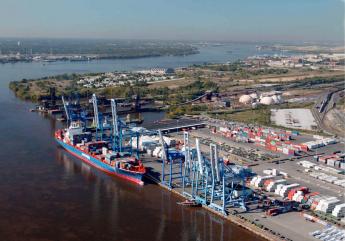
|
| Ports of Philadelphia |
When federal appropriations are doled out, it is a great advantage for the Port of Philadelphia to appeal to six U.S. Senators. However, the overlapping control of port operations can come close to paralysis. In short, we may have less chance of agreement on what we want -- but a greater chance of getting it. Right now, the ports of the world are struggling to adjust to revolutions of containerized cargo and gigantic oil tankers, plus political pressure from concern about the environment.
Some of the main arenas of our gladiator fights are as follows:
DRPA: The Delaware River Port Authority operates several large bridges, the PATCO high-speed subway line, and the cruise terminal, all leading to control of potentially large sources of revenue. The 1992 Congress expanded its charter to include the economic development of the port region.
SJPC: The South Jersey Port Corporation owns two marine terminals in Camden, and is planning a third in Paulsboro.
DSPC: The Delaware State Port Corporation operates the Port of Wilmington, DE.
PRPA: The Philadelphia Regional Port Authority has little to do with city politics, but is an arm of the state government of Pennsylvania, operating 7 marine cargo facilities, and planning more.
In addition, every county, city, and town along the riverbank has some degree of authority. Every business and union involved in regional or international trade is desperate to protect its interest in the politics of port regulation. Lately, the Homeland Security Agency has taken a large role. Scientists, engineers, fishermen, oil refinery operators, economists, and others abound. The news media convey their own opinions and the opinions of others. Opinions abound because most issues about ports are important.
In addition to the traditional cargoes of coal, petroleum, iron ore and forest products, which are mostly declining in importance, the rising cargoes include meat, cocoa beans, and South American fruit. General, or casual, cargo tends to be more valuable than bulk cargo, but greatly complicates the Homeland Security risks. The ratio of imports to exports is important because it is expensive to have a ship return empty. Shippers will, therefore, favor a port where there are expectations of return cargo. Oil tankers are particularly likely to return empty since their ballast is mostly river water; but, who knows, perhaps global warming will make dirty river water seem valuable to some tropical oil producer. A quirky problem is that most of the crude oil entering East Coast ports are currently coming from Nigeria, a notoriously corrupt nation. This has led to a thriving business of car-jacking in the Philadelphia suburbs, with the stolen cars promptly packed in empty containers returning to Africa.
Of the 360 major American ports, the Delaware River ranks second in total tonnage shipped, and eighth in the dollar value of the cargo. Every year, 2600 ships call into our port, which claims to employ 75,000 people. According to Bill McLaughlin of the PRPA, the future of the port will depend on the settlement of three major disputes:
1. Deepening the Channel. The historical natural level of the river is 17 feet, artificially deepened to 40 feet up to the level of the Walt Whitman Bridge. It sludges up by two or three feet every few years, so dredging is a continuous issue. The enlargement of tankers and container ships has led to a need to deepen the channel to 45 feet. It is true that the Wissahickon schist pokes up at Marcus Hook and will have to be blasted out, but mainly the issue is dredging up the gunk on the river bottom, and hauling it away somewhere. In Delaware Bay below Pea Patch Island, the bottom is sandy and hence valuable. The State of Delaware has plans for riverfront development, and would actually like to have the 8 million tons of sand, so no problem. The 7 million tons of clay and silt which must be dredged out of the upper Delaware River channel for a 45-foot depth is more of a problem, but users can be found for most of it. Or so the Pennsylvania representatives maintain; the New Jersey representatives led by Congressman Rob Andrews say it would be an environmental disaster to dump a thimbleful on New Jersey. Feelings get pretty hot in these things. The Haddonfield representative is portrayed as selling out his district in order to further his own state-wide aspirations, acting on the orders of North Jersey politicians who dominate New Jersey politics, who want to lessen competition with the Port of New York, which also shares a border with New Jersey. Feelings are not soothed to see the Port of New York deepening its channel to fifty feet while resisting forty-five in the Delaware port.
The document currently at the center of this interstate dispute is called PCA, the Project Cooperation Agreement. New Jersey won't agree to sign the proposal, which contains clauses to remove the DRPA from authority and replace it with PRPA(essentially transferring control and revenues from Philadelphia to the State of Pennsylvania) as the "non-federal sponsor". PRPA would then enter into a contract with the Army Corps of Engineers to get the work done.The price, probably low-balled, is $219 million, to be compared with the Port of New York's dredging price (probably high-balled) of $50 billion. There are, of course, a great many features of this political negotiation which are unlikely to appear in print.
2. Southport. The grand plan for the Philadelphia Port is to center on an intermodal complex of piers, railroads, and highways which would extend as a continuous terminal from the Walt Whitman Bridge to the old Naval Yard. No doubt this idea is linked to the round-the-world concept of Philadelphia as a way station from India to Vancouver, overcoming the empty return cargo problem by never looking back. Good luck.
3. Monetizing the Port. Like the turnpikes, ports could be sold to private investors. Of course, that could extend to selling the property to foreign investors, triggering the nationalist reaction readily observed when port management was once offered to Abu Dahbi. It could well give a new meaning to the expression, being sold down the river, but who knows maybe it's a good idea. When you criticize motives it never bothers real political pros, because it's simple to say you don't have such motives, and who knows. But the people seriously involved in government finances say they most fear that the do-gooders will be allowed to sell or lease publicly-owned facilities to improve the financial balance sheet. And then the pros will just take the money and use it to pay interest on more borrowing.
WWW.Philadelphia-Reflections.com/blog/1337.htm
Detroit Makes, Philadelphia Takes

|
| Junk Yard |
Let's look at the economics of a junkyard in a business-school way. Derelict auto bodies worth $80 a ton at current prices can be profitably converted into $235 worth of scrap metal, provided the cost of doing so can be kept below $155 a ton. The Camden Iron and Metal company are able to do so for $115 in expenses, and so reaps a profit of $40 a ton. That's not to mention the relief the owner of a useless car feels when the derelict hulk is taken off his hands, or the relief the City feels in ridding itself of thousands of vehicles abandoned in various alleys and public places. Or the worth to the steel mills of being able to produce new metal at a reduced price compared with starting with iron ore and limestone. Or the benefit to our balance of trade from being able to export the motor blocks and transmissions salvaged intact from the wrecks, leading to foreign motor cars of a quality that may, or may not, withstand impartial examination..
Camden Iron and Metal, Inc. is crawling with engineers who help cope with the currently dwindling steel content of contemporary autos, and the consequent increase in non-ferrous metals, glass, plastic and whatever. The most profitable component of the salvage company thus lies in a subsidiary, Innovative Recycling Products, Inc. The copper content of scrap used to be a headache, but is now a revenue center, for example. There once was a time when scrap iron was chopped up and buried in landfills. Nowadays, people are getting rich digging up such landfills and mining the scrap metal. There are other problems you probably wouldn't imagine, such as the disagreeable discovery that lots of those crushed auto bodies have dead dogs locked in their trunks.
It's big business, where a single crane, of which this company has a great many, costs $1 million, and the grinding mills and purifiers cost much more, last only a year, and must be maintained or replaced. There is an increasing plastic content in cars, so that stuff is ground up, pulverized, and burned to produce energy to run the shredding operation. Trucks bringing in a scrap for processing typically run all night on the highways, which reduces the public profile of the salvage operation but increases its 24-hour efficiency. When metal is torn apart, internal friction creates 2000 degree heat, cooled by water, producing huge clouds of steam. The closing of the Bessemer Steel Works reduced the local market for scrap steel, prompting more exports of scrap, and stimulating more search for ways to salvage other ingredients of the scrap. Increasingly, the purification of the raw material has thrust the scrap processors into the role of a pre-processing step in the steel industry. Just as slaughterhouses used to boast of using all of the pig except the squeal, hardly anything is now left of the bodies of discarded autos except for the unattractive scrap heap. Hey, if every housewife admires the idea of household recycling, maybe they can grow to love auto body recyclers.
And then, friends, this is Philadelphia so politics enters in. It has come in the form of visits from the Governor who wants the shredder to move to the waterfront, but who also has a struggle with New Jersey over dredging the river channel to balance in his mind. So, sometimes expensive relocation proposals are made, partially implemented, and then suddenly abandoned for reasons best known in Harrisburg and Trenton. It's conjectured that a central issue in this scrap iron struggle is the high price charged for electric power by New Jersey utility monopolies, tending to drive the scrap salvagers over to Pennsylvania. Since macing utilities is a central feature of modern urban political financing, it's equally possible that Pennsylvania power is produced at a subsidized loss in this struggle, or that New Jersey is concealing its tax burden within electric bills. One would have to know more facts to form an informed judgment, in a situation where facts are hard to come by.
Dog Days
Teddy Roosevelt was a great conservationist, promoting the outdoors life, establishing the National Park Service and so on. At the same time, the walls of Sagamore Hill his home on Oyster Bay were covered with the stuffed heads of big game animals he had personally shot for no better reason than it pleased him to shoot them. This paradox is a convenient symbol of the mixed-up ideas and conflicted attitudes of the public at large about animals. We love them, but we also eat them for dinner.
The two sides of this tension have at their extreme some pretty rich nut cases, or some pretty nutty rich folks, however, you wish to style them. One woman has bought half the country of Paraguay for a nature preserve. On the other extreme, it is said that one wealthy Philadelphia lady has contributed enough money to attract the solicitude the Governor, in the interest of animal rights legislation. Since his political enemies call him "Fast Eddie", that isn't his usual image. It is rumored that he loves his pet terrier, but the center city cynics gathered around lunch tables on Camac Street surmise that his really influential friends could be real estate developers. This all does require a little explaining, which is a full-time occupation in some circles.
Jim Scharnberg was entertaining Inmates the other day about his almost full-time avocation of hunting rabbits in Chester County with a pack of French hounds. Hounds, mind you, not dogs. There are thirty clubs in Chester County alone concentrated on packs of hunting hounds, not to mention all the other counties in the state, and not to mention the hunters on horseback, the fox hunters, the deer hunters, and lots of other kinds of hunters, sometimes with but mostly without guns. Most of these groups have frequent outings together in the countryside, followed by jolly dinners and gatherings, and with newsletters, websites, intermarriages and lots of other associations. Social scientists would call these networks, a trendy phrase, that..
To illustrate how easily networks are formed between hound lovers and politicians, Jim tells the story of living in Manhattan near Gracie Mansion, with his hounds of course. Hounds have to be walked, you see, and the New York police are not particularly friendly to the idea, nor are other inhabitants of the skyscraper canyons, who promote pooper scooper laws and encourage police harassment of hounds. One evening a dog belonging to a native New Yorker was attacked by 27 East River rats. Jim's hounds were unleashed, the dog was rescued. It turned out to belong to Mayor Lindsay, who was quickly persuaded to create special privileges for hounds in Carl Shurtz Park and other East Side grasslands.

|
| French Hounds |
Some members of hound packs are into the whole thing, as Jim is, but most members merely enjoy an excuse to wander in the outdoors with convivial company, or else enjoy the parties afterward; some people just like to write newsletters and send out meeting notices. Everybody likes to talk, that's one sure thing. These things flourish in the exurbs, the farm areas just beyond the edge of development. In Chester County, such farmland is quickly disappearing at the rate of 13,000 acres a year as real estate developers find it is cheaper to build in the countryside than where you have to tear down old buildings to build new ones. Inevitably, the people whose ancestors started the farms 300 years earlier are upset at seeing the old place go. There's an economic issue as well, because farmers need local canneries and wholesalers to take their farm products; these support systems tend to wither as farming gets sparser. And the new neighbors are not accustomed to farm sounds or farm smells. The idea of living next to a pig farm is not softened by the knowledge that the pig farm was there first. Perhaps you get the idea; conflict is how politics gets into it, and these are the networks who will prostrate themselves in the middle of the highway to preserve their heritage. All it takes is a couple of rich ladies to get excited enough to donate lobbying money, and wondrous inanities can get taken seriously. There is now a bill before the Pennsylvania Legislature which in other times would be referred to as a "tickle" bill, one of ten thousand annual bills submitted by legislators to placate constituents, but widely observed never to go anywhere. But put some serious money behind a tickle bill, hire a few consultants who know exactly which levers to pull and which clauses to include for support, and you could have a law to air condition all dog kennels, thus making Pennsylvania the laughing stock of the country's legislative circles. There can be rules governing the size and cleanliness of dog runs, rules about Fido's required breakfast content, and rules to sterilize every domestic animal so that in one generation we will be animal free.
Grown ups are actually saying such things, and legislators are growing afraid to oppose them. Back home in the real estate office, everybody can be all smiles. Because this is how you can get some nice zoning changes if you play your cards right.
Gallatin Part II
Act 1 Gallatin Triumphantly Returns to Congress.
When Washington pardoned the Whiskey Rebels, Gallatin was immediately elected to Congress. It was his payback time for Hamilton and all his works. The desperate Federalists tried to oust him a second time with a Constitutional Amendment, which failed before the force of Gallatin's oratory. Gallatin then threw his influence behind Jefferson's deadlocked congressional contest with Aaron Burr, electing Jefferson and earning his own reward as Secretary of the Treasury. Although elected Vice President, Burr's fury is turned against Hamilton, foreshadowing the coming duel.
Act 2 The Virtuoso Financier.
Jefferson proves hopeless in domestic affairs, so Gallatin essentially takes over that role, just as Hamilton had taken over from Washington, who was another Virginia cavalier adrift in these matters. Gallatin promptly repealed the whiskey tax, cut government expenses, in particular, the million dollars annual tribute to the Barbary pirates, and almost performed magic in financing the Louisiana Purchase together with Stephen Girard and William Bingham.
Act 3 Burr Kills Hamilton
After his Vice President kills the leader of the opposition party, Jefferson's party was on the political defensive. But not Gallatin, who spits out his famous remark, "A majority of both parties seem disposed to deify Hamilton and treat Burr as a murderer. The duel, for a duel, was certainly fair." It is an all-time low moment in the politics of the young nation.
Act 4 Diplomacy or War?
As the Napoleonic wars engulf the whole world, both England and France harass our merchant ships, and cries go up for war. Partly out of a desire to annex Canada in the process, Gallatin sneers at proposals to restrain the fighting Europeans with mere sanctions. His prediction proves dismayingly correct that nothing would come of it except to make our own citizens into smugglers.
Act 5 War It Is.
The First Bank's charter was to expire in 1811, and the bank closed, creating an opportunity for Girard to buy it out and finance the coming war himself. Gallatin was desperate to end the war as quickly as possible, especially after the British burned Washington. To speed matters up, Gallatin took a leave of absence and went off to the peace conference in St. Petersburg himself.
Epilogue in front of the curtain.
Gallatin finally announces his resignation from the longest term of Treasury Secretary in our history. He is seventy years old, three scores and ten. Rather than play golf, he was to spend the last eighteen years of his life in three more careers. As a diplomat, he negotiated both our permanent northern and southern borders. As an academic, he founded the discipline of ethnology with the study of native Indian languages, meanwhile founding New York University. And as a banker, he founded a bank which has since evolved into JPMorgan Chase. After all, a man has to find something to keep himself busy.
Gloomy Future for Banks
 Banks pay depositors modest interest rates, lending to borrowers at higher ones. This is known as lending long and borrowing short. 
|
One of the many Joseph Nicholson's in Philadelphia once surprised me by criticizing Paul A. Volcker as merely a tool of the banks. That distinguished Chairman of the Federal Reserve had always been, and still is, one of my heroes for rescuing the nation from inflation. Instead of wringing his hands at inflation, Volcker had the courage to jolt short-term interest rates right up to 8%. It must have caused a lot of pain to some people, but in retrospect, it was exactly the right thing for him to do. How could anyone complain about his helping the banks when he was helping the world economy for everybody?
The answer is that the old Quaker felt 8% was too little, Volcker should have gone higher. In fact, banks always have comparatively little at stake in whether interest rates are high or low. Their profit lies in maintaining a steep yield curve. Which is to say, as long as short-term rates are safely lower than long-term rates, the banks make a profit. It may be hard to recollect, but typical interest rates facing Volcker were then about 18% for long-term loans. Joe Nicholson had a point when he complained that a 10% profit seemed too generous, but for Volcker to raise short term rates to say 15% would have been seen as the act of a madman. In fact, 8% did turn out to be adequate for curing inflation, so this episode had a happy ending for both inflation and bank profits. Borrowers commonly feel that banks are greedy, but remember they must accumulate reserves. If the yield curve becomes "inverted" for a protracted time (that is if ninety-day rates are higher than ten-year rates) refusing to make loans is the only alternative to spending reserves. If that fails there can be bankruptcy, usually triggered by runs on the bank by depositors in a panic.
Long term rates are set by the bond market, short term rates are set by the Fed. This limits the traditional ability of the Federal Reserve to sustain the viability of banks to one simple tool, keeping short term rates below whatever rates the bond market sets for long loans. In recent years, however, banks have a new competitor for deposits in the form of money market funds. The new formula for what banks want in their Christmas stocking is for the Federal Reserve to set short-term rates well below the market-set rate for long-term rates; but mind you, only slightly below the market-set rates for money market funds. Caught between these two implacable limits, the Federal Reserve has a small room for safe maneuver. It is disquieting to hear that fluctuations of market-set interest rates are very difficult if not impossible to understand. Alan Greenspan called them a "conundrum".
And so, when you see pictures of the Federal Reserve Chairman riding off in a long limousine, he may look fully equal to the responsibility of keeping the world from financial collapse. Someone on the sidewalk once muttered that a man with a beard always looks like he's hiding.
Exit, Pursued by a Bear

|
| John Kastor |
Everybody ends up getting fired in a recent book by John Kastor about recent events at the University of Pennsylvania just like everybody ending up dead in an Elizabethan play. The vital difference, of course, is that the dramatis personae at Penn can still relate to a bewildered audience their own versions of those grand events. To protect himself, the author peppers his book with more footnotes than a Ph.D. thesis. And thousands of stakeholders at the University can now realize that during those eventful times they were as clueless as Rosencranz and Guildenstern.
One basic fact about that institution is that the medical school spends three-quarters of the entire university budget. That leads to grudges in the little law school, the little engineering school, and the little president's office, as they knuckle under to the Golden Rule. The department chairman with the gold makes the rules. Since most of that gold comes from research grants, hence ultimately from the federal government, the medical students and the teaching faculty don't have the same power they had during the Vietnam War era, either. Although medical school tuition imposes a crushing burden on the students and their families, leading to debts close to a quarter of a million dollars apiece, the tuition money doesn't amount to much in the university scheme of things, either. In some schools, tuition amounts to two percent of the medical school budget. You could eliminate the students entirely and not see much difference in the "school".
Unfortunately, when you become dependent on government grants, you find they can suddenly be terminated, or awarded without funding, or held up for several months by Congressional bickering. Meanwhile, there are salaries to pay, contracts to fulfill. Even if you can furlough some of the staff, it's not easy to see what you do about a thirty-year mortgage on a research building when there is a lull in its research funding. If you try to save money, the granting agency will try to get it back; they aren't authorized to make grants to be squirreled away. If you shift money to unauthorized uses, you risk going to jail. And yet, if you don't do something along those lines, the whole enterprise can collapse.
Having said that much to be fair, it is still uncomfortable to see the financial transparency of our most valued nonprofit institutions vanish behind a Byzantine fog of secrecy, out of which arise the magnificent towers of new buildings, and in front of which an occasional limousine is to be observed. No wonder the research scientists feel the constant pressure to produce. A Nobel Prize every ten years, or so, would go a long way toward quieting envious remarks from the liberal arts faculty.
Housed in those ivy towers are three institutions, the teaching hospital, the medical school, and the university, with three boards of trustees, and at least three ruling potentates. At irregular intervals, congressional committees do things to the Budget Reconciliation Act which enrich one of the three components of the institution or suddenly impoverish another, or both. Integration of the three under one governance sounds plausible until you notice how radically different is the mission of each one. You can take a big building away from one component and rent it back to them, and things like that, but you can't do it without starting whispers about Enron. You can gather up surplus funds from one of them during the decade of the eighties, but you have trouble giving it back twenty years later. Officials at Blue Cross come snooping to see if health insurance premiums are passing through this shell game, ultimately paying salaries in the department of English Literature. Everybody distrusts everybody else, somebody sasses somebody, and everybody gets fired.
Nothing unusual about that. It happens at every medical school.
Report Identity Theft to the Secret Service

The Internet provides new blessings, but new problems as well. Identity theft has now ballooned from a rarity to a fairly serious issue. After initial turf confusion, the issue has been assigned to the U.S. Secret Service. If it happens to you, that's where you make your anguished call. (1-877-ID-THEFT) or www.consumer.gov/idtheft
There's a certain logic to regarding identity theft as a modern form of counterfeiting, which has been with us since the days of William Penn. Shirley Vaias, representing the Philadelphia regional Secret Service, recently addressed The Right Angle Club of Philadelphia on the topic. It makes sense to learn the Service is headquartered on Independence Mall, across from the Mint. The crude forms of printing in the 18th Century made counterfeiting easy, and ever since the early days, there's been a race between improvements in technology and improvement in counterfeiting. We now have a paper with little red fibers in it, watermarks, serial numbers, color-shifting inks, microprinting of secret messages in the portraits, special magnetic strips, and probably lots of other clever things we aren't told about. The Bureau of Printing and Engraving is changing the currency, one bill at a time, and recently there was a new ten-dollar bill. A counterfeit version was in circulation within six hours.
ATM machines are equipped with counterfeit-recognition devices, and special gadgets are provided for banks and retail stores, but one detection device traditionally catches most fake bills. After handling huge amounts of currency, bank tellers catch a counterfeit just by the feel of the paper. Color photocopiers are getting better and cheaper, but of course, they can't change the serial numbers, so they aren't as smart as they seem. About one-hundredth of one percent of the currency in circulation appears to be fake, so you are pretty safe, but the possessor of a bad bill is deemed to be the one out of luck. The consequence is that many citizens suspect a bad bill, take it to a bank and have it instantly confiscated without recourse. That would seem to discourage reporting a counterfeit, encourage passing it off to an unsuspecting friend, and overall seems terribly unfair; but it results from the wisdom of the ages. Experience shows honest citizens are indeed tempted to try to pass the money on. While the banks don't enjoy being policemen, the effect is that counterfeits will circulate until they hit a bank, and thus confiscation is fairly comprehensive.
As the printing of money gets more complicated, the special presses needed to produce good money has become a monopoly of certain German companies, who sell the machines to other countries. Some of the American presses thus got into the hands of some Russians, who sold them to the North Koreans. So for a while at least, the North Korean government was printing American currency. It provoked vigorous countermeasures, the nature of which is confidential.
A bill of any denomination costs the government about half a cent to produce and lasts about four years in circulation. When tons of old bills are retired from circulation, the serial numbers are recycled; to an outsider, that sounds like an impossibly tedious job, but they say they do it. There's also the issue of seignorage, a term for the profit the government makes when the paper currency gets destroyed in one way or another, costing less than a cent to replace. Just how profitable the currency business is, cannot be accurately determined, because a lot of it is buried or hidden in mattresses and might someday resurface. But there is a substantial profit, which like any shrewd businessman, the government weighs against the cost of detection. Bail bonds and casinos are big sources of bad money, as could be readily imagined, and hence it is in their interest to get pretty sophisticated (and extremely unpleasant) about detection. On balance, however, it can be expected that legalized gambling in Philadelphia will promote more counterfeiting in the local economy, and hence is an offsetting cost of the tax revenue.
Over the centuries, governments have learned how to cope with counterfeiting, and there is actually much less of it than a century ago. You win some and you lose some; life just goes on. With internet identity theft, however, the criminals are developing techniques faster than governments have learned to combat them, and it is governments who struggle to catch up. Unfortunately, everybody takes a business-like approach to the matter, asking whether the precautions cost more or less than the losses. It would seem that if money continues its migration from paper currency to bookkeeping entries, it will eventually seem unsatisfactory for only one party in a transaction, a bank let us say, to keep the books while the public simply trusts them. Eventually, each individual will be forced to seek the protection of some sort of computerized system keeping the counter-parties honest, on behalf of the public, and to prevent a paralysis of commerce. Identity theft is getting expensive enough to warrant the effort.
Just how to do all that is not too clear. So, in the meantime, just let the Secret Service figure it out.
Commercial Academic Think Tank
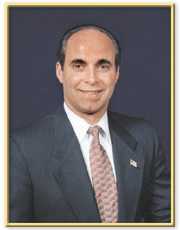
|
| Stephen P. Mullin |
Stephen P. Mullin recently addressed the Right Angle Club of Philadelphia about assorted economic subjects; he is certainly qualified. He was once the only Republican in Mayor Rendell's cabinet, acting first as Finance Director and then as Commerce Director. At first, he doesn't appear extroverted enough to be a politician but quickly demonstrated that he knew the first names of more of the members of the club than the president did, so maybe he does have the innate talents of a politician. Urban political machines don't usually respond cordially to graduates of Exeter and the Wharton School of the University of Pennsylvania. A number of University professors are consultants to the firm, which offers statistical economic advice to the many law firms in town, to philanthropic organizations considering public-interest projects in the region, to government agencies faced with regulating unfamiliar activities, and very likely to anyone else willing to pay for the service of academics, statisticians and analysts. It certainly sounds like a service that governments and philanthropies need, and which the region needs to avail itself of. In a way, it is probably something the University needs, as well. A friend of mine is now retired, but at one time I commuted on the train with an academic administrator of the Wharton School, who was quite obviously disturbed by handing diplomas to students who promptly took jobs which paid those graduates more than he was paid himself. Obviously, such a system cannot persist very long without creating a brain drain, so income supplementation by commercial consulting is a necessary and valuable support for academics. There are, of course, probably some negative features as well.
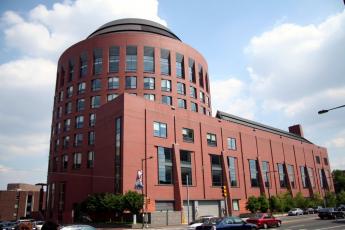
|
| The Wharton School |
It is interesting to hear from Steve how Philadelphia can be variously described. We have, for example, significantly less foreign immigration than other cities. New York, by contrast, has net immigration of about 700,000 persons a year; such forces can quickly transform a city in a variety of ways. The bombing of West Philadelphia during the Goode Administration was news for a while, then vanished from the papers. But it had a shattering effect on Philadelphia commerce, leading to a period of 8 or 9 years when there was essentially no private investment in the city. Philadelphia indeed now needs to have its municipal bonds issued by the state bonding authority, because our own bond rating is so low the extra cost of municipal debt is a significant one. And there is the cost of invisible shifting of power to Harrisburg. An unexpected result is that sales and real estate transfer taxes escalated to make up for property taxes which they could not possibly be raised as much as inflation. Real estate was in big trouble; whether ingenious strategies like the 10-year tax abatement for a new property will be successful in rescuing the real estate industry, remains to be seen. New office towers have been built, but they drain off tenants from older office buildings. We're seeing a massive conversion of older office space into residential apartments, an apparently successful maneuver. But that drains the older residential areas, which leads to -- well, who knows what it will lead to, but it could be slums.
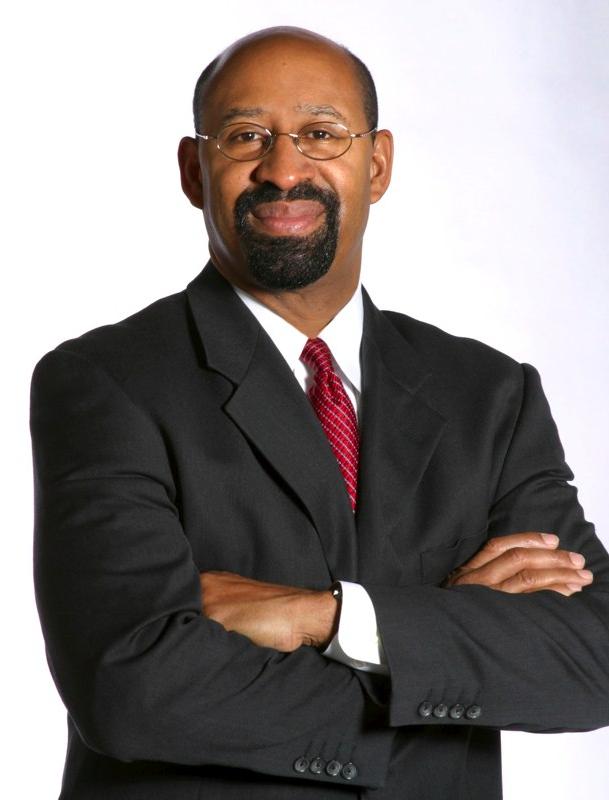
|
| Mayor Michael Nutter |
The traditional hostilities between Philadelphia and its neighbors can be defined in a new way, too. For a century, Philadelphia contributed more tax money to the rest of the state than it received in state services. But in the past 20 years, Philadelphia city has become a net importer of an annual billion dollars -- from the rest of the state. Two or three billion go to the schools, which the rest of the state regards as a deplorable waste in view of the quality of the product. And yet, the most hopeful feature of the situation is the vigor and ingenuity of the attempts being made to rescue the situation. In a certain sense, Mayor Nutter is the candidate of the Wharton School. He may well have some innovative ideas, and academic places like the Wharton School will surely suggest others. It remains to be seen whether Nutter can combine idealism with sufficient ruthlessness to make the city function. Cynical oldtimers will grumble that a mayor has to employ a moderate amount of deception and corruption in order to accomplish his mission. Maybe that overstates things, but it is very certain he must be tough. He's dealing with construction unions who will certainly be tough, and whose interest in sacrificing their own agendas in order to help the schools or street crime -- always fairly small -- is even further impaired by the econometrics that 70% of them live in the suburbs. We wish our new mayor all the best, since he seems smart enough to know what needs to be done, and is definitely smart enough not to drop any bombs on houses. He's smart enough to see that extra city revenue derived from gambling might permit the lowering of wage taxes, and hence an urban business recovery. But is he tenacious enough to stay in office long enough to achieve the balanced result; or will the forces of evil simply kick him out of office before wage taxes can be lowered and gambling discontinued? He won't break his promises, but will they break them for him? Beyond being competent, a city mayor needs to be tougher than the convivial but very mean friends he needs to associate with. He must, for example, decline to run for national office, the traditional way that city machines rid themselves of pointy-headed reformers.
War Dance
History Footnote: Before the white man came, the Iroquois "nation"devised rules still characteristic of our modern political parties. At various times, there were five, six, or seven tribes in the Iroquois confederacy headquartered in upstate New York, allied to each other with fluctuating loyalty. Philadelphia's tribe were Delawares or Leni Lenape, but the most warlike and dominant tribe were the Mohawks. Confederations work best when allied against a common foe. The rest of the time, member tribes mostly beat and cheat each other.
The Philadelphia Democratic Party appeals to a number of minority groups and recent immigrants, but it is more meaningful to think in terms of players. For example, university professors are mostly Democrats, but the teachers union is an active political player. Minorities generally vote Democratic, but the Black Ministers are players. Lawyers are rather evenly divided between Republicans and Democrats, but Plaintiff Trial Lawyers, the ones who sue people for a share of the award, are players.
Some people are players but keep it quiet. Certain rich donors are players but don't want to be known as such. The chiropractors and optometrists claim to be players but would rather not have the truth known. The news media and utility companies come close to denying they are players in spite of abundant evidence otherwise.
Well, the local players had a war dance just before the November 2005 elections; the timing was no accident, and it was publicly described as a SEPTA contract negotiation. The issues had mostly been settled in advance, but the real deal-breaker was health benefits, Blue Cross health insurance paid by the employer to escape income tax and to make the pay packet appear smaller to the taxpayers. Step by step for twenty-five years, employers in the form of the Republican politicians had been keeping up a steady drumbeat, trying to reduce the incentive to overspend health insurance because it seemed free, with resulting increase in employer costs. Slowly, business management convinced a majority of the public that "first-dollar coverage" was a villain, since the person covered by the insurance has no skin in the game. Even party loyalists had to admit that it looked as though the tax exemption of health insurance was injuring the image of labor. That concept carried the slogan of "sending jobs to China", or killing the goose that lays golden eggs in the Rust Belt. Five million Health Savings Accounts were sold in 2005 in spite of state laws hampering this form of health insurance, and from experience it seemed certain that five times that many would be sold if early-adopters reported satisfaction. The surrogate was deductibles and employee contribution to health insurance; just about everybody recognizes the need to make some token contribution to health insurance in order to have skin in the game and keep costs down. But not the SEPTA workers. In 2005, the brotherhood of Septa workers would go on strike for fifty days rather than pay one penny of "give-back" for health insurance. Their energy level was high, they were waving their arms, they were ready to overturn ashcans.
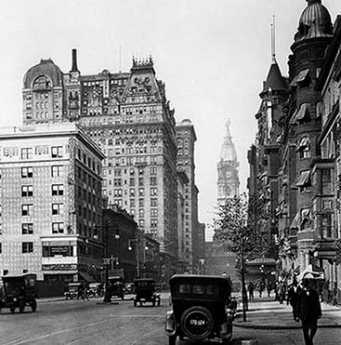
|
| Bellevue |
When union contract negotiations go on for days, all day, the public gets an idea the negotiating table is a shouting match the whole time, with "negotiators" carrying on with tom-toms and tomahawks in an even more physical and extreme model for their supporters on the street corners. For about ten minutes a day, that's true. But then the television people can turn off their lights and the war hawks fan out to talk with their supporters outside the room, which in this case happened to be in the Bellevue Stratford Hotel. Perhaps you didn't know the Pennsylvania Governor has quite a nice set of offices there. Perhaps you haven't noticed that all the parking spaces on the side alleys near the Bellevue "belong" to various politicians. Just try parking there yourself to learn a few facts of Philadelphia life.
In negotiating classes, they teach you never to make the first concession. By that reasoning, no negotiation would ever end. The more practical advice is to forget about any serious bargains until the last day of the contract, or even a couple of days after that. The hard reality is that no one will make a concession while there is time for some invisible player to back out; no one wants to give his constituents time to realize he has sold out their trust or violated their loud, insistent, wholly unrealistic demands. And so in 2005, after the shouting had gone on for some time, and even a real strike began, the Governor finally sauntered into his nice Philadelphia office. Time to get to work.
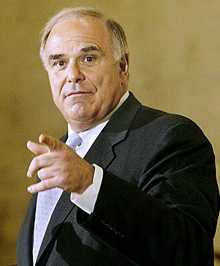
|
| Ed Rendell |
Those who didn't know him made the comment they could almost believe he was a victim of Attention Deficit Disorder. He talked all the time, moved all the time, and apparently showered all the time. That is, he was in and out of sight all night, but invariably reappeared with fresh shirts, clean shaves, and sharp creases. His aides confided he wasn't very good at "detail work", which is to say he conducted the whole affair on a primeval level of dominance, bluster, charm and implied threat. Don't bother me with facts. Mayor Street, on the other hand, would come in and mumble something incoherent, and then had to leave for an important engagement. Word came in that the school teachers felt they really had to pay a small health insurance deductible, and it wasn't so bad. Foo, no guts.
Somewhere along the line, the newspapers started to echo that deductibles had their merits. Foo, bunch of Communists. The black ministers were reported to feel that if their people all had to pay deductibles, why couldn't the transit workers. Bah, bunch of muddleheads. In the hubbub, someone asked what Andy Stern thought. The trial lawyers didn't have as much to say as they once did; SEPTA had reduced liability costs by $87 million through adamantly refusing to settle any case without going to court. Paper tigers. What about chiropractic benefits, we demand the inclusion of chiropractic benefits. No, said SEPTA, we aren't going to agree to any of that sort of thing. Well, what about twenty visits a year to chiropractors?
One by one, the other players deserted the SEPTA workers. The message from the other tribes in the confederation seemed to be, get what you can for SEPTA, but stop the strike by election day. The Governor produced the razzle-dazzle, a loan to the city to pre-pay the Blue Cross premium, in return for which Blue Cross would reduce the premium. The effect of that was to produce enough cash to appear to add ten cents an hour to the pay packet. We'll have to wait a year to see how this money gets restored to Blue Cross, but that's the general idea.
The strike was over, hurray. The next day, the Democrat party elected Democratic governors in New Jersey and Virginia, defeated some California amendments which would have hurt the trial lawyers and teachers unions. Surely, someone in the Democrat party nationally was telling himself that caving on the Philadelphia transit strike was a small price to pay for that.
Curing Stagflation

|
| Walter Baghot |
On Wednesday April 30, 2008 the Federal Reserve lowered short term interest rates by 0.25% (to 2%) . It had been rumored they would lower rates even more, but it became more than a rumor that two members of the Open Market Committee resisted. Paul Volcker the former chairman gave a speech describing what he had successfully done in similar circumstances, which was to raise interest rates, not lower them. On the same day, Brian Westbury published an opinion piece in the Wall Street Journal, advocating that the Federal Reserve lift interest rates back to their natural rate, which is somewhere north of 5%. A day earlier, John L. Chapman had written in the same publication that the dollar needed strengthening, which is effectively the same as raising national interest rates. All of these dissenters are more fearful of stagflation than the recession, or November elections. All of them are echoing the classic opinion of Walter Bagehot, editor of The Economist between 1860 and 1877 . Nevertheless, the people entrusted to act are still lowering interest rates, and the rest of us retreat before their superior information sources.
Bagehot (pronounced baa-joe) always made his points in few words. The solution to what is now known as stagflation is to raise interest rates to punitive levels while cutting taxes. Punitive levels are of course punishing, and unpopular. Furthermore, since the Democratic candidates for President have boxed themselves into advocacy of raising taxes because President George W. Bush had cut them, the tax-cutting part of Bagehot's terse prescription is also opposed, D versus R. To explain a little, stagflation defines a situation where there is simultaneously rising unemployment and rising inflation. That's not supposed to happen according to the rule of Phillips Curve. The theory behind the Bagehot approach is that the unemployment in this circumstance is caused by the inflation, so you must attack the inflation with higher interest rates, even though a lot of people will be fearful that unemployment is caused by other things, and will go up. Raising interest rates will likely worsen unemployment temporarily, so it takes grit to do it and keep doing it. The industry must be encouraged to invest by dangling inflated untaxed profits in front of its greedy nose. Class warfare opposition is likely to be fierce and unfair. This whole situation prompted one observer to wish we had Gerald Ford back as President because he was the only President in fifty years to have the country's interest at heart. That's perhaps extreme, but the general reaction is supportable.
It begins to look as though some economist ought to make himself famous with a curve. Going from left to right, it would show that inflating the currency by lowering interest rates will initially help a recession and unemployment. But above a certain level, continued inflating will generate more unemployment by injuring employers. Let's call it a Bagehot Curve.
Roebling
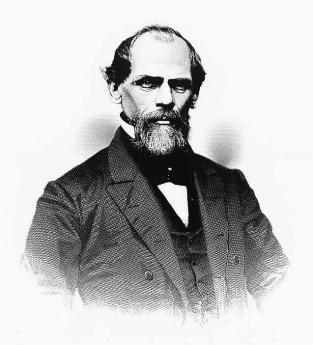
|
| John Roebling |
The common image of John A. Roebling comes across a little hazy about details, but seems to consist of going down with the Titanic at the age of 31, with being born in Prussia in 1837, with getting the "bends" while building the Brooklyn Bridge, and first sighting General Robert E. Lee's invading army from a balloon, then dragging a cannon up Little Round Top. The obvious inconsistencies in this image do not prove they are fictitious, they prove that Roebling was several people. Mostly this composite centers on Johann Augustus Roebling and his three sons, but spreads out to a large and highly talented family. Roebling achievements are not those of a bee, but of a beehive.
Johann was a younger child in a large Prussian family living a hundred miles south of Berlin. The region had been ruled under Napoleon for seven years, creating much of the centralized governance we now call "Prussian". Following centralized orders, its school had been designated to be an expert in science and engineering. Johann was particularly good at math and was singled out for intensive training in math and science, later sent to Berlin for advanced training in engineering. While there, he fell under the influence of the philosopher Hegel, who proclaimed that anyone could be anything he wanted to be, but opportunities were particularly good in America. Since Berlin went on to become the world center of electrical engineering, the world would probably have heard more of Johann Augustus Roebling even if he had remained at home; but he was going to do big things in the steel industry, so off he went to Pittsburgh. Things went rather well for him there, especially after he substituted wire rope for hemp rope in pulling canal boats over the Allegheny mountains. From that point on, John A. Roebling concentrated on perfecting and manufacturing wire cable, on which he held several key patents, and moved his business to the head of the Delaware Bay at Trenton, strategic in sales location between New York and Philadelphia.
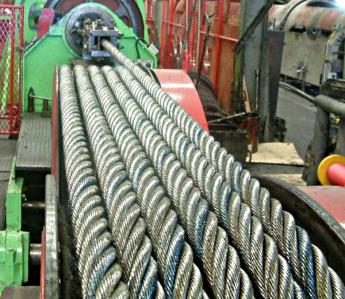
|
| Wire Rope Factory |
Although his company would eventually build an open hearth steel mill, the Roebling enterprise always retained a central focus on steel cables made of steel wires bound together for flexibility and strength. The plant next door in Trenton, the Cooper, Hewitt Co., created the steel I-beam and thus was central in the construction of skyscrapers. Roebling supplied steel cable for elevators, without which skyscrapers would have been limited to six or eight stories. The wires within the cables start from what we can now visualize as the child's toy Slinkies (also a Roebling product, by the way). The trick to making such coils into cables was to find a way to straighten them out, which Roebling devised and patented, using a wheel arrangement to twist the wire as it unwound. Later, the wires were galvanized and compressed together. If the cables were used to carry electricity, it was necessary to cover the cable with rubber insulation as part of the manufacturing process. Eventually, over fifty different processes needed to be perfected and employed to create large quantities of non-brittle uniform cable product at low prices. Apparently, the central problem in manufacture was to smooth off burrs in the wire and meanwhile keep the assembly scrupulously clean. Roebling learned how to overcome all of the many problems in this deceptively simple-looking process, which eventually meant that the main problems remaining were in designing factories rather than designing cables. During the taming of the west, he produced barbed wire; during the rise of mass agriculture, he devised ways to use wire binders for sheaves of wheat. During the rise of electricity, he provided insulated wire and cable, first for the telegraph and then for the telephone. He even recognized the best business model; make huge profits during the first few years of a new product, then cut prices. By far the most famous product of the Roebling company was the suspension cable in suspension bridges.
Indeed, many people associate the Roebling name with bridge building, even though wire cable was and continued to be the central activity of the company. It was characteristic of the Roebling energy and engineering skill that he saw that if he wanted to sell cable, he had to show others how to use it, and he essentially took over the design and construction oversight of the twelve largest suspension bridges in the country. Unfortunately, his foot was crushed in a construction accident and when he died, the building of the Brooklyn Bridge had to be turned over to his son Washington Roebling. Washington, in turn, became badly crippled by caisson disease, the "bends", and hands-on oversight was conducted in large part by his wife, following meticulous instructions by her partially blinded husband.

|
| Brooklyn Bridge |
The work of building and designing factories for the company fell to Washington's brother Charles, and since the company was constantly changing focus in order to exploit new product lines, it was a prodigious task, always under time pressure. What's more, the main factories burned to the ground at least six different times, probably from arson in at least several cases. The Roeblings all worked like dogs for endless hours, well into old age. There was comparatively little ostentatious display of wealth, and when US Steel offered to buy them out, they declined an offer equivalent to one-fifth of the value of US Steel itself. That was during an economic downturn; Roebling was probably worth half of the value of US Steel. Andrew Carnegie might sell out, but not the Roeblings.
George Washington once reversed the Revolutionary War just up the street from the Roebling plant, and John Roebling's son was named after him. Roebling was a patriot and an active Republican. But there was enough Prussian in him to prefer German workmen and to hate unions. When the company grew large, he was forced to hire immigrants from what he called the Hapsburg Empire, although he never completely trusted them. Judging from his writing, he regarded unions as merely trying to take away control of the company without investing in it, certainly without earning it. Surviving numerous fires, recessions, and wartime demands for expansion without profit, it was plainly obvious that when times were tough and money had to be raised, there was no one except the owner to produce it. It is not difficult to imagine the hatred in the minds of union leaders, confronting a family that regarded lowered wages during the depression as normal and necessary. In the Roebling view, standing up to worker protests in such circumstances was simply a test of character, something an owner simply had to find the courage to do.
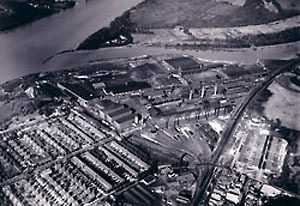
|
| Roebling Village 1930 |
When it became necessary to build a huge new plant at some distance downriver, the Roeblings had to contend with a shortage of labor in a region without houses. So they built a company town which they declined to name Roebling but the railroad named the stop Roebling anyway. Using engineering skill that had made Roebling the world leader, the homes were inexpensive but elegant for the time and even today. The company had to build stores, streets, schools, and everything else a town needed. The new headaches of this project took time and attention away from the central business of making steel cables, and Washington Roebling once wrote it was enough to drive you crazy.
So, guess what, the unions felt they had to take the lead in complaining and forcing the Roeblings to make changes. Guess what happened next; the Roeblings just sold it and walked away.
REFERENCES
| The Company Town: The Industrial Edens and Satanic Mills That Shaped the American Economy, Hardy Green ASIN: B003XKN7MW | Amazon |
Rise and Fall of Books
| ||
| The Library Company of Philadelphia |
John C. Van Horne, the current director of the Library Company of Philadelphia recently told the Right Angle Club of the history of his institution. It was an interesting description of an important evolution from Ben Franklin's original idea to what it is today: a non-circulating research library, with a focus on 18th and 19th Century books, particularly those dealing with the founding of the nation, and, African American studies. Some of Mr. Van Horne's most interesting remarks were incidental to a rather offhand analysis of the rise and decline of books. One suspects he has been thinking about this topic so long it creeps into almost anything else he says.
 |
| Join or Die snake |
Franklin devised the idea of having fifty of his friends subscribe a pool of money to purchase, originally, 375 books which they shared. The members were mainly artisans and the books were heavily concentrated in practical matters of use in their trades. In time, annual contributions were solicited for new acquisitions, and the public was invited to share the library. At present, a membership costs $200, and annual dues are $50. Somewhere along the line, someone took the famous cartoon of the snake cut into 13 pieces, and applied its motto to membership solicitations: "Join or die." For sixteen years, the Library Company was the Library of Congress, but it was also a museum of odd artifacts donated by the townsfolk, as well as the workplace where Franklin conducted his famous experiments on electricity. Moving between the second floor of Carpenters Hall to its own building on 5th Street, it next made an unfortunate move to South Broad Street after James and Phoebe Rush donated the Ridgeway Library. That building was particularly handsome, but bad guesses as to the future demographics of South Philadelphia left it stranded until modified operations finally moved to the present location on Locust Street west of 13th. More recently, it also acquired the old Cassatt mansion next door, using it to house visiting scholars in residence, and sharing some activities with the Historical Society of Pennsylvania on its eastern side.
 |
| Old Pictures of the Library Company of Philadelphia |
The notion of the Library Company as the oldest library in the country tends to generate reflections about the rise of libraries, of books, and publications in general. Prior to 1800, only a scattering of pamphlets and books were printed in America or in the world for that matter, compared with the huge flowering of books, libraries, and authorship which were to characterize the 19th Century. Education and literacy spread, encouraged by the Industrial Revolution applying its transformative power to the industry of publishing. All of this lasted about a hundred fifty years, and we now can see publishing in severe decline with an uncertain future. It's true that millions of books are still printed, and hundreds of thousands of authors are making some sort of living. But profitability is sharply declining, and competitive media are flourishing. Books will persist for quite a while, but it is obvious that unknowable upheavals are going to come. The future role of libraries is particularly questionable.
Rather than speculate about the internet and electronic media, it may be helpful to regard industries as having a normal life span which cannot be indefinitely extended by rescue efforts. No purpose would be served by hastening the decline of publishing, but things may work out better if we ask ourselves how we should best predict and accommodate its impending creative transformation.
www.Philadelphia-Reflections.com/blog/1470.htm
Buying Corporate America with Cheap Money

|
| The Rock of Gibralter |
In the summer of 2008 Philadelphia was astonished to read that the rock of Gibraltar, our family controlled Rohm and Haas had been sold to Dow Chemical company for $15.4 billion; corporate control will shift to Michigan. A week later, the Hercules Powder Company of Wilmington was sold, and then Budweiser Beer was sold for $56billion to a Belgian firm. The big old philanthropic families were cashing out.
While it may be true that taxes and philanthropic inclinations will lead this cash mountain to be transferred to non-profit foundations of benefit to the local communities, these sales are all a blow to the prestige and vitality of the cities which were once power centers of the world. Worse still, these prominent families with access to expert investment opinion may have reached the conclusion that it was better to have the cash than the business, or better to have the flexibility to shift the cash to more promising investment opportunities. Maybe they seek to diversify, or flee to gold, or invest in commodities, the next coming bubble. To what extent the falling value of the dollar motivated the purchase by foreigners or through foreign intermediaries is unclear, but it would surely be a consideration for foreigners to ponder. Worse still, these families may have decided they need to transfer more of their assets abroad. The glamorous investment advisors to large universities and major foundations are certainly advising their clients to invest much or even most of their funds to foreign investments.
Under the circumstances, one would wish that foreign investors would shrug off considerations of national pride and concentrate purely on the economics of their transactions. But not likely; just as we grieve to lose these brand names, they must be thrilled to show off their new possessions, and eventually to use their control to shift power. The Secretary of the Treasury makes the unhelpful declaration that a strong dollar is important since he does not need to continue that avoiding a steep recession is more important.
That's the way it is. Keynesian economics waters the currency causes a fire sale of assets and fires the flames of inflation. Now, what?
John Head, His Book of Account, 1718-1753
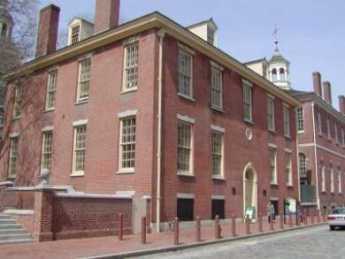
|
| American Philosophical Society |
Jay Robert Stiefel of of the Friends Advisory Board to the Library of the American Philosophical Society entertained the Right Angle Club at lunch recently, and among other things managed a brilliant demonstration of what real scholarship can accomplish. It's hard to imagine why the Vaux family, who lived on the grounds of what is now the Chestnut Hill Hospital and occasionally rode in Bentleys to the local train station, would keep a book of receipts of their cabinet maker ancestor for nearly three hundred years. But they did, and it's even harder to see why Jay Stiefel would devote long hours to puzzling over the receipts and payments for cabinets and clock cases of a 1720 joiner. Somehow he recognized that the shop activities of a wilderness village of 5000 residents encoded an important story of the Industrial Revolution, the economic difficulties of colonies, and the foundations of modern commerce. Just as the Rosetta stone told a story for thousands of years that no one troubled to read, John Head's account book told another one that sat unnoticed on that library shelf for six generations.
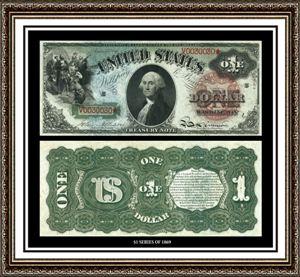
|
| Colonial Money |
The first story is an obvious one. Money in colonial days was mainly an entry in everybody's account book; today it is mainly an entry in computers. In the intervening three centuries, coins and currency made an appearance, flourished for a while as the tangible symbol of money, and then declined. Although Great Britain did not totally prohibit paper money in the colonies until 1775, in John Head's day, from 1718 to 1754, paper money was scarce and coins hard to come by. Because it was so easy to counterfeit paper money on the crude printing presses of the day, paper money was always questionable. Meanwhile, the balance of trade was so heavily in the direction of the colonies that the balance of payments was toward England. What few coins there were, quickly disappeared back to England, while local colonial commerce nearly strangled. The Quakers of Philadelphia all maintained careful books of account, and when it seemed a transaction was completed, the individual account books of buyer and seller were "squared". The credit default swap "crisis" of 2008 could be said to be a sharp reminder that we have returned to bookkeeping entries, but have badly neglected the Quaker process of squaring accounts. As the general public slowly acquires computer power of its own, it is slowly recognizing how far the banks, telephone companies, and department stores have wandered from routine mutual account reconciliation.

|
| John Head's Account Book |
From John Head's careful notations we learn it was routine for payment to be stretched out for months, but no interest was charged for late payment and no discounts were offered for ready money. It would be another century before it became routinely apparent that interest was the rent charged for money and the risk of intervening inflation, before final payment. In this way, artisans learned to be bankers.
And artisans learned to be merchants, too. In the little village of Philadelphia, chairs became part of the monetary system. In bartering cabinets for the money, John Head did not make chairs in his shop at 3rd and Mulberry (Arch Street) but would take them in partial payment for a cabinet, and then sell the chairs for the money. Many artisans made single components but nearly everyone was forced into bartering general furniture. Nobody was paid a salary. Indentured servants, apprenticeships trading labor for training, and even slavery benignly conducted, can be partially seen as efforts to construct an industrial society without payrolls. Everybody was in daily commerce with everybody else. Out of this constant trading came the efficiency step for which Quakers are famous: one price, no haggling.
One other thing jumps out at the modern reader from this book of account. No taxes. When taxes came, we had a revolution.
www.Philadelphia-Reflections.com/blog/1517.htm
New Museum of Chemical Heritage
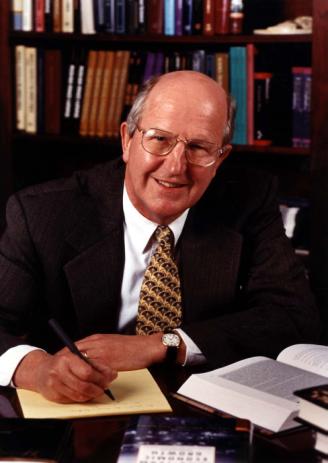
|
| Arnold Thackray |
Eighty percent of the ethical drug industry is located within a hundred miles of Philadelphia, and the whole chemical industry has had its center here for two centuries. The chemical industry is the region's largest manufacturer, now that locomotives and beer brewing have come and gone, but its profile remains low. In fact, chemists personally have a low profile too and harbor a smoldering annoyance about it. No one has been more determined to change that nerdy image than Arnold Thackray, the recently retired President of the Chemical Heritage Foundation. He's not only a big idea man but bubbles with energy and persuasiveness. That largely accounts for the fact that CHF has the second largest endowment among public institutions in Philadelphia, the best library of chemical history in the world, and a growing reputation for fine art concentrated in the field. That's not enough for him, so it came about that a new museum was envisioned, funded and created. But not built; building it was assigned to Miriam Schaefer, a famous go-getter who had the unusual qualification of being squeamish about chemistry. It was her assigned task to find a way to make chemistry exciting to people who were not instinctively excited by it, just exactly because she was the world's authority on that point of view. What was vital was that she was the sort of person who can't resist a challenge, and was capable of thinking, well, big.
With the unlimited backing of Arnold and his board and their almost unlimited financial support, Miriam set about soliciting big ideas from uninhibited people all over the world, and some of their suggestions were even a little too wild to be acceptable. But since the whole idea was to awaken the enthusiasm of anybody, however sullen, who happens to shuffle through the museum, many outlandish suggestions were forced through the filter of a skeptical, conservative, Philadelphia establishment. The result is a series of pleasant surprises, ranging from fine art with a focus on alchemists trying to make gold out of lead, to astonishing computerized graphic displays of the elements of the periodic table fifty feet high, to depictions of Joseph Priestly known as the father of chemistry, a personal friend of Benjamin Franklin, the founder of the Unitarian Church, and a resident of Philadelphia. There's Arnold Beckman's original Beckman spectrophotometer which made hundreds of millions of dollars, was a major factor in the Twentieth century blossoming of biochemistry, and is here shown to be a clever elaboration of a simple idea. Meanwhile, the museum is housed in a massive old bank building, with it is interior reamed out and replaced with as much transparent glass as could support the weight. Inga Saffron the architectural critic, more than foamed over with praise in her review of just the structure itself. Don't neglect to notice the stunning portrait of Gay-Lussac, the man who discovered that water is H2O. The pigments of his portrait were mixed with beeswax, and with clever lighting have an astonishing luminosity.
The museum is part of an emerging conference center, which should attract audiences of chemists for decades. But that's not entirely the whole idea. The underlying vision is to convince those skeptical, non-chemical bozos that not only are chemists rather richer than the rest of us, and smarter, but clever and fascinating, too. Go visit this museum, before everyone else does.
 |  |  |
 |  |
Mercantilism Dies Hard
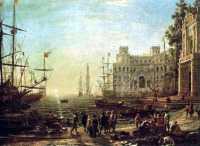
|
| Mercantilism to Americans |
Whatever mercantilism was supposed to mean can be debated by captive college students; mercantilism to Americans is and was just a bad thing having to do with economics, mentioned only when the speaker is searching for an epithet. Our present understanding of the mercantilist term is that brutal government action, even war, was employed to benefit favored citizen merchants, while the economics of a whole nation of consumers was subverted toward enhancing state power. All of this rapacity was for the betterment of one nation at the expense of its neighbors, and at the expense of its colonies. The surprisingly vague but more modern term of fascism is often substituted, to denote evil uses of government to promote the interest of combined military and industrial elite, to the general disadvantage of everyone else. Because so many opponents of mercantilism were upset about specific forms of mercantilist activity, Adam Smith is associated with the idea that mercantilism was the opposite of international free trade, and the American founding father are associated with the idea that mercantilism embodied everything we disliked about colonialism. Some prominent 18th Century leaders constructed a body of theory to defend mercantilism and firmly established the idea that the whole approach was founded on long-discredited sophistry. In recent times, the only reputable economist to defend parts of mercantilism was John Maynard Keynes, who approved of the idea of emphasizing third-world exports in order to assist developing countries into a modern economy. Whatever is the underlying idea behind this mercantilist idea that has caused so much trouble, and includes so many disconnected features?
Allow an amateur theory. In my view the fundamental misconception underlying mercantilism was the idea that economic relations between individuals and nations are a zero-sum game; what I gain must be at the expense of someone else's loss. Almost every child believes that many or even most everyday transactions seem to confirm it, and vast multitudes of mankind believe it to the end of their days. But as part of the Industrial Revolution, the counter-intuitive realization began to spread that cooperative behavior, within limits, could sometimes result in all participants becoming better off, harming no one. Perhaps it was even a universal idea. Adam Smith popularized the idea that when two parties freely participate in the free trade of a marketplace, each one can come away from the trade feeling better off; one party would rather have the goods, the other party would rather have the money, and they trade. Multiplied millions of times, the expansion of free trade would enrich whole nations, even the whole world. George Washington may not have understood all that, but he did know that England was injuring him with rules about insisting British subjects must conduct all foreign trade in British sailing vessels, must not manufacture locally, must do this, must not do that.
Exporting was good, importing was bad, manufacturing was to be concentrated in the mother country, consuming was to be discouraged -- what was the unifying theory behind all this? It would seem to have been the gold standard. Gold was durable, and its supply was limited. It had certain undeniable advantages, but its overall effect was to restrain industrial progress. If the economy is constantly expanding, but the supply of gold is relatively limited, the price or value of everything will go steadily down over time. In George Washington's time that was particularly irksome with regard to the value of his plantation, and his vast land holdings of Ohio land. It was also true of everything else that was reasonably durable. If everything is measured in gold, and gold is limited, then the accumulation of gold is ultimately the only way to accumulate wealth. The English nobility who were profiting from the system might not perceive it, but the colonists could perceive it in their bones. Small wonder that modern banking, economics and innovative finance took root in the American colonies. If not first, at least most vigorously. Small wonder we had a revolution men would die for, while the British were merely annoyed and mystified.
Vast areas of Asia, Africa and the Middle East are still committed to the idea that the only way to get rich is to steal from others; since everyone wants to get rich, everyone steals. Someone has reduced this idea to a simple game theory called the Prisoner's Choice. If two prisoners tattle on each other, both will be severely punished. If both prisoners refuse to testify, both will go free. If one tattles and the other remains mum, the tattler will go free and the loyal comrade will get hanged. Reduced to its simplest level in a series of repeated games, the theory states that it's better for everybody to cooperate most of the time, but you must be willing to play tit for tat if the other party cheats. Be cooperative as much as you can, but never forget to wallop a cheater, and then forgive him later so he can have a chance to play nice. Lots of people will think you are a sucker if you play nice, so, unfortunately, it is necessary to retaliate -- swiftly and painfully -- when someone cheats. Centuries of American history are explainable with this simple game theory.
And not just with tribesmen and Nazis. When Winston Churchill finally realized that the Bretton Woods Conference was going to mean the end of the British Empire, he was almost tearfully plaintive with his friend Frank Roosevelt, but he said he understood.
And six years later, when Churchill's protege Anthony Eden invaded Egypt over the Suez Canal, Dwight Eisenhower the hero of the Normandy Invasion that saved England, suddenly turned nasty. England would immediately abandon that invasion, or Eisenhower would foreclose on British debts and ruin them.
That was the end of British colonialism, and in a sense, it was the final end of the Revolutionary War.
Merging Cities With Their Suburbs
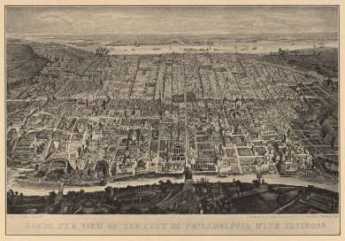
|
| Philadelphia 1854 |
When the City of Philadelphia turned into the County of Philadelphia (or vice versa) in 1854, the area had about 150,000 residents in 1850 but 500,000 in 1860. It qualified as one of the largest cities in America at the time, but what we today call middle-sized cities are about that same size. As a generalization, when a thriving American city approaches a size of about half a million, the business community often gets the idea that the city should expand its limits by annexing the neighboring districts. And, as a further generalization, the metropolitan newspapers are simply ecstatic about the idea of expanding their market reach, while the working classes of both the city and the region it proposes to swallow, are violently opposed. Since the business community typically feels that expansion would be good for business, labor unions are subdued. Leadership of the conservative middle-class rebellion is therefore generally led by the police and volunteer firemen, who are the most organized groups within the combative working class in a metropolitan region. Many citizens of all classes are of course quite indifferent about the matter. As history has turned out, only one such proposal in five will be successfully adopted, but it is almost unheard-of for a successful amalgamation to be reversed once it happens. In recent years, this general pattern has been followed in Indianapolis, Lexington, Jacksonville, Nashville, Baton Rouge, and Louisville. In countless other cities, the effort has been defeated by the voters.
It requires thriving prosperity for the business community to become politically dominant in a city, so the political context of these circuses amounts to a contest between the business "elite", often augmented by "carpet baggers from out of town" threatening comfortable lives within settled neighborhoods by merging them with culturally discordant residents in suburbs or countryside. On a political level, professional urban politicians favor expansion, because increasing the electorate generally makes it more expensive for an outsider to raise the funds to defeat them in an election. Exceptions to this rule occur when the two merging regions have different political parties in control, or when working-class city districts are so opposed that urban politicians fear to anger them. A symptom of this conflict for control of a city machine can be observed in the seemingly unrelated issue of a city charter with a "strong mayor" design. Cities with a strong city council generate greater ability to defeat the machine and are hence more reluctant to see mergers with suburbs. Nevertheless, the attraction which the business community can offer to the politicians is a larger tax base, although in the surrounding suburbs the dynamic is exactly the opposite. In the suburbs, it is the local businesses and professions who feel threatened, and who attempt to agitate the suburban politicians to protect their tax collections.
Although campaign rhetoric in these battles tends to exaggerate or distort the probable economic changes, academic studies find that the actual effect of city expansion is generally of modest subsequent growth, with modest increases in taxes. These effects seem comparatively weak since a metropolitan region is unlikely to produce a successful merger unless the economy is already growing fast enough to generate expansionism, and that vigor is likely to persist after the merger. These political uproars talk a great deal about economics, but in fact, the issue is primarily political. One commentator calls them "chess games pretending to be circuses", and the real force at work is usually an elaborate variation of gerrymandering. Urban minorities who usually vote Democrat can be swallowed up by suburban majorities who usually vote Republican. Or else a thwarted inner-city business community hopes to replace the urban machine with a more favorable suburban set of attitudes. There is seldom a uniform political gradient as the city border is approached from either side, so the chess game takes these patchwork population variants into detailed consideration. It is often argued that crossing a political boundary is unworkable, but since the thriving city of Atlanta is located in two different counties, that must not be a dispositive argument.
In their most elemental form, these expansion efforts have to do with political boundaries. It is therefore not surprising that the people most concerned are politicians. The battle cry is often to create a city without suburbs; failure to act leads to suburbs without a city. In fact, the underlying agendas are much more prosaic.
Philadelphia City-County Consolidation of 1854
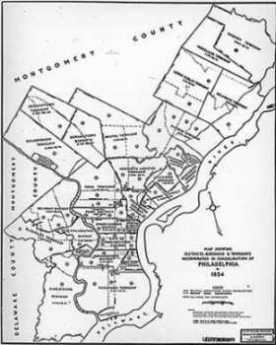
|
| Consolidation Map 1854 |
Philadelphia is still referred to as a city of neighborhoods. Prior to 1854, most of those neighborhoods were towns, boroughs, and townships, until the Act of City-County Consolidation merged them all into a countywide city. It was a time of tumultuous growth, with the city population growing from 120,000 to over 500,000 between the 1850 and 1860 census. There can be little doubt that disorderly growth was disruptive for both local loyalties and the ability of the small jurisdictions to cope with their problems, making consolidation politically much more achievable. A century later, there were still two hundred farms left in the county which was otherwise completely urbanized and industrialized. For seventy-five years, Philadelphia had the only major urban Republican political machine. By 1900 (and by using some carefully chosen definitions) it was possible to claim that Philadelphia was the richest city in the world, although this dizzy growth came to an abrupt end with the 1929 stock market crash, and the population of Philadelphia now shrinks every year. In answering the question of whether consolidation with the suburbs was a good thing or a bad thing, it was clearly a good thing. But since Philadelphia is suffering from decline, it becomes legitimate to ask whether its political boundaries might now be too large.
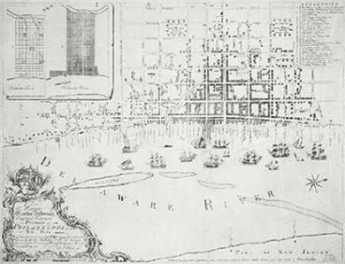
|
| Philadelphia Map 1762 |
The possible legitimacy of this suggestion is easily demonstrated by a train trip from New York to Washington. The borders of the city on both the north and the south are quickly noticed out the train window, as the place where prosperity ends and slums abruptly begin. In 1854 it was just the other way around, just as is still the case in many European cities like Paris and Madrid. But as the train gets closer to the station in the center of the city, it can also be noticed that the slums of the decaying city do not spread out from a rotten core. Center City reappears as a shining city on a hill, surrounded by a wide band of decay. The dynamic thrusting city once grew out to its political border, and then when population shrank, left a wide ring of abandonment. It had outgrown its blood supply. Prohibitively high gasoline taxes in Europe inhibit the American phenomenon of commuter suburbs. The economic advantage of cheap land overcomes the cost of building high-rise apartments upward, but there is some level of gasoline taxation which overcomes that advantage. Without meaning to impute duplicitous motives to anyone, it really is another legitimate question whether some current "green" environmental concerns might have some urban-suburban real estate competition mixed with concern about global warming. Let's skip hurriedly past that inflammatory observation, however, because the thought before us is not whether to manipulate gas taxes, but whether it might be useful to help post-industrial cities by contracting their political borders.
Before reaching that conclusion, however, it seems worthwhile to clarify the post-industrial concept. America certainly does have a rust belt of dying cities once centered on "heavy" industry which has now largely migrated abroad to underdeveloped nations. But while it is true that our national balance of trade shows weakness trying to export as much as we import, it is not true at all that we manufacture less than we once did. Rather, manufacturing productivity has increased so substantially that we actually manufacture more goods, but we do it with less manpower and less pollution, too. The productivity revolution is even more advanced in agriculture, which once was the main activity of everyone, but now employs less than 2% of the working population. This is not a quibble or a digression; it is mentioned in order to forestall any idea that cities would resume outward physical growth if only we could manipulate tariffs or monetary exchange rates or elect more protectionist politicians to Congress. Projecting demographics and economics into the far future, the physical diameters of most American cities are unlikely to widen, more likely to shrink. If other cities repeat the Philadelphia pattern, the vacant land for easy exploitation lies in the ruined band of property within the present political boundaries of cities, or if you please, between the prosperous urban center and the prosperous suburban ring.
Many American cities with populations of about 500,000 do need more room to grow, so let them do it just as Philadelphia did a century ago, by annexing suburbs. But there are other cities which have lost at least 500,000 population and thus have available low-cost low-tax land which would mostly enhance the neighborhood if existing structures were leveled to the ground. Curiously, both the shrunken urban core and the bumptious thriving suburbs could compete better for redeveloping this urban desert if the obstacles, mostly political and emotional, of the political boundary, could be more easily modified. But that's also just a political problem, and not necessarily an unsolvable one.
Philadelphia City Controller
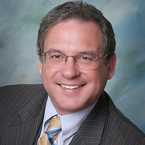
|
| Alan Butkovitz |
The Right Angle club was pleased to hear the City Controller, Alan Butkovitz, give us an insider's view of the municipal finances, but was a little startled to hear how badly the national banking crisis has affected our city. While of course the city does a lot of things, its present finances can be summarized as mainly consisting of two things: the pension system and the management of police/fire/corrections.
Mayors of this city for several decades have been following the national pattern of government to transfer its deficits to the pension funds of the employees. That has the effect of shifting the cost of present operations into the far future and avoiding present confrontations by promising even more generous pension benefits in the future. Over time, the future gets closer and closer; to a large degree, it is right now. Pension funds are largely independent organizations, supposedly receiving current contributions to be invested for future distribution. That requires an assumption about how much investment growth will be achieved in the meantime, now set by the Philadelphia Board of Pensions at 9%. That's not impossible to achieve in some medium-term intervals. But it's optimistic, even inconceivable, for long-haul investing; over periods of thirty or more years, most experts say that 4% is about all anyone gets. More to the point, 9% is particularly unachievable right now, in the present crash of national financial markets. That's bad enough, but repeated shortfalls in contributions to the fund have left it funded at 53% of the calculated requirement to pay the pensions of the future, even using the unrealistic 9% return assumption. A few years ago, Mayor Rendell worried about the underfunding and brought it up to 70% with a billion-dollar bond issue. Unfortunately, the crash in the markets has brought it right back down to 53% again. So, it's fair to say the pension fund is a couple of billion dollars short, even if you accept a 9% income accumulation -- which you probably can't, but at least it brings the pension fund to 70% funding in forty years. Call it four billion dollars short, just to be conservative, since it is presently admitted to being two billion. That isn't Mayor Nutter's fault, but it's sure his problem; and if it gets worse, it will be seen as his fault.
The other expense item of note includes 42% of the budget in the police, fire and prisons systems (education is handled separately through the school board). If you fired all those people, or they quit, we wouldn't have a city, we would have a jungle. But the Controller describes all three as terribly mismanaged, with the local police stations in a deplorable state of disrepair and degradation, bathrooms you wouldn't think of using, and so on. The fire department has only a minor number of fires to fight, perhaps four or five hundred a year, but it includes the emergency rescue services which respond to a couple hundred thousand calls a year. The rescue people report to the firemen, and there is social friction between the two, working to the disadvantage of rescue. It costs about $500 to respond to a call, and it isn't entirely satisfactory to send a fire truck to help someone with a heart attack. The Controller had a number of horror stories about administrative mismanagement in this area. As far as prisons go, everybody knows prisons are bad places, and ours are no exception. Confrontation with the unions is definitely in the future for the Mayor, and the city is going to be in pretty bad shape if he doesn't win some arguments.
That's the expense side of the municipal budget; the revenue side is equally gloomy. The offhand comment was that real estate taxes could double without bringing the pension system under control for twenty years. If our taxes are significantly higher than neighboring cities, or even just the same as in cities with superior uniformed services, it will be hard to attract and hold business taxpayers, causing municipal finance to spiral downward. Along the course of this patter-song, it isn't exactly reassuring to learn that it now takes the City 21 days to process a check and that absenteeism in some departments runs to 20%. We've heard a lot of denunciation of Mayors Giuliani and Bloomberg in New York, but their absenteeism runs 3% because investigators are sent to the house of an absentee, who is subject to court martial if he isn't home.
Somewhere in this nightmare lurks the hidden migration of the unionized workers. Starting with Mayor Rizzo or even earlier, the uniformed services were the main political support of the Democrat political machine. Quietly, they have moved out to the suburbs where the schools are better and the taxes are lower, and it is now said that 70% of union workers live (and vote) outside the city limits. The unions talk tough, bluffing through the uncertainty when their members can no longer provide the votes to be so fearsome. To some degree, their weakening political power is augmented by using their pension funds to provide construction loans for new commercial real estate. Some of that political clout is used up by the need to get zoning variances and tax abatements for the projects. A lot of these power shifts are hard to assess from the outside, but a trend is clear.
The controller didn't mention it, but the city is not only a pension investor in bonds but also an issue. Interest rates are about as low as they can get while the Federal funds rate is nearly zero, so there is only one direction they can go in the future -- sooner or later they will go up. By the iron law of bond financing, the value of the underlying principle will then go down. That could provide an opportunity to buy them back at lower prices, or it could break the city's financial back financing higher interest payments. However, for the pension fund side of things, exactly the opposite is true. Maybe Hizzoner can tap-dance around these dangers and opportunities, but most mayors would have trouble pronouncing the words.
It's part of the job description for the controller to be a pessimist. But the most you can make of this mournful dirge is to hope he is completely wrong.
Windmill Electricity

|
| Windmills |
The Right Angle Club was recently edified at lunch about wind-power generated electricity, by Craig Poff of Iberdrola Renewables, the largest producer of renewable-source electricity in the world. Iberdrola is a Spanish firm, headquartered in Bilboa where they have Basques, near where the Spanish Armada once started its ill-fated journey to battle Sir Francis Drake. Furthermore, it's near where there are caves with wall paintings several thousand years old. Craig is pure American, however, with a background in real estate sales. That isn't as remote a connection as it may sound, because it takes several years and a lot of salesmanships to assemble the leases necessary to create a windmill farm.
We've all seen photographs of these silvery towers, with what looks like aluminum propellers glinting in the sun. They are actually made out of fiberglass in much the same way boats are made, and quite often both are made in the Trenton region. So to speak, two hollow clamshells are held together with masking tape to form a propeller blade. Eventually, it revolves slowly, slowly in the wind, starting around 15 miles per hour, and getting turned off when the wind gets so fast it's dangerous. The blades modify their pitch at different speeds, and the entire contraption rotates to meet the wind. Sometimes one windmill will "steal" the wind from its neighbor, so the middle ones get turned down or turned off. There are local "met masts" to measure the wind and its direction and respond with appropriate directions via computers. There are also regional computer centers, and finally, electric power distribution is controlled by computers in Bilbao. Electricity can't be stored very well, so sometimes a perfectly good wind must be ignored when electricity isn't needed. Scientists are working on big batteries, and also on storing energy by pumping water uphill into storage reservoirs or compressing air into caves. Storing wasted electricity is a major issue, and high hopes are held out for innovation in batteries.
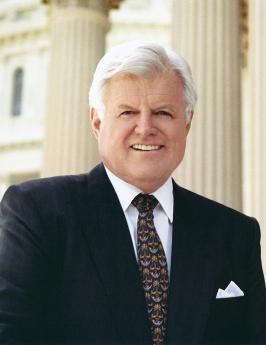
|
| Senator Ted Kennedy |
A typical tower is about 123 meters high, with a wingspan of about 300 feet; the towers are separated by roughly 1500 feet, but by much more when they are downwind. It's easy to see how negotiations with local farmers can be difficult, requiring months of public relations in a new community. Sometimes they encounter someone like Senator Ted Kennedy, who just plain dislikes how windmills look. Negotiations have to be conducted to obtain access roads to the wind farm, and access to the power transmission grid. Negotiations have to be conducted both before and after construction to satisfy game commissions who worry about the birds and the bats. As it works out, a farmer gets about $7000 a year to lease out his land, but windier areas are more prized, so jealous bargaining abounds. It's probably no wonder only 2% of electric power is presently generated this way, even though Pennsylvania law requires the power companies to reach 18% by 2020. Requires? What's the reasoning behind that? At present, the windmill nearest to Philadelphia is in Pottsville.
It's nice this electricity gets generated by a source so clean, which also can't be shut off by the Iranians. But awkwardly it's expensive to make electricity this way, particularly if you include the subsidies it enjoys. Yes, yes, it's true that lots of things are receiving dubious subsidies, and some of them are competitors to wind power. But the unwillingness of wind power advocates to acknowledge the relative costs of their product suggests to any skeptic that relative costs must be extremely high, indeed. Yes, it's clean, but it's expensive and needs a subsidy. Industries that consume large amounts of power have been offered power purchase agreements that constitute a hedge against future cost volatility for many years in the future. That's both a hedge against rising costs and a promise of reliability; some businesses will pay for that. The competitive economics are that the initial cost of wind power is quite high, but future maintenance costs are quite low. More typically, most household consumers feel they have a right to know more precisely what the competitive prices really are, absent loss leaders, subsidies and hype. When we know that for sure, we consumers will decide whether a somewhat cleaner environment is worth the price. The investors in this technology must gamble they can persuade us that it is, and one can be fairly certain competitive energy producers will seek to persuade us that it isn't. What the farmers who lease their land think, also matters. But the farmers will mostly matter in the legislature voting on clean air mandates, where city dwellers tend to lose their influence. You can sort of see how the legislators think: the farmers know how much they have been offered for the land leases, but the city dwellers can only guess at how clean the environment will get, and how much the electric costs will rise.
GIC in Paris
|
||
| GIC logo |
Delegation Agenda
Sunday, May 11th:
6:30pm -7:00pm: Arrival and cocktails
Location: Aux Anysetiers du Roy, 61, rue St. Louis en L'Isle Metro: Sully Morland or Pont Marie
7:00pm: Dinner will be served; Registration and pre-payment was required for this event.
Monday, May 12th:
9:00am - 9:15am: Arrival and registration. A light breakfast will be provided.
Location: Bistro de la Muette, 10, Chaussee de la Muette 75016 Paris Metro: Muette
9:15 am - 10:00 am: Presentation by Michael Kennedy, Head of the General Economic Assessment Division, Department of Economics, OECD, on Outlook by the OECD.
10:15am - 11:30am: Round-table discussion directed by John Silvia, Chief Economist, Wachovia Bank, including Paul Thomas, Chief Economist, Intel, Tom O'Connell, Assistant Director-General of Central Bank of Ireland, Sandra Pianalto, President of Cleveland Federal Reserve Bank, Mario Baldassarri, Senator, The Republic of Italy, and David Kotok, CIO, Cumberland Advisors. Each participant will introduce a topic of concern to the group with GIC delegates acting as discussants. Chatham House Rule will apply.
12:15pm - 1:30pm: Lunch at Bistro de la Muette, sponsored by Cumberland Advisors and Wachovia.
1:30pm-7:00pm Free Time
7:00pm - 7:30pm: Cocktails and Hors d'oeuvres.
Location: Cercle de L'Union Interalliee, No. 33 Rue du Faubourg Saint-Honor' 75008 Paris Metro: Concorde or Madeleine, 5-10 minute walks
7:30pm: Private dinner with Paolo Garonna, Deputy Executive Secretary United Nations
Economic Commission for Europe and sponsored by Cohen and Company. Dress code for the club requires a jacket and tie, no blue jeans or tennis shoes please.
Tuesday, May 13th:
8:45am-1:10pm: GIC & CEPII Conference "Monetary Policy and the Exchange Rate: The Euro and the Dollar"
Location: Maison des Arts et M'tiers, 9 bis Avenue d'I'na, 75116 Paris, Metro: Iena
Full Program will be distributed at the event. Speakers and moderators include:
William Dunkelberg, Chairman, Global Interdependence Center
Agn's B'nassy-Qu'r', Director, CEPII
Lionel Fontagn', CEPII
David Kotok, Chief Investment Officer, Cumberland Advisors
David Woo, Head of Foreign Exchange Strategy, Barclays Capital
Manuel Balmaseda, Chief Economist, CEMEX
Denis Verret, Senior Vice Preside of Operations and Sales, EADS
William Clark, Director, New Jersey Division of Investments
Laurence Boone, Chief French Economist, Barclays Capital
Sandra Pianalto, President, Federal Reserve Bank of Cleveland
Christian Noyer, Governor, Banque de France
1:10 pm ' 2:30 pm: Luncheon for conference attendees at the Maison des Arts et Metiers sponsored by Barclay's Capital
7:00 pm: Dinner hosted by Christian Noyer, Governor of the Banque de France.
Location: Banque de France, Gold Library, 39, rue Croix des Petits Champs ' 75001.
Please enter via 2 rue Radziwill, at the north end of the Bank. Recommended metro stops for the Banque de France are Bourse, Palais Royal-Louvre, Louvre-Rivoli or Pyramides, all a ten-minute walk to the Banque de France. Dress code for the evening requires a jacket and tie. For security purposes, please bring invitation and photo ID and allow an extra ten minutes for security processes.
Wednesday, May 14th:
9:30 am: Arrive at the French National Archives, for security process. Please bring your passport for security purposes.
Location: French National Archives, 1 rue Roberty Esnault Peltierie, corner of 37 Quai d'Orsay, 75 007 Paris Metro: Invalides
10:00 am: Private tour of French National Archives where GIC delegation will have a viewing of French historical treasures such as the Louisiana Purchase signed by Thomas Jefferson, Original Treaty of Alliance signed by Benjamin Franklin, Original Treaty of Versailles as well as other historical documents.
1:00 pm: Luncheon hosted by Mr. Arnaud de Bresson, Managing Director, Paris EUROPLACE.
Location: Place de la Bourse, Palais Brongniart, 75 002 Paris Metro: Bourse (line #3)
Lunch will be followed by the presentation of the Paris financial market place.
4:00 pm ' 5:00 pm: Travel to meeting with Christine Lagarde, Minister of Finance. Please arrive by 4:30 to pass through security.
Location: Ministry of Finance Building,139 Rue de Bercy, Paris 12 Metro: Bercy.
5:00 pm ' 6:00 pm: Private meeting with Christine Lagarde, Finance Minister of France. Please bring a passport for security purposes.
Country Auction Modernized
Only a decade ago, the Quakertown exit of the Pennsylvania Turnpike made possible a quick trip from the city to the country, letting you off in the cornfields between Sumneytown and Lansdale. Today, the rush hour traffic is as bad as anywhere else, even on the four-lane express highway known as Forty Foot Road. A comfortable two-lane highway would be about forty feet wide, so presumably, the name denotes what was once a modern miracle of a two-lane highway, in this case until quite recently. It's all built up for miles, but almost all the commercial buildings are new. Exurban sprawl has positively lurched across the landscape, making prosperous people rich, and poor people prosperous. It won't be long before the housing subdivisions demand traffic signals to protect the school children, speed limits to reduce the collisions by teenagers, and other things destined to bring high-speed travel to a crawl, all day long. When that happens, it won't be called farm country anymore.

|
| Alderfer Auction Company |
On Fairground Road, where occasionally corn is still growing, a number of large new commercial enterprises have located, among them a moving and storage company with ten or so truck loading platforms in the back. Behind that is another large new building, also with a parking lot for fifty or so cars, the auction house. Different categories come up for auction on different days, so used furniture, for example, comes up every few weeks and has to be stored as things accumulate for the big day. With a moment's thought, you can easily see why the auction is affiliated with or owned by a moving and storage company. As you go through the entrance, you are invited to sign up and identify how you plan to pay, just in case you buy something; the product of this registration is a card with a number in big colored letters. That's your number, your payment arrangement, and soon you will find no one cares anything about you except that number. The auction I was interested in was for used books, one of three or four auctions conducted in different rooms.
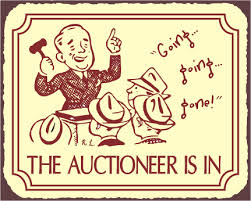
|
| Auctioneer |
Nearly a hundred people had numbers for used books, maybe a similar number for antique furniture and paintings. Obviously, one other purpose of the registration process is to create a mailing list of customers interested in various objects, possibly linked to a program which sends out flyers and announcements. Country auctions have always been a source of local entertainment, so non-buying spectators are able to come and watch if they wish. There seemed to be few if any casual sight-seers; just about everybody is a buyer or a potential buyer. Players, as they say.
Most of the customers probably set their alarm clocks for 5 AM or earlier; the auction is centrally located, but most everybody comes from a considerable distance. At 9 AM, very promptly, the auction began, and from his manner, you could tell the auctioneer was anxious to get started. The object for sale had been on display for a day, but most people arrived around 7 AM to examine the goods, which are frequently sold in lots, meaning a box full of thirty or forty books more or less on the same topic. At the stroke of nine, the auctioneer chanting began, "Do I have ten dollars, yeh, ten, ten, ten, five, five, ten, fifteen, twenty, twenty, sold for fifteen. Your number, sir?" Two assistants took down the customer number, and the lot number, and the price; one of the two recorded the transaction in a computer, the other on a list by hand. One gathers the man without a computer was on the look-out for shills, people trying to bid up to the price without getting stuck for a purchase. The auctioneer repeatedly assured the audience that no one but a real bidder was allowed to bid, you owned it, and no excuses about being confused. When he reached he hundredth sale, he stopped for a drink of water, and proudly noted the first hundred sales took thirty-seven minutes. It required four other assistants to fish out the lots next in line, holding them up for confirmation only, since inspecting them at as the distance was out of the question. After each sale, the assistant dumped the prize in the new owner's lap.

|
| Auction Paddle |
And yet entitled to wonder a little. The ordinary run of books thirty or forty years old will sell for between ten and twenty dollars. Books about golf, just about any old book about golf, "go" for about forty dollars. Children's books are about sixty dollars. And, to my great surprise, boxes or albums of old photographs go for over a hundred dollars. A lady next to me excitedly brought an album of old photos back to her seat and thumbed through them. "Are you a dealer?" Yes. "Who buys this stuff?" I don't know, they come to my store and just buy it. Like the Auctioneer, she had a feeling for what the retail price would be, made a calculation, and knew what she could afford to pay wholesale. What the stuff actually represented, why people wanted it, what was a good one and what was a bad one--these people in the trade had very little idea. But they knew very precisely what a fair price, and gradually lowers it until it sells. Fun Lots of fun. When a familiar insider makes a mistake and pays too much, the others laugh heartily at him. Why this funny system works has long been a mystery, but everyone except a socialist readily acknowledges it does work. At least it works better than any known substitute.
Although the ritual of the country auction has been essentially unchanged for the centuries, it is just another transaction system. In the past fifty years, the world economy has been transformed by computerized efficiencies in transaction systems, with vast prosperity resulting from small saving endlessly repeated. Banking and Wall Street have concentrated most of the standardized transaction, in perfectly astounding volume; lots and lots of people have become immensely rich for producing small efficiencies in high volume. Those of us who have not become immensely rich can easily identify trivial innovations which resulted in wealth, and we easily sense the unfairness of old photos worth more than books of poetry. After all, the country auction is still grossly inefficient; the seller pays the auction company 20% of the price, and the buyer pays another 10%. There's 3% for the credit card company and &% for the sales tax. Forty percent of this transaction is going to the middle man, over and over and over again. The goal is to reduce transaction costs to the level of Wall Street, considerably less than one percent, Which still lots of yachts for middlemen.
As you walk out of the country auction, it doesn't take a mathematical genius to multiply thirty percent times the number of transactions, times a guess at the average sales price. No wonder these auction people are so cheerful, so much in love with their work. But two other parties are cheerful, too. That is, the buyer and the willing seller.
Re-Doing Dilworth Plaza
 |
| Richard Maimon |
Richard Maimon recently visited the Right Angle Club to tell us all about the architectural plans afoot to consolidate the underground transportation network underneath City Hall, change the patterns of foot traffic, open up the views, and draw the visitors to the expanded convention center into the city itself. All of this is to be accomplished by paving over Dilworth Plaza and planting it with grass, along with an extensive fountain installation which can be used for winter ice skating. In the course of creating an entrance hub for Septa, the Broad Street and Market subways, walkways are rearranged and -- it is hoped -- the foot traffic around City Hall will shift around to make it a real city center. It's a very expensive dream because of all the overlapping transportation tunnels hidden under the largest and heaviest stone building in America, leading to a great deal of expensive construction work that doesn't show.
 |
| interior view of concourse north_ |
Dilworth Plaza is currently almost completely deserted, so its conversion will not be much mourned. However, the mixture of contemporary transportation entrances with the neo-classical architectural style of City Hall will probably meet resistance, and there is concern that excessive foot traffic could convert a grassy park into a mud puddle, while a large open-air lake could become a public rest-room for the homeless if the designers aren't careful. To some extent, the public forces to be resisted in the design will be self-policing if the anticipated foot traffic is at the anticipated level, but overwhelmed if the project is too successful, or left to deteriorate if it fails to succeed. And it's all too expensive to do twice; the designers have to get it right the first time.
 |
| Section Pavilions |
So, it all comes down to money. Construction costs are less during a recession, but raising money is easier during a booming economy. High hopes are raised for a Democratic governor to be able to persuade a Democratic president to divert stimulus money our way. High hopes are raised for a former Mayor's ability to divert state funds to our part of the state. In other words, it all depends on Governor Rendell, now that Senator Specter has navigated himself off the Appropriations Chairmanship. In our system of government, public works projects have to be placed somewhere, so the best system is to rotate the goodies in an informal way. This rotation, in turn, depends on a geographical rotation of the top political officers, since they can claim that it is "Philadelphia's turn". So, the grim reality is that only two Philadelphia mayors in history have become governors of the state, with the rather bitter result that Philadelphia has been neglected in the siting of the available public projects for a very long time. Digby Baltzell long preached that it was our own fault, for being too non-aggressive. But most of the rest of us, particularly those who have wrangled with the upstate legislature, blame the situation on narrow-minded opposition from those who have worked the gerrymandering game for a couple of centuries.
SEPTA's Long Term Planning
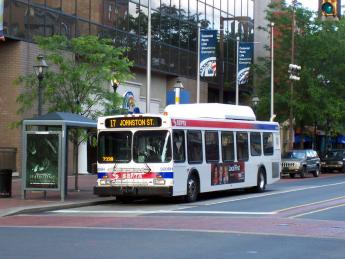
|
| Septa |
Byron S. Comati, the Director of Strategic Planning and Analysis for SEPTA (Southeastern Pennsylvania Transportation Authority), kindly gave the Right Angle Club an inside look at the hopes and plans of SEPTA for the near (five-year) future. Students of large organizations favor a five or six-year planning cycle as both short enough to be realistic, and long enough to expect to see tangible response. If plans continuously readjust to fit the five-year horizon, the concept is that the organization will move forward on these stepping stones, even accounting for setbacks, disappointments, and surprises. Furthermore, a serious level of continuous planning puts an organization in a position to react when funding opportunities arise, such as the sudden demand of the Obama Administration that economic stimulus proposals be "shovel ready."

|
| The Silverline V |
So, SEPTA is currently promoting five major expansions, based on the emerging success of an earlier plan, the Silverliner V. Silverline is a set of 120 shiny new cars, built in Korea on the model of electrical multiple units, which are expected in Spring 2011 to replace 73 cars or units which were built in 1963. Obviously, 120 are more expensive than 73, but they are more flexible as well. And less wasteful; most commuters are familiar with the model of three seats abreast which unfortunately conflict with the social preferences of the public, tending to make the car seem crowded even though it is a third empty. When a misjudgment like this is made, it takes fifty years to replace it with something better. For example, there's currently a movement toward "Green construction", which is acknowledged to be "a little bit more expensive". The actual costs and savings of green construction have yet to become firmly agreed on, so there's an advantage to being conservative about what's new and trendy in things that take fifty years to wear out.

|
| Septa Regional Map |
Four of SEPTA's five major proposed projects are in the Pennsylvania suburbs. New Jersey has its own transportation authority, and Philadelphia is thus left to struggle with the much higher costs of urban reconstruction assigned to its declining industrial population. And left unmentioned is the six hundred pound gorilla of the transportation costs of new casinos. A great many people are violently opposed to legalized gambling, and even more upset by the idea of crime emerging in the neighborhoods of gambling enterprises. Even the politicians who enacted this legislation are uncomfortable to see the rather large expenditures which will eat into the net revenue from this development. Nevertheless, if you are running a transportation system, you have an obligation to plan for every large shift in transportation patterns, no matter what you might think of the wisdom of the venture. The alternative is to face an inevitable storm of criticism if casinos come about, but without any preparation having been made for the transportation consequences. At present, the public transportation plan for the casinos is to organize a light rail line along the Delaware waterfront, connecting to the rest of the city through a spur line west up Market Street; it may go to 30th Street Station, or it may stop at City Hall. That sounds a lot like the present Market-Frankford line, so expect some resistance when the cost estimates are revealed. Because all merchants want to have the station stops near them, and almost no residents want a lot of casino foot-traffic near their homes and schools, expect an outcry from those directions, as well. It would be nice to integrate this activity with something which would revive the river wards, but it seems a long stretch to connect with Wilmington on the south, or Trenton on the north.
The planned expansions in the suburban Pennsylvania counties will probably encounter less controversy, although it is the sorry fate of all transportation officials to endure some hostility and criticism for any changes whatever. Generally speaking, the four extensions follow a similar pattern of building along old or abandoned rail lines, following rather than leading the population migrations of the past. When you are organizing mass transit, there is a need to foresee with some certainty that there will be a net increase in commuters in the region under consideration. The one and two passenger automobile is a much more flexible instrument for adjusting to the growth of new development, schools, retail, and industry. Once the region has become established, there is room for an argument that transportation in larger bulk is cheaper, cleaner or whatever.
The Norristown extension follows the existing but underused rail connections to Reading. Route US 422 opened up the region formerly serving the anthracite industry, but now the clamor is rising that US 422 is impossibly crowded and needs to be supplemented with mass transit.
The Quakertown extension follows the rail route abandoned in 1980 to Bethlehem and Allentown, although the extension is only planned as far as Shelly, PA.
The Norristown high-speed extension responds to the almost total lack of public transportation to the King of Prussia shopping center, and will possibly replace the light rail connection to downtown Philadelphia.
And the Paoli extension follows the mainline Amtrak rails as far as Coatesville.
All of these expansions can expect to be greeted with huzzahs by developers, land speculators, and newsmedia, but resistance will inevitably be as fierce as it always is. Local business always fears an expansion of its competitors; the feeling is stronger in the suburbs than the city, but local business always resists and local politicians always follow their lead. To some extent, the suburbs have a point, since radial extensions are usually much cheaper to build than lateral or circumferential transportation media; bus routes are the favored pioneers in connecting one suburb with another. Therefore, the tendency in these present plans remains typical by threatening the suburbs with a need to travel toward the center hub, then take a reverse branch back in the general direction of where they started, in order to go a short distance to a shopping center or school system. The two main river systems around Philadelphia interfere with the construction of big "X" routes from the far distance in one direction to the far distance in the opposite direction. Euclidian geometry makes the circumferential route elongate as the square of the radius. And jealousies between the politicians in three states create rally foci for the special local interests which feel injured. Since it seems to be an established fact that the proportional contribution to mass transportation by the surrounding suburbs of Philadelphia is traditionally (and considerably) lower than the national average, a political reconciliation might do more for the finances of SEPTA than any federal stimulus package could do. For such reconciliation, a few lateral connections in the net might pacify the suburbs enough to justify the extra cost. Unfortunately, the main source of unjustified cost in regional mass transit is the high wage and benefit levels of the employees, a situation inherited from the old days when commuter rail was part of the stockholder-owned regional railroads. Just as featherbedding was the main cause of the destruction of the mainline railroads, health and pension benefits threaten the life of mass transit. In the old days, local governments acted as a megaphone for union demands. So the railroads just gave the commuter system to the local governments, and let them wrestle with the unions themselves. Since the survival of the urban region depends on conquering this financial drain, the problem must be gradually worn down. But it has been remarkable how long the region has been willing to flirt with bankruptcy rather than bite this bullet.
If anything, this friction threatens to get worse. In 2009, for the first time, a majority of union members in America -- work for the government, the one industry which thinks it cannot be destroyed by losing money. True, SEPTA is not exactly a government function, but it has enough in common with a government department to arouse suburban voters, who regularly refer to it as an arm of the urban political machine. SEPTA isn't too big to fail, but there exists little doubt that government at some level would probably try to bail it out if it did.
Go to Delaware, Elephants?
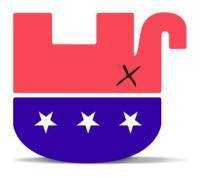
|
| Dead Elephant |
No one is supposed to know where elephants go to die, but if they are smart as people say they are, my suggestion is to search for dead elephants in the state of Delaware. Most taxes, and estate taxes, in particular, are considerably lower, there. At least this was the message Christopher J. Topolewski, Esq. conveyed to the Right Angle Club recently. His firm, West Capital Management, has prepared a table comparing the taxes in the three states that come together at the southeast corner of Pennsylvania, which for residents of the Philadelphia area are within easy commuting distance of each other. Although Delaware has a marriage penalty (one couple is taxed more than the sum of two singles), it has no estate tax at all, no sales tax, and a property tax rate only half that of Pennsylvania, only a quarter of that in New Jersey. For residents of New Jersey, there is almost no tax which is not lower in Delaware, because but ex-Pennsylvanians would then have to be careful to die or cohabit since ordinary income tax and capital gains taxes are higher in Delaware than Pennsylvania. If you must die (and who doesn't?), go die in Delaware.
This was a situation specifically contemplated as a way to discipline greedy state governments, by James Madison when he was formulating the U. S. Constitution. And there is evidence it is working. By happenstance, I once encountered an official of New Jersey taxation, who told me that 43% of New Jersey taxes are paid by 1% of the population. And that 1% was moving out of the state as fast as it could. If it does, the other 99% of New Jersey residents will find their taxes rising by 43%. West Capital reports that taxation as a percent of income is 1.23% in Delaware, 3.46% in Pennsylvania, and 5.82% in New Jersey, suggesting that a selective flight of the 1% would raise the state taxes of everyone else by 43%, and thus make state taxation as a percent of lowered average income rise to roughly 20%. Relating total income to total tax revenues would be an even better way to detect hidden indirect taxes, such as overtaxing utilities in the knowledge it will be passed on to the consumer. I recently discovered that a few years ago, the Legislature got tired of hearing complaints about local taxes, so they transferred half of the local taxes to the state tax. That's pretty much like taking it from one pocket and putting it into another because now all the hubbub is about state taxes. Armed with even partial information, it becomes easier to understand why New Jersey would evict a governor who had been Co-chairman of Goldman Sachs, during a financial crisis. If a financial whiz can't change this, maybe it requires a meat ax.
This is a time of growing restlessness about public spending, and Tea Party revolts are likely to accelerate during the remaining nine months before the next election. The conjecture is growing about a coming deadlock between a Republican Congress and a Democratic President, lasting at least two more years. What might emerge from a strong third party congressional delegation is too arcane to discuss. But at least the Republicans who leave can console themselves they are selectively raising the taxes of Democrats.
It seems almost inconceivable that professional politicians would demonstrate such a forest of tin ears as to let this happen, but the rest of Mr. Topolewski's talk just heated up the fire. His long-scheduled talk was designed to give guidance about the new estate tax laws, but he found himself confounding his audience with the news that there are no new estate tax laws; in fact, there will be no estate tax laws at all after this year unless they emerge from the congressional gridlock we already have. Which apparently will be followed by a gridlock we can scarcely imagine. Imagine asking your lawyer to write a will which straddles the contingencies that there will be no law, that there might be a continuation of the present one, or there might be some new law of quite uncertain wording. One of the suggestions offered is to allow your executor the discretion to accept or disclaim certain hypothetical provisions.
And that brings up an old story. William Penn was the largest private landowner in the history of America, possibly the whole world. He had a trusted agent, who gave him an enormous pile of papers to sign. A busy rich man like Penn is regularly confronted with a discouragingly large number of routine legal documents to sign. So, Penn signed them all, not noticing that one of the various papers in the pile gave the entire state of Pennsylvania -- to his agent. The outcome of the ensuing uproar was that Penn spent six years in debtors prison.
Urban Transportation
Stuart Taylor, who spent twenty years working for the Pennsylvania Railroad in the company of our member Bill Brady, recently gave the Right Angle Club his observations about urban transportation, which grew out of his second career as a consultant. As he describes the evolution from the horse-drawn omnibus carriage to the horse-drawn trolleycar, to the steam-driven trolley, to the electric trolley, to the underground subway, certain parallel historic movements occurred to at least one member of this audience.
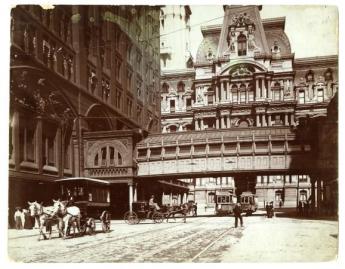
|
| Horse-Drawn Trolley Car |
In the first place, mass transportation is only of value when cities grow to a large enough size to justify the expense. And the growth of cities in the 19th Century was propelled by the Industrial Revolution attracting mass immigration into urban centers. Whether the Industrial Revolution is over or not, is a topic which could be debated, but it was the gasoline engine which made buses and autos attractive, and the decaying slums made cities sufficiently unattractive to cause the flight to the suburbs in the 1920s and 1930s, heavily resumed after World War II in the 1950s. During the heyday of city growth, the evolution of mass transit seemed to be driven by technology, and that in turn attracted private ownership. When the gasoline engine and/or the decline of the Industrial Revolution made the Flight to the Suburbs possible, it made urban transportation unprofitable and hence unattractive to private business owners. Somewhere just before or after the 1929 Crash, the changing situation made it more attractive to live and/or work in the suburbs. A sign of this change in dynamics was the total disappearance of private ownership of public transportation and its supporting infrastructure, and replacement by public ownership and public tax subsidy. As local politics began to reflect this change, Urban politics somehow became dominated by Democrats, and Suburban politics became dominated by Republicans; so the enthusiasm for mass transit has waxed and waned as the political domination of federal subsidies has shifted between the parties. That's probably only an outward sign, however. The real issue is that urban transportation now has to be subsidized since its base has shrunk to the point where people like Widener and Elkins invest in other things. And do so from their homes in exurbia, where the neighbors could care less about subways, let alone pay taxes to subsidize them. And until the city gets control of its crime, public schools, and taxes, it's hard to see what will attract them back in town.
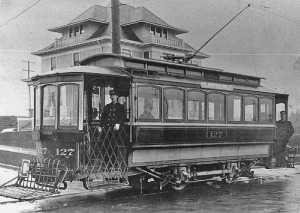
|
| Electric Trolley |
That's perhaps an overly censorious view, coming from a resident of the suburbs. A more economic view of things would be that the construction of underground subways now costs about a billion dollars a mile. Very few cities and no private entrepreneurs can justify costs of that magnitude since the potential ridership cannot afford the costs per ride which are implicit in that capital expenditure. Until the cities can manage to entice the suburbanites back into town, those people will solve their air pollution problems by avoiding the cities. Living to the windward seems much more plausible to them. China is just beginning this process, but they have the advantage of building the subways first, then the surrounding skyscrapers, and thus greatly reducing the costs of avoiding underground sewer systems, etc. If you could call it that, the Europeans had the advantage of massive war destruction, along with much more expensive farmland to inhibit suburbanization. None of this is an argument that we shouldn't build subways, or clean up the atmosphere. It's just a warning of the daunting construction costs and staunch political opposition to mass transit. Not to mention featherbedding, over-hiring, massive hidden benefits costs, and other features which seem to be inherent in union activity, at least of the historical variety.
A member of the Right Angle audience asked the speaker what he thought of the proposed Market Street light rail line. Insane, was the answer. No visible ridership. And that seemed to summarize the present debate.
Except that it really shouldn't frame the argument for Philadelphia. Philadelphia doesn't need a mass transit network, it already has a mass transit network. Much of it is growing obsolete, but the land costs and local opposition to change are greatly diminished when the network is already there. If any city can do it, Philadelphia can. The technology will surely evolve enough for our purposes if the money is there, and the money will be there if people return to using the city. What Philadelphia needs is a return of business headquarters and other sources of employment, bringing the ridership and the public demand along with it. And for that, what is essentially needed is for government to address our problems of uncontrolled crime, inferior public schools and maladministered taxes.
Paying For College - II

|
| The Cosmos Club Washington D.C. |
To begin with an anecdote, I belong to a Philadelphia club which reciprocates with the Cosmos Club in Washington DC. It's a handy place to stay overnight on the rather infrequent occasion of visits to Washington on business. It happened I had an early breakfast at the Cosmos and was the only guest in the dining room. A pleasant well-dressed man came in and asked if I minded if we sat together. "I'm Bob Goheen. I work at Princeton." Since he was widely known as the President of Princeton University, he was indeed welcome. He could hardly be expected to know my daughter was then a sophomore at his college, so he was, of course, unprepared for what I had to say.

|
| Empty Pockets |
After introductory pleasantries, I told him of my arithmetic problem. My daughter was taking five courses, so the family was paying ten thousand dollars a year, per course. Since most of her courses had over two hundred students in the lecture hall, the University was being paid two million dollars to teach each course. Was it possible I had got the arithmetic wrong? Mr. Goheen neither flushed nor displayed hostility, but his manner did change. Well, of course, the tuition pays for far more than direct teaching costs. It's expensive to maintain a first-class library, the University has a responsibility to help the town of Princeton with its problems, the University is proud of its very extensive scholarship program for needy students, there is research to be sponsored. Yes, said I, you have fallen into the trap I prepared for you. My complaint is that if I had donated money for those worthy causes, it would all be tax-deductible; but by having it extracted from me under the name of tuition, I was denied the tax advantage. As expected, he quickly changed the subject. And to his evident relief, I let him do so without resistance.
Since that time, I have had the opportunity to play the same game with several college presidents; not all of them have been suave about it. The only one who took me by complete surprise was the President of Lehigh University, who not only told me he agreed but added that he had made himself unpopular with his peers by promoting exactly similar ideas. There is a very serious problem, here. Somehow, the higher education industry has got to engage in some statesmanship because it is only a matter of very short time before someone proposes a government solution.

|
| National Institutes of Health |
It is possible to treat this issue as a problem of how to pay for universal college education, which would put it in a category now occupied by health care, and probably reach a political impasse for similar reasons. Or it could be treated as a problem of teasing apart the instructional costs from the research and scholarly costs. The problem to be solved, viewed from this latter direction, assumes that excellent teaching could occur, isolated from the scholarly activities, in the manner now accepted for secondary and elementary teaching. Conversely, research institutes with no teaching responsibilities are widely accepted in Europe, for instance, while in America the National Institutes of Health are their most prominent example of its workability. It can be argued that a scholar engaged in research makes a better teacher; it can also be argued that talent for teaching is not necessarily found in those with a talent for research. While it is true that some researchers are productive even in old age, for the most part, research is like poetry and sports, a young person's game. A creative scientist can usually look forward to acting as an administrator after reaching a certain age; why not instead look forward to a career in teaching? There appears to be no serious problem with this suggestion, except the nontrivial issue of relative prestige linked to ascending income. In summary, the question is whether we can afford to put another Harvard in every town of a specified size, or whether we will be forced to transform most existing colleges into enlarged high schools, as we build more of them. Obviously, that's a cheaper method, the question is whether it is a good enough product. Whatever the model to be mass produced, the overall cost would be reduced by stripping out populations who do not need so much education, and getting Google or IBM, or someone similar, to apply massive amounts of information technology to reducing the cost. In achieving universal health care, by contrast, we can reasonably foresee research reducing most of the delivery costs we now contend with, even eliminating some of the major diseases. In education for a service economy, the potentially increasing educational need is unfortunately endless.
Therefore, no matter what pattern we adopt, it must be organized to be in competitive tension with the manpower needs of the economy, rather than unmeasurable goals like becoming well rounded. If the reason we need a vastly more educated population is to supply better-educated graduates to run the economy, some kind of tension must exist between the two, or the educational establishment will ruin us with purposeless expansion, just as some elements of the healthcare industry might wish to do with their services, and almost all trial lawyers unashamedly wish for in their area of expertise.
In this area of economic design, lies the answer which President Goheen should have made to me in the Cosmos Club. By asking for a massive tax deduction, I was yielding to the idea that education was always a responsibility of government, always paid for by rejiggering the tax code. In that direction lies disaster, since control of the tax code lies in the realm of politics and leads to populist solutions. We must not unbalance power relationships so that economic leaders, asking for a better-educated workforce, are not eventually confronted with crippling taxation for the betterment of bloated academia. A typical college has as many employees as students. We cannot get caught up in an unrestrained process leading to half of the population teaching the other half, except for those who have retired and receive a pension from both activities. Rather, this expensive quest for quality must be seen as the other half of the immigrant's dream, which is no longer that of average performance in an industrial economy, but rather that of excellence in a service economy.
Marcellus Shale Gas: Good Thing or Bad?

|
| Marcellus Shale |
Soon after discovering widespread hard and soft coal, Pennsylvania found in Bradford County it also had oil. Local oil was particularly "sweet", with a low sulfur content. Long after much cheaper oil (cheaper to extract, that is) was found in Texas and Arabia, Pennsylvania oil was prized for the special purpose of lubricating engines, which commanded a higher price. This discovery of oil in the western part of the state also provided a vital competitive advantage for local railroads. Other east-west railroads like the New York Central and the Baltimore and Ohio lacked a dependable return cargo like this, so the Pennsylvania Railroad lowered prices and became the main line to the west for a century. Refineries were built in Philadelphia, and continue to dominate Atlantic coast gasoline production, even though the source of crude oil is mostly from Africa. When oil and coal declined in use, Pennsylvania's industrial mightiness declined, too. Philadelphia and Pittsburgh lost much of their competitive advantage, while the center of the state just about went to sleep. When even Texas oil later ran low, America's industry turned to computer-improved productivity to keep its prices competitive, helping California at the expense of Pennsylvania. The bleakness for Pennsylvania may not last, however. Suddenly, we discover we have another enormous source of cheap energy, shale gas.
It's rather deep, however, even deeper than our supply of fresh water. The next layer below surface minerals is porous rock filled with fresh water, the so-called aquifer. Gas bearing shale is layered just under the aquifer. We'll return to the aquifer later.
There is and will be abundant oil in the world, well into the future; but cheap oil has been selectively depleted. When military and economically weak nations like the Persian Gulf had cheap oil, only transportation costs were irksome. But now Russia is emerging as an oil-rich state, previously impoverished states like Iran are asserting themselves, the existence of an international oil cartel becomes more threatening because it reinforces oil price with military threats. Raw material discoveries -- gold rushes -- are always destabilizing because they are tempting to the dictator mindset. That's known in the political literature as the source of the "Dutch Disease", not because Netherlanders are aggressive, but because North Sea oil discoveries destabilized the politics of even that little peaceful nation. America has now made a universal decision to establish energy independence. It once was credible to make predictions that in a decade or two, we would run out of competitively priced energy. To be both rich and weak invites aggression and we knew it.

|
| Gas Drilling |
There's little question America is profligate with its energy, so the need for energy conservation is undisputed. Actually, we are already five times more efficient with energy use than China is; furthermore, we have improved energy efficiency by 20% while China has defiantly worsened. We'll do better, but unfortunately, our immense investments in inefficient home heating and transportation are too costly to discard abruptly in both cases. There is also little question that American research and development of alternative energy sources has been neglected, while China is subsidizing R & D appreciably. In our frenzy, converting food into gasoline by subsidy is a bad joke, electric cars are subsidized and widely described as "Welfare buggies", wind power is twice as costly as carbon-sourced energy and needs better battery development to be able to store it, atomic energy has been encouraged by the French government, but totally held back by ours, in response to public anxieties. The long and the short of it is this: we face a fifteen-year period of doubtful energy sources, a vulnerability our international competitors and enemies might easily use against us.
And then along came shale gas, like a gleaming savior on a white horse. For seventy-five years, the world has known unlimited amounts of petrol carbons are locked into vast stores of shale. Unfortunately, it is buried deep, and located where it is expensive to transport to market. The techniques for extracting such carbons were unacceptably expensive in a world that shrugged off abundant oil. Politics and geology turned against us; we now need fifteen years of catch-up to make alternative energy sources more affordable. Cheap oil ran out before non-carbon sources became practical. But miraculously shale gas is now upon us, right here in Pennsylvania. It takes a long time to map out the existence of shale from Canada to Texas, when it is 8000 feet deep; it was first recognized in 1839 from a cliff outcrop around the little town of Marcellus, New York and vigorously explored in the disappointed hope it would lead to discoveries of bituminous coal, iron ore or other minerals. Land speculators have been roaming Pennsylvania for two centuries. Now, they are offering $5000 an acre plus royalties, just for the right to drill. In 2010, probably 5000 leases will be issued. Needless to say, the discovery is popular with local farmers, and "gas fever" has enormous political momentum. With techniques discovered around Fort Worth, Texas, about 10% of the existing gas can be extracted easily, serving America's energy needs for much of the 15 years required to make renewable, non-fossil, energy cheap and practical. This long history paradoxically accounts for the apparent suddenness of the current popularity; it's not a new mineral discovery, it is the development of practical extraction methodology at a critical political and marketing moment.

|
| Tree Hugger |
And equally needless to say, the environmental movement is being called to its barricades. Whatever is their objection to drilling for gas, 8000 feet below the surface of a wilderness? In the first place, just cutting roads through the forests is destructive to migrating and local bird populations. In a well-known process of "fragmentation", the cutting of roads allows an invasion of raccoons and similar bird predators. Forest fragmentation simply cannot be avoided if drilling rigs are to enter and leave the forests; some vulnerable bird species are bound to go extinct. This particular region is particularly prone to emissions of radon, which is a radioactive gas traveling along the stone layer and occasionally entering the basement of houses; will drilling through to the shale layer make radon seepage better or worse? Furthermore, since this sedimentary shale layer lies underneath the aquifer, drilling must go through the freshwater-bearing caverns before it gets to the shale; expensive sealing methods may be needed to keep the contaminants below from seeping up through and around the drill holes. The practice of fracturing the shale by high-pressure mixtures raises issues with water, sand, and chemicals. Water consumption is millions of gallons per year per well, seemingly enough to drain the rivers and creeks. Some operators will be tempted to use the aquifer as a surreptitious source of water, leading to consequences hard to anticipate. The sand is meant to support the walls of the rock fractures but may clog up other channels unintentionally. And the composition of the chemical drilling components is a trade secret which the extraction companies naturally wish to keep private; it's pretty hard to get public approval of a secret. So to sum it all up, there is a legitimate need to hurry the drilling, and there are legitimate environmental safety issues to be addressed, slowing it all down. New York State has passed laws prohibiting further drilling. Is that an opportunity for Pennsylvania, or a warning we should heed?

|
| Where's My Aquifer? |
This is a time for serious negotiation, and the spending of serious amounts of money on study and monitoring, not for shouting. Politicians sense you can't make omelets without breaking eggs. For them, it's a question whether to choose to be blamed for the inevitable problems of exploring new science, or whether to be blamed for lack of patriotism in a national emergency. The amount of heedless rhetoric is predictably extreme, and the money available to spin it is daunting. If there is anything resembling a middle road in this uproar, let's explore it. In the first place, some sensible discussion between scientists of both sides can be held immediately. Geologists are probably unaware of issues like forest fragmentation, while naturalists are probably unfamiliar with radon hazards and available drilling precautions. Some concerns are exaggerated, some are unsuspected; let's get the experts together quickly and establish most of the knowns and unknowns before popular media runs away with the issue. Let's get the responsible leaders of the gas extraction industry into continuous dialogue with the responsible leaders of environmental protection organizations, so wars they get dragged into are real and not hysterical. Let Congress consider the issue and appropriate funds immediately to study the issues everybody agrees need to be addressed. It seems very likely the huge corporations involved in this issue will rather easily agree among themselves on responsible positions unless they get rattled by overly vocal denunciations. Since this is a gold rush, however, it is also likely that underfunded small operators will start to employ short-cuts and rush heedlessly into dangerous territory; large operators will wish to have laws passed to restrain everybody, small operators will plead fairness. The more transparency this field has, the better. And the most immediately obvious area of resistance to transparency is the natural wish to protect trade secrets in the composition of drilling fluids. In time, the other continents of the world will develop satisfactory drilling fluids; the secret won't last long. The situation cries out for the large operators to negotiate among themselves so those who have an incentive to protect secrecy can tell us how to do it responsibly, while those with a political incentive to expose secrets can be offered time limits related to the how fast the rest of the world catches up. Politicians particularly need to be offered some mechanism for assuring the public about those secret injection ingredients.
Anyway, let's negotiate a way to take chances we have to take, but avoid the costly blunders of studying the issue to death. Hurry up, folks, it's a matter of time before problems have to be faced.
Selling Entire Towns
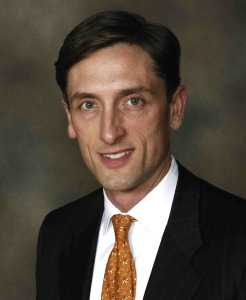
|
| Jason Duckworth |
Recently, Jason Duckworth of Arcadia Land Company entertained the Right Angle Club with a description of his business. Most people who build a house engage an architect and builder, never giving a thought to who might have designed the streets, laid the sewers, strung out the power and telephone lines, arranged the zoning and otherwise designed the town their house is in. But evidently it is a very common practice for a different sort of builder to do that sort of wholesale infrastructure work -- privatizing municipal government, so to speak. A great deal of what such a wholesale builder does involves wrestling with existing local government in one way or another, getting permits and all that. In a sense, the existing power structure is giving away some of its authority and does so very cautiously. Sometimes that involves suing somebody or getting sued by somebody. Perhaps even greater braking-power on unwelcome change is that the wholesale builder is in debt until the last few plots are sold, and realizes his profit on stragglers. Since it often happens that the last few plots are the least desirable ones, this is a risky business. Big risks must be balanced by big profit potential, and one of the risks of this sort of privatization is that too much consideration may be given to the players at the front end, the farmer who sells the land and the builder who must keep costs down, at the expense of the long-range interests of the people who eventually live in the new town. Top-down decision making is much more efficient, but its price is decreased responsiveness to citizen preferences.

|
| For Sale |
As it happens, Arcadia specializes in towns designed to look like those built in the late 19th Century. Close together, a front door near the sidewalks, front porches for summer evenings. To enhance the feeling of being in an older village, Arcadia specifies certain rules for the architecture, to make it seem like Narberth or, well, Haddonfield. Until recently, suburban design emphasized larger plots of land, and few sidewalks, with streets often ending in cul-de-sacs instead of perpendicular cross-streets in the form of squares. The "new urbanism" appealed to those who were seeking greater privacy, revolving around the idea that if you wanted anything you drove your car to get it. Three-car garages were common, groceries came from distant shopping centers. There are still plenty of new towns built like that today, but Arcadia appeals to those who want to be close to their neighbors, want to meet them at the local small stores scattered among the houses. In the 19th Century, this sort of town design was oriented around a factory or market-place; since now there are seldom factories to orient around, the appeal is to two-income families who want to live in an environment of similar-minded contemporaries. The whole community is much more pedestrian-oriented, much less attached to multiple automobiles.
Since Mr. Duckworth mentioned Haddonfield, where I live, I have to comment that the success of living in a town with older houses depends a great deal on the existence of a willing, capable yeomanry. Older houses, constantly at risk of needing emergency maintenance, need available plumbers, roofers, carpenters, and handy-men of all sorts. Because it is hard to tell a good one from a bad one until too late, this yeomanry has to be linked together invisibly in a network of pride in the quality of each other's work and willingness to refer customers within a network that sustains that pride. A tradesman who is a newcomer to the community has to prove himself, first to his customers, and almost more importantly to his fellow tradesmen. If you happen to pick a bad one, good workmen in other trades are apt to seem mysteriously reluctant to deal with you as a customer, because you too are somewhat on trial. Maybe you don't pay your bills, or maybe you are picky and quarrelsome. In this way, the whole community is linked together in a hidden community of trust. Over time, the whole town develops certain recognizable social characteristics that a brand-new town doesn't yet need. If that time arrives without a network of reliable tradesmen, the town soon deteriorates, house prices fall, people move away.
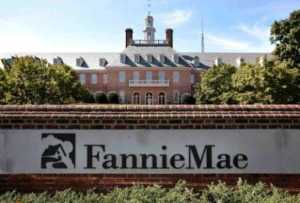
|
| Fannie Mae |
It's curious that the residents of such a town are a breed apart from the merchants in the nearby merchant strip. If the merchants of town life in that same town, there is much less conflict. More commonly, however, the merchants rent their commercial space and commute from distant places. That disenfranchises them from voting on school taxes and local ordinances and creates a merchantile mentality as contrasted with a resident community, dominated by high school students. One group wants lower taxes, the other group wants to get their kids into Harvard. One group wants space for customer parking, the other group is opposed to asphalt lots. And in particular, the residents want to avoid garish storefronts and abandoned strip malls. Since the only group which has an influence on both sides of this friction are the local real estate agents and landlords, their behavior is critical to the image of the town. When real estate interests are not residents of the town it is ominous, and they are well advised to remember that the sellers of houses are the ones who choose a real estate agent for a house turn-over. There's more to this dynamic than just that, but it's a good place to begin your analysis. Suburban real estate interests are constantly tempted to get into local politics, but politicians are the umpires in this game, and it soon becomes bad for their business if real estate agents potentially put their thumb on the scales.

|
| FHA Seal |
All politics is local, but all real estate is not entirely local. The present intrusion of the Federal Government into what is normally a purely local issue has become more pointed in the present real estate recession. Almost all mortgages are packaged and sensitized by "Fannie Mae and Freddy Mac". By overpaying for the mortgages they package, these two federal agencies are subsidizing the banks they buy the mortgages from. Or, that is half of the subsidy. The other half is the Federal Reserve, which presently lends money to banks at essentially zero interest. Acquiring free money from the "Fed", while selling mortgages to Fannie Mae at above-market rates, the federal government supports the banks at both ends. And that's not quite all; there is something called the FHA, Federal Housing Authority, which guarantees mortgages. Essentially an insurance policy, the FHA guarantee is issued for a cost to home buyers who meet standards set by Congress (for which, read Barney Frank and Chris Dodd). Although houses during the boom were selling for 18 times the estimated rental value, they are now selling for 15 times rental. FHA will insure such risks, but the banks won't lend more than the normal proportion, which is 12 times rental. Consequently, almost all mortgages are FHA insured, while the federal administration storms with a fury that the banks "won't lend". And indeed it begins to look as though banks will never issue uninsured mortgages until home prices fall another 25%. If home real estate prices do decline to a normal 12 times rental, a lot of people (i.e. voters) will be unhappy, and not just homeowners who bought at higher prices. The market is fairly screaming that you should sell your house and rent, but so far at least, these federal subsidies seem to be holding prices up. When normal pricing arrives, the recession is just about over, but it certainly won't feel that way if you are a seller.
Selection of Constitutional Rights for the Bill of Rights
When the First Congress convened in 1789, it confronted more than a hundred proposed amendments to the Constitution, largely stirred up by supporters of Thomas Jefferson who feared any strong government would be too similar to the monarchy we had just discarded. Essentially, Congress dumped these noisy dissatisfactions into the lap of James Madison who had largely constructed the Constitution, constituting a committee with Madison as its chairman. The first ten amendments emerged together as a package, enabling trade-offs and compromises; all subsequent amendments have been taken up individually, one by one. Since members of the First Congress and the Constitutional Convention were largely the same people, much of the durability of the Constitution can be traced to them. And therefore, the tendency of the nation to feel its way into a new idea, sometimes retreating, sometimes plunging ahead, has migrated into the Supreme Court. This result was probably accidental, but nevertheless, the power of the Supreme Court was greatly strengthened by default; it alone can tip-toe out of a Constitutional tangle created by momentary impulses.
After winnowing out duplicates and half-baked ideas, Madison's committee condensed the wildly disparate proposals into ten amendments, supposedly limited to ten by alluding to Ten Commandments which were sufficient for Moses. Three main principles emerged. The Constitution should be parsimonious in granting divine, or natural, rights because what Nature's God had granted was hard to tell but what the judiciary could enforce had limits. But thirdly, granting even these few self-evident rights to slaves might tear the Union apart.
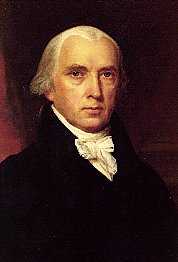
|
| James Madison |
So Madison's committee narrowed the legally enforceable human rights to a handful, selecting only those so self-evident they could withstand the tensions of enforcing them. When contemplating the problem of extending mandated rights to slaves, however, there was no obvious solution at all. That made it easier to limit the Federal Government to enforce a handful of enumerated powers, leaving all unspecified matters to the state legislatures to enforce if they could. The boundary might shift with time, but without saying so, the Bill of Rights kept the Union out of the one main foreseeable problem, of slavery. The unmentioned conflict between universal rights and slavery defaulted to the individual states, or to whomever, but definitely not to the Federal Government.
That tap-dance held together for nearly a century, and then it didn't and we had a Civil War. During all that time, the balance of power was steadily shifting from the confederated states to the centralized federal government, and after the Civil War, it shifted still more. However, the southern confederation may have been defeated, but it was not exactly reconciled, nor were the former slaves exactly equalized. Their current drift toward entitled dependency was particularly unexpected.
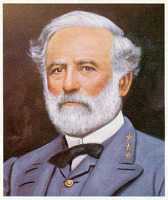
|
| Robert E. Lee |
Many post-war expedients were tested to heal these wounds, some of them useful and some, like forcible Reconstruction, disruptive. Two expedients opened new wounds and distracted the country for a century. The first was the intentional weakening of the quality and effectiveness of state governments, to the point where it can now be asserted that state government is the weakest part of our whole government structure. Those who prized universality and efficiency, or who sought greater international power, regarded state legislatures as a hindrance; just look who got us into a Civil War. Consequently, corruption and ineffectiveness were privately tolerated in state legislatures, because discrediting state governments made them easier to ignore. Repairing the resulting imbalance in our overall system is now growing to be one of our greatest problems. Almost no one remembers this was the price of a ratified Constitution, so increasingly that excuse is futile. In fact, in the thirty-seven more recent states to be admitted to the Union, it is not even accurate.
The second response to a sluggish equalization of racial rights was invented by Madison himself. He felt that the ability to migrate from one state to another would discipline any temptation of a state to misbehave. If your state taxes you unfairly, move. If your state government gets too corrupt, first try to throw the rascals out, but in the last extremity, go somewhere else. This concept has worked magnificently in maintaining national interest rates with appropriate local modifications, and we are about to learn whether it will adequately restrain the half dozen states who have pushed the limits of taxes and borrowing. In the case of former slaves, massive out-migration took a century to happen and then it happened all at once, just after World War II. Wave after wave of slave descendants from the rural South got on buses and came to the heart of Northern cities. Overwhelming the ability of weakened local governments to cope, city institutions disintegrated, particularly the public school and justice systems. The consequence is continuing disarray in Washington DC, Baltimore, Detroit -- and Philadelphia -- together with a host of smaller cities like Reading, Newark, Paterson, Wilkes-Barre, and many others, in all of which the unsustainable wave of immigrants added to local industrial and civic problems which had other causes. So now we have two new problems, weakened state government and disruptive migrations, which in other circumstances tended to mitigate each other, but now increasingly make each other worse. Someone must take hold of the issue that applying Madison's concept of competitive states has created a strong state disincentive to deal with poverty.
It took a century for Madison's scheme to break down into war, and Lyndon Johnson was surely quite right to feel a century was long enough to tolerate the disunity of the Civil War. If he could not make people love one another, at least he could enforce the law. State governments were not doing it, so he whipped the Congress into taking it on as a Federal duty, by passing the Civil Rights Act. Half a century has passed with some progress, but surely not an end to the disunity. State governments have been further weakened, but mass migrations have calmed down. In another half century, the slavery issue and its consequences may fully subside. Meanwhile, the reaction of extending federal power continues, now threatening to extend to the medical profession, the finance industry, the automobile industry, and the Internet. Our Constitution continues to survive more or less intact into its third century, and we grow increasingly wary of tinkering with it as we watch most other nations fail to achieve its essential quality. Which is, it survives. Aside from the Bill of Rights and some technical tweaks, there have only been five amendments of any substance. Meanwhile, new federal statutes and regulations grow by a hundred ponderous volumes a year.
Cleaning Up The Railroad Mess 1974
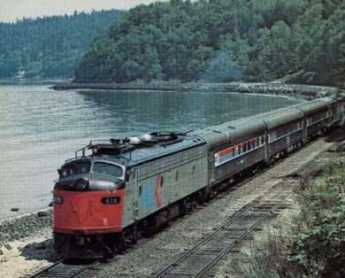
|
| Amtrak, 1971 |
By 1971, it was pretty clear the railroads in the Northeastern quadrant of America were relentlessly losing money and would soon collapse. Bankruptcy provided the only legal method for breaking the burdensome union contracts and huge legal tangles of rationalizing eight Northeastern systems, themselves the product of dozens of earlier mergers. At least in that sense, bankruptcy was a godsend. Getting down to serious reconstruction in 1971, the first step in cleaning things up was to strip off passenger business from the basically profitable freight business. The urban commuter business, hampered by local politics and facing overwhelming automobile competition, was probably the worst burden to profitability, but the decision was made to leave that to regional negotiations. A national long distance passenger system, Amtrak, would service everybody in one nationally subsidized network, with efficiency actually enhanced by national seamlessness. In a few areas like the Northeast corridor and California, long-distance passenger travel was actually still profitable.
Commuter systems, however, had grown up as local creations, differing greatly in local design and importance, and subsidy from the local population. They connected urban regions with suburban ones, and these two regions were often in uncertain economic (hence political) conflict with each other. Such loss-producing operations urgently needed to be stripped off from freight service, but here it seemed expedient to let each region of the country negotiate particularities, with many variations related to local issues. In particular, spreading the source of subsidy was a delicate political problem. If Philadelphia's SEPTA (South Eastern Pennsylvania Transportation Authority) is typical, these local arrangements needed to be more generous to the unions than national opinion would permit; the rest of the country, viewing them at a distance, effectively told the big eastern cities to subsidize unions if they wished, but rural regions would have no part of it. National division of opinion on this issue effectively matches the boundaries of the "Rust Belt". It is debatable how seriously commuter subsidy, net of intangible advantages, still represents an economic drag on each metropolitan economy today; but it is certainly some kind of a drag, with numbers that appear rather large. Meanwhile, public sympathy is steadily drifting away from the unions; the Rust Belt is slowly migrating from liberal-leaning toward undecided.
Long distance passenger traffic was another matter; by insisting on railroads to nowhere, rural America shared equal guilt. Amtrak loses money, lots of it, but with generous subsidies, it has steadily improved service and equipment, usually sufficient to get past annual Congressional complaint sessions. Because of political log-rolling, Amtrak's separation from freight business is not entirely clean. It's responsible for servicing the pensions of all railroad employees, not just passenger employees, for example. Since pension funding delays its true cost for many years, the public is only recently becoming upset about this; the matter may arise again.
Meanwhile, it soon became clear that even freight service was going to sink in spite of jettisoning passenger businesses; this alone was not enough. Even setting profitability aside, there is no economical substitute for rail transport of bulk cargo like coal, oil, wheat, and ore, so interruption of national freight service would be an unimaginable disaster. All eight northeastern railroads were facing certain bankruptcy, which at least had the advantage of permitting courts to break union contracts; but one-quarter of the network could not be closed without closing freight service everywhere. The unions protested their rules were only responsible for minor costs compared with management incompetence, but the blame game was now irrelevant, bankruptcy was inevitable. Strangely, the average American had little idea of the full seriousness of this impending calamity, but the necessary legislation to create Conrail, a nationalized and subsidized Northeastern freight railroad, was cobbled together in the Regional Rail Reorganization Act of 1973. The law mostly restated agreements which had been forged during years of acrimonious negotiation between the parties. Not everyone agreed with everything, however, and a Supreme Court appeal was certain to intervene before the decisions could be final. The trustees of the Penn Central were most resistant to the terms. Investors universally regarded the outlook for a successful outcome as dismal.
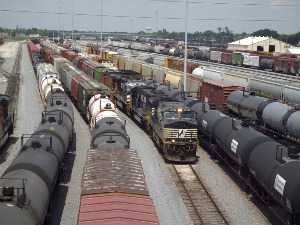
|
| Conrail, 1974 |
Essentially, the transaction was to trade Conrail stock for the debt represented by bondholders of the bankrupt railroads; a swap of equity for debt. Hidden in these bankruptcy proceedings was the elimination of many of the union rules that had been so burdensome. For consolation, the unions got a promise of jobs for at least some of their members, and the satisfaction of gloating that the bondholders ("speculators") had been stripped. The bondholders wanted the Tucker Act applied, which is to say the right to sue the U.S. Government later if the true value of the stock had been seriously misjudged. The situation was very bleak. Conrail probably couldn't survive, and its stock would probably prove to be worthless. The Penn Central trustees were particularly dismayed at the possibility that there would be continuing losses after the settlement ("erosion"), which Penn Central bondholders would be forced to cover by further reducing their share of the already miserable residuals. For Congress to force bondholders into such coerced backing of a venture they definitely felt was doomed, amounted to a government seizure of their property without just recompense. It would thus be a violation of the Fifth Amendment of the Constitution which contains a clause prohibiting what are known as "private takings". Meanwhile, the country was approaching an economic train wreck.
The Supreme Court had sympathy for Penn Central's argument and did find that a Tucker appeal should be available, a second bite at the apple, so to speak. Largely unspoken was the recognition that some weakening of union power was essential for even a hope of survival of the freight industry; so some conflicting language in the 1973 Act about Tucker appeals was -- sort of ignored. But later events showed the union work rules really had been critical to getting the railroads into the mess, and so successful agreements were reached at this moment of despair which never would have been agreed to if the true facts had been predicted. Railroad management, of course, contended that the work rules had been crippling them. But that appeared to be self-serving and the stock market largely ignored it.
But some remarkable men were put in charge of Conrail. They moved with remarkable speed to cut the size of train crews and otherwise remove a century of make-work rules. The quantity of freight cargo in 2010 is the same as that moved in 1974, but the workforce is reduced by 75%. Conrail became profitable, further mergers of national freight lines were negotiated, and it turns out that if someone had forced you to accept some Conrail stock in return for near-worthless bonds, you would have been a very lucky person.
| Posted by: service | May 8, 2012 9:51 AM |
69 Blogs
Cultural Imperialism
 Southwest Airlines
Southwest Airlines
Convention Center
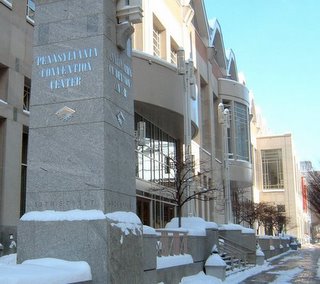 Bismarck once said that making laws was like making sausage, and maybe that's true of making convention centers, too.
Bismarck once said that making laws was like making sausage, and maybe that's true of making convention centers, too.
The Birthplace of Radio
 Right here, folks, it started right here.
Right here, folks, it started right here.
Priceless Art as Mass Entertainment
The major art museums are becoming display galleries for traveling masterpieces. It's a major undertaking.
Whigs, Slaves, and Tariffs
 The city evolved from a little country town to a big modern city by adding waves of new immigrants. Obviously, there had to be a succession of upheavals in sociology, politics and economics, step after step.
The city evolved from a little country town to a big modern city by adding waves of new immigrants. Obviously, there had to be a succession of upheavals in sociology, politics and economics, step after step.
Alexander Hamilton, Celebrity
 He had the kind of taudry private life and flashy public behavior that Philadelphia will only tolerate in aristocrats, sometimes.
He had the kind of taudry private life and flashy public behavior that Philadelphia will only tolerate in aristocrats, sometimes.
After the Convention:Hamilton and Madison
 Two of the main authors of the Federalist Papers -- and hence of the Constitution -- ultimately proved to be acting on entirely different sets of principles, aiming for widely different goals.
Two of the main authors of the Federalist Papers -- and hence of the Constitution -- ultimately proved to be acting on entirely different sets of principles, aiming for widely different goals.
Parliament Provokes a Revolution
 King George III personifies what angered the American colonists, but his Ministries acting through Parliament took the actual steps to agitate matters.
King George III personifies what angered the American colonists, but his Ministries acting through Parliament took the actual steps to agitate matters.
Reflections on Swensen
A private two-way conversation.
The Jews in Colonial Philadelphia
 Sephardic Jews came to Philadelphia quite early as part of New Amsterdam, with a second influx when the British occupied New York. They seem to have played an important role in financing the Revolution.
Sephardic Jews came to Philadelphia quite early as part of New Amsterdam, with a second influx when the British occupied New York. They seem to have played an important role in financing the Revolution.
BEA Monitors the Economy
 Thebusiness world is cyclic, and dispairs deeply when the trend is down. The Bureau of Economic Analysis seems to be very good at predicting turn arounds.
Thebusiness world is cyclic, and dispairs deeply when the trend is down. The Bureau of Economic Analysis seems to be very good at predicting turn arounds.
Corrupt and Contented
Pennsylvania elects judges, and that is slightly worse than appointing them.
Economics of La Cosa Nostra
 Organized crime in Philadelphia has always seemed a little quaint. The most famous local godfather seems to have designed an organization that made lots of money without annoying the public.
Organized crime in Philadelphia has always seemed a little quaint. The most famous local godfather seems to have designed an organization that made lots of money without annoying the public.
Insuring the Uninsured is Not Entirely a Health Issue
 The health industry resents its unwelcome role as a political tool in the tensions between labor shortages on the one hand, and unemployment on the other.
The health industry resents its unwelcome role as a political tool in the tensions between labor shortages on the one hand, and unemployment on the other.
Friends of Boyd
 The last movie palace in Philadelphia is either ready for restoration, or the wrecking ball.
The last movie palace in Philadelphia is either ready for restoration, or the wrecking ball.
Central Bankers Refine the Art of Diplomacy
 Currencies once failed because big issues like the gold standard hadn't been addressed by cabinet ministers. Now they are likely to fail because central bankers can't keep up with technical events.
Currencies once failed because big issues like the gold standard hadn't been addressed by cabinet ministers. Now they are likely to fail because central bankers can't keep up with technical events.
U.S. and E.U. Exchange Experiences (1)
 The European Union follows the American example. ...
The European Union follows the American example. ...
Compromise Outside the Borders of a Debate
 .....Break a deadlock by seemingly unrelated trade-offs.
.....Break a deadlock by seemingly unrelated trade-offs.
Big Pharma Loses Momentum
 The stock market has been unkind to major drug manufacturers lately. A venture capitalist thinks that will be good for foreign firms, small niche firms, and wellness care.
The stock market has been unkind to major drug manufacturers lately. A venture capitalist thinks that will be good for foreign firms, small niche firms, and wellness care.
Globalizing Real Estate
 For many centuries, the defining financial problem has boiled down to a search for a way to translate real estate wealth into something more portable. Globalization is largely this same problem in a larger form.
For many centuries, the defining financial problem has boiled down to a search for a way to translate real estate wealth into something more portable. Globalization is largely this same problem in a larger form.
No Laborer Left Behind
 Expanding prestige universities to fill American academic demands, unexpectedly provoke inflation obscured by illegal immigration.
Expanding prestige universities to fill American academic demands, unexpectedly provoke inflation obscured by illegal immigration.
Immigration
 The United States government makes several trillion dollars profit on immigration, through a jaw-cracker called seigniorage.
The United States government makes several trillion dollars profit on immigration, through a jaw-cracker called seigniorage.
Quakerism and the Industrial Revolution
 The Industrial Revolution extended over two centuries and was more important than all the wars, governments, and agitations of its time. Quakerism began at the same time, in the same place. Was that only coincidence?.
The Industrial Revolution extended over two centuries and was more important than all the wars, governments, and agitations of its time. Quakerism began at the same time, in the same place. Was that only coincidence?.
Herbert Hoover, Mining Engineer
 Herbert Clark Hoover was a Quaker, an outstanding executive, a hero of famine relief, a loyal Republican, and President of the United States elected by a landslide vote, then defeated by one. But above all, he was a mining engineer.
Herbert Clark Hoover was a Quaker, an outstanding executive, a hero of famine relief, a loyal Republican, and President of the United States elected by a landslide vote, then defeated by one. But above all, he was a mining engineer.
Africa Comes to the Schuylkill
 African oil, refined in Philadelphia, supplies 2/3 of the gasoline on the East Coast.
African oil, refined in Philadelphia, supplies 2/3 of the gasoline on the East Coast.
Hayek Confronts Keynes
 The influence of Austrian economist Friedrich von Hayek is slowly winning out over the views of the English economist Maynard Keynes, even though both of them are dead. Which is worse, inflation or depression?
The influence of Austrian economist Friedrich von Hayek is slowly winning out over the views of the English economist Maynard Keynes, even though both of them are dead. Which is worse, inflation or depression?
Picking Up the Usual Suspects
 When the U.S. President plans to change health care, everyone involved in healthcare gets excited. Some want to resist change, some want to exploit it, but everyone wants to have influence.
When the U.S. President plans to change health care, everyone involved in healthcare gets excited. Some want to resist change, some want to exploit it, but everyone wants to have influence.
Equal Pay for Equal Work
 Sometimes the representatives of political interest groups try, just a little too hard.
Sometimes the representatives of political interest groups try, just a little too hard.
Drexel and Morgan, Investment Bankers
 When America was the wild, wild, West, Anthony Drexel anticipated international developing country funds, by over a century.
When America was the wild, wild, West, Anthony Drexel anticipated international developing country funds, by over a century.
Be Careful What You Wish For
 After the Clinton Health Plan of 1993 fizzled, major employers, pushed their employees into managed care. The negative reaction to HMOs was as unambiguous as it was unexpected -- we hate it.
After the Clinton Health Plan of 1993 fizzled, major employers, pushed their employees into managed care. The negative reaction to HMOs was as unambiguous as it was unexpected -- we hate it.
Computerizing Medical Care
 Healthcare is mainly information processing, but utilizing computers has been a disappointment. Be prepared for high costs and continuing disappointment for decades to come.
Healthcare is mainly information processing, but utilizing computers has been a disappointment. Be prepared for high costs and continuing disappointment for decades to come.
Healthcare Reform: Looking Ahead (3)
 If radical new proposals for health care reform appear in the next few years, they are likely to originate in Detroit.
If radical new proposals for health care reform appear in the next few years, they are likely to originate in Detroit.
Money Bags
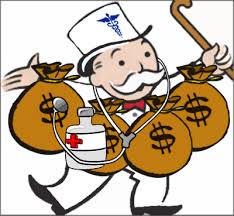 When Medicare started it was chaos, worse confounded.
When Medicare started it was chaos, worse confounded.
Immigration and Universal Health Insurance
 How can we give health insurance to illegal immigrants?
How can we give health insurance to illegal immigrants?
Quaker Efficiency Expert: Frederick Winslow Taylor 1856-1915
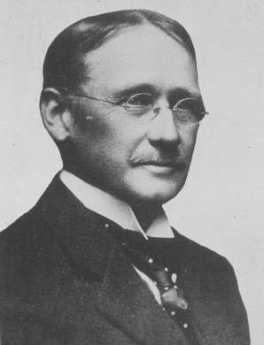 A rich Germantown Quaker boy became the world's symbol of the efficiency expert with a stop-watch, hated by Labor Unions but admired by Lenin and Stalin. He enriched the Midvale Steel Company with his invention of high-speed steel but was fired by Bethlehem Steel for eliminating too many employs. 000..0ees. Peter Drucker placed him in the class of innovators beside Darwin and Freud.
A rich Germantown Quaker boy became the world's symbol of the efficiency expert with a stop-watch, hated by Labor Unions but admired by Lenin and Stalin. He enriched the Midvale Steel Company with his invention of high-speed steel but was fired by Bethlehem Steel for eliminating too many employs. 000..0ees. Peter Drucker placed him in the class of innovators beside Darwin and Freud.
The Inky
 The Philadelphia Inquirer had a new, local, management. We wished it well.
The Philadelphia Inquirer had a new, local, management. We wished it well.
Stephen Girard, Compulsive Gambler
 The richest men in early America had an astonishing characteristic in common. Once they got to the top, they often gambled their whole fortunes on a venture which either busted them or made them incredibly richer.
The richest men in early America had an astonishing characteristic in common. Once they got to the top, they often gambled their whole fortunes on a venture which either busted them or made them incredibly richer.
OUR NICE HOUSING BOOM COLLAPSES
 Politicians will assign blame for the housing boom-and-bust, but they should look at themselves. Which is worse, "red-lining" or "stupid loans"?
Politicians will assign blame for the housing boom-and-bust, but they should look at themselves. Which is worse, "red-lining" or "stupid loans"?
Port of Philadelphia
 The Port of Philadelphia has access to six U.S. Senators from its surrounding states, but the price to be paid is endless political wrangling.
The Port of Philadelphia has access to six U.S. Senators from its surrounding states, but the price to be paid is endless political wrangling.
Detroit Makes, Philadelphia Takes
 The heap of crushed auto bodies at the foot of Philadelphia's Platt Bridge is an important part of the regional economy.
The heap of crushed auto bodies at the foot of Philadelphia's Platt Bridge is an important part of the regional economy.
Dog Days
 Hunting rabbits with a pack of French hounds scarcely sound like a matter to agitate the Pennsylvania Legislature and its Governor, so maybe something else is afoot.
Hunting rabbits with a pack of French hounds scarcely sound like a matter to agitate the Pennsylvania Legislature and its Governor, so maybe something else is afoot.
Gallatin Part II
 When Jefferson won the deadlocked election of 1800, Albert Gallatin was the obvious choice for Treasury Secretary. But having destroyed Hamilton's Bank, he had the humiliating duty to reverse position to fight the War of 1812. A five-act play, with duels.
When Jefferson won the deadlocked election of 1800, Albert Gallatin was the obvious choice for Treasury Secretary. But having destroyed Hamilton's Bank, he had the humiliating duty to reverse position to fight the War of 1812. A five-act play, with duels.
Gloomy Future for Banks
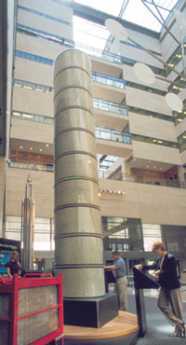 Banks pay depositors modest interest rates, lending to borrowers at higher ones. Bank reserves grow from that difference; survival depends on enough reserves to ride out exceptional situations. Profit is what is left.
Banks pay depositors modest interest rates, lending to borrowers at higher ones. Bank reserves grow from that difference; survival depends on enough reserves to ride out exceptional situations. Profit is what is left.
Exit, Pursued by a Bear
 Its medical school consumes 75% of Penn's budget, causing a lot of difficulty for the rest of the University.
Its medical school consumes 75% of Penn's budget, causing a lot of difficulty for the rest of the University.
Report Identity Theft to the Secret Service
 Identity theft is now under the jurisdiction of the U.S. Secret Service.
Identity theft is now under the jurisdiction of the U.S. Secret Service.
Commercial Academic Think Tank
 There are universities and there are think tanks. Philadelphia has at least one commercial consulting firm which combines elements of both.
There are universities and there are think tanks. Philadelphia has at least one commercial consulting firm which combines elements of both.
War Dance
 The Iroquois had politics figured out long before the White Man arrived
The Iroquois had politics figured out long before the White Man arrived
Curing Stagflation

Roebling
 Some millionaires of the 19th Century are called Robber Barons, but the Roeblings deserve to be called Titans of Industry.
Some millionaires of the 19th Century are called Robber Barons, but the Roeblings deserve to be called Titans of Industry.
Rise and Fall of Books
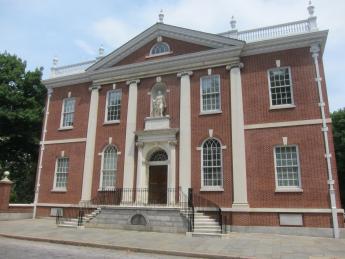 The The Director of America's first library sees books as mainly a 19th Century phenomenon.
The The Director of America's first library sees books as mainly a 19th Century phenomenon.
Buying Corporate America with Cheap Money
 Threat of recession-induced America to reduce interest rates, and thus to cheapen the dollar. The rest of the world seizes the opportunity to buy huge American corporations on the cheap.
Threat of recession-induced America to reduce interest rates, and thus to cheapen the dollar. The rest of the world seizes the opportunity to buy huge American corporations on the cheap.
John Head, His Book of Account, 1718-1753
 The equivalent of the rosetta stone for colonial commerce had been sitting on George Vaux's shelf for six generations.
The equivalent of the rosetta stone for colonial commerce had been sitting on George Vaux's shelf for six generations.
New Museum of Chemical Heritage
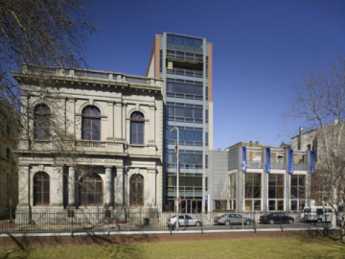 There's a stunning new museum on Chestnut Street, right across the street from Carpenters Hall. It's intended to convince everybody that chemistry is fascinating, particularly those who incline to doubt it.
There's a stunning new museum on Chestnut Street, right across the street from Carpenters Hall. It's intended to convince everybody that chemistry is fascinating, particularly those who incline to doubt it.
Mercantilism Dies Hard
 Diplomacy has been described as war by other means. It's possible to regard both war and diplomacy as economics by other means, a general attitude called mercantilism.
Diplomacy has been described as war by other means. It's possible to regard both war and diplomacy as economics by other means, a general attitude called mercantilism.
Merging Cities With Their Suburbs
 When middle-sized cities are thriving and growing, they tend to want to annex neighboring districts. Their newspapers are ecstatic about it.
When middle-sized cities are thriving and growing, they tend to want to annex neighboring districts. Their newspapers are ecstatic about it.
Philadelphia City-County Consolidation of 1854
 Prior to 1854, Philadelphia City was one of twenty-nine political entities within Philadelphia County. After that, it became one big city without suburbs. Growth pressure now reverses toward suburbs without a city. Political boundaries should thus shift inwardly.
Prior to 1854, Philadelphia City was one of twenty-nine political entities within Philadelphia County. After that, it became one big city without suburbs. Growth pressure now reverses toward suburbs without a city. Political boundaries should thus shift inwardly.
Philadelphia City Controller
 A City Controller is expected to criticize the city's administration. Alan Butkovitz does his duty.
A City Controller is expected to criticize the city's administration. Alan Butkovitz does his duty.
Windmill Electricity
 There isn't a windmill within a hundred miles of Philadelphia, but wind power is being actively promoted.
There isn't a windmill within a hundred miles of Philadelphia, but wind power is being actively promoted.
GIC in Paris
 The Global Interdependence Council (GIC) visited the Banque de France in May 2008.
The Global Interdependence Council (GIC) visited the Banque de France in May 2008.
Country Auction Modernized
 On Fairgrounds Road, in the Quaker farmlands of Bucks County, efficiency and computerized streamlining are nibbling at the enduring customs of country auctions.
On Fairgrounds Road, in the Quaker farmlands of Bucks County, efficiency and computerized streamlining are nibbling at the enduring customs of country auctions.
Re-Doing Dilworth Plaza
 Plans are afoot to rearrange the whole focus of center-city Philadelphia, by merging the transportation network around City Hall, and changing the walking patterns. Dilworth Plaza is in the center of it all.
Plans are afoot to rearrange the whole focus of center-city Philadelphia, by merging the transportation network around City Hall, and changing the walking patterns. Dilworth Plaza is in the center of it all.
SEPTA's Long Term Planning
 SEPTA is slowly making progress, but it's a struggle, every step of the way.
SEPTA is slowly making progress, but it's a struggle, every step of the way.
Go to Delaware, Elephants?
 It's about a 20-minute commute from Delaware to Philadelphia, with a big difference in estate taxes. Moving from New Jersey to Delaware would double that difference.
It's about a 20-minute commute from Delaware to Philadelphia, with a big difference in estate taxes. Moving from New Jersey to Delaware would double that difference.
Urban Transportation
 The industrial revolution made cities grow, and thus made mass transit desirable. The flight to the suburbs then made mass transit attractive only to urban politicians.
The industrial revolution made cities grow, and thus made mass transit desirable. The flight to the suburbs then made mass transit attractive only to urban politicians.
Paying For College - II
 As college education strives to be universal, forcing a few prosperous students to subsidize many needy ones becomes unsustainable. Colleges must devise better tuition systems before somebody else does it for them.
As college education strives to be universal, forcing a few prosperous students to subsidize many needy ones becomes unsustainable. Colleges must devise better tuition systems before somebody else does it for them.
Marcellus Shale Gas: Good Thing or Bad?
 There's a gold rush, in gas not gold, in Pennsylvania. What are the unintended consequences?
There's a gold rush, in gas not gold, in Pennsylvania. What are the unintended consequences?
Selling Entire Towns
 Some builders build whole towns without houses and then sell them to custom home builders.
Some builders build whole towns without houses and then sell them to custom home builders.
Selection of Constitutional Rights for the Bill of Rights
 James Madison tried to preserve the Union by allowing states some latitude in enforcing civil rights. Eventually, we got a Civil War, a weakening of state legislatures, massive black migration to northern cities, and the Civil Rights Act. It's all about slavery is hard to eliminate.
James Madison tried to preserve the Union by allowing states some latitude in enforcing civil rights. Eventually, we got a Civil War, a weakening of state legislatures, massive black migration to northern cities, and the Civil Rights Act. It's all about slavery is hard to eliminate.
Cleaning Up The Railroad Mess 1974
 Bankrupting the nation's freight trains aren't as bad as an atomic explosion, but it's worse than the average catastrophe, and the Supreme Court was faced with fixing it.
Bankrupting the nation's freight trains aren't as bad as an atomic explosion, but it's worse than the average catastrophe, and the Supreme Court was faced with fixing it.